DEF 14A: Definitive proxy statements
Published on March 20, 2025
UNITED STATES
SECURITIES AND EXCHANGE COMMISSION
Washington, D.C. 20549
SCHEDULE 14A
Proxy Statement Pursuant to Section 14(a) of the
Securities Exchange Act of 1934 (Amendment No. )
☑ Filed by the Registrant
|
☐ Filed by a party other than the Registrant
|
CHECK THE APPROPRIATE BOX:
☐ Preliminary Proxy Statement
☐ Confidential, for Use of the Commission Only (as permitted by Rule 14a-6(e)(2))
☑ Definitive Proxy Statement
☐ Definitive Additional Materials
☐ Soliciting Material under §240.14a-12

(Name of Registrant as Specified In Its Charter)
(Name of Person(s) Filing Proxy Statement, if other than the Registrant)
PAYMENT OF FILING FEE (CHECK ALL BOXES THAT APPLY):
☑ No fee required
☐ Fee paid previously with preliminary materials
☐ Fee computed on table in exhibit required by Item 25(b) per Exchange Act Rules 14a-6(i)(1) and 0-11
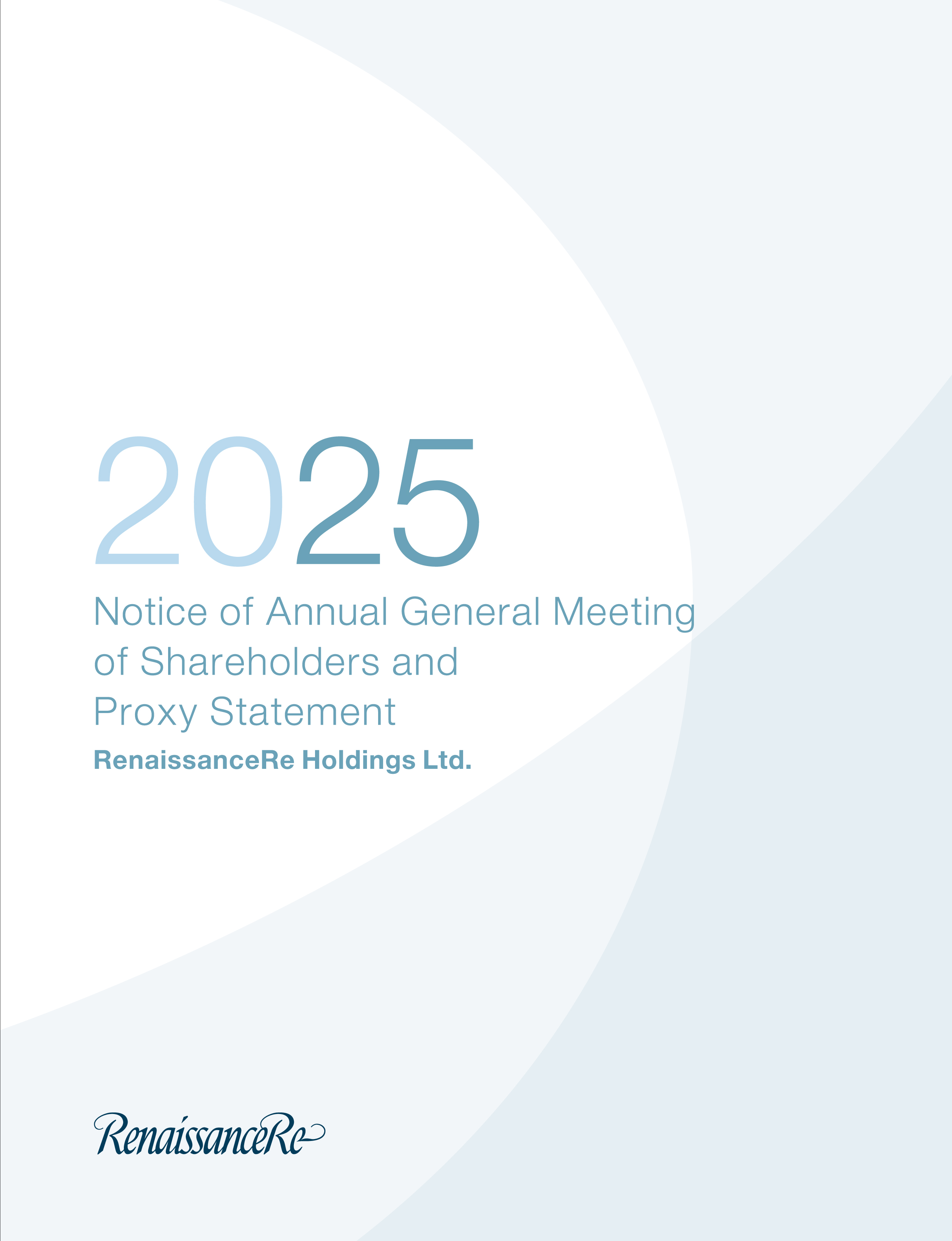
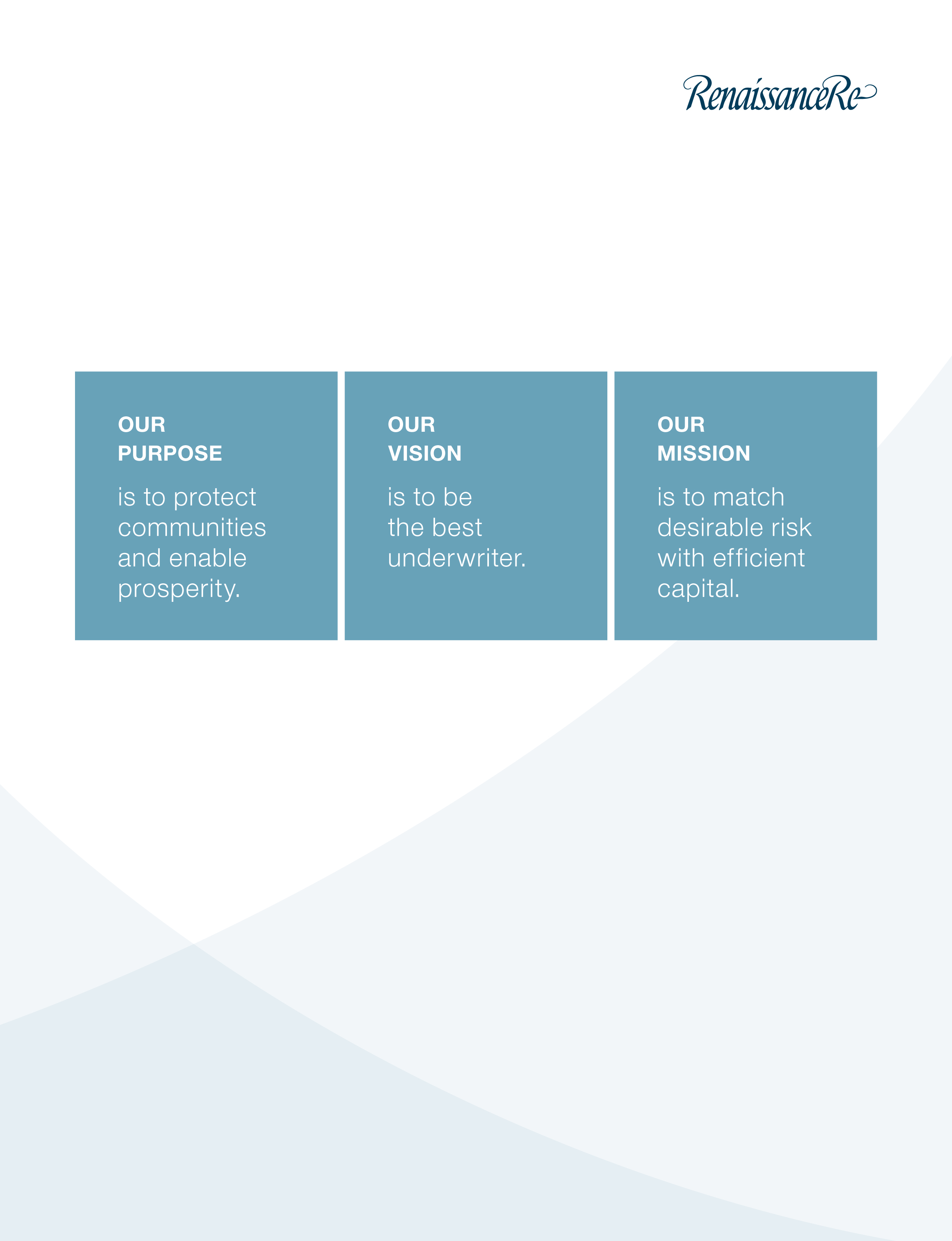
Table of Contents
Proposal 1: Election of One Class II and Four Class III Director Nominees Named in this Proxy Statement
|
||
A-1
|
1 Operating income available to common shareholders, operating return on average common equity, and growth in tangible book value per common share plus
change in accumulated dividends are non-GAAP financial measures. A reconciliation of non-GAAP financial measures is included in ‘‘Appendix A.’’
$1.8 billion
Net Income Available to Common
Shareholders
|
19.3%
Return on Average Common Equity
|
Successful Integration
of Validus and delivery of the
combined portfolio
|
Letter To Our Shareholders
Dear Fellow Shareholders,
In 2024, RenaissanceRe delivered strong financial results for our shareholders and advanced our strategy through focused execution
of the Validus integration. At the same time, throughout the year, we reinforced our leadership position, forming stronger customer
relationships, deepening our talent pool and building a larger, more resilient platform for assuming reinsurance risk.
The Board played an important role throughout, overseeing and stewarding the Company’s progress while ensuring compensation
remained aligned with results. We begin 2025 with a strong balance sheet, scale that provides us with great access to risk, increased
financial resilience from our Three Drivers of Profit and a culture that ensures we remain nimble, connected and supportive of
opportunities that enhance shareholder value.
Financial Results
In 2024, we generated net income available to common shareholders of $1.8 billion, operating income available to common
shareholders of $2.2 billion, return on average common equity of 19.3%, operating return on average common equity of 23.5%,
growth in book value per share plus change in accumulated dividends of 19.4% and growth in our primary metric – tangible book
value per common share plus change in accumulated dividends – of 26.0%.1 Each of our Three Drivers of Profit outperformed, and
benefited from the Validus acquisition:
•Underwriting: We generated $1.6 billion in underwriting income and an 83.9% combined ratio, an excellent result in a year with
over $140 billion of industry insured catastrophe losses. A highlight this year was successfully retaining the Validus portfolio, which
enabled us to grow our gross premiums written by 32.4%, to $11.7 billion. Much of this growth was in property catastrophe and
specialty lines of business, where we have seen the strongest returns.
•Fees: Our Capital Partners unit delivered exceptional fee income this year, growing by 38.0% to $326.8 million. Management and
performance fees were both up significantly, driven by growth in our joint venture vehicles and positive performance in the year.
•Investments: Our $32.6 billion investment portfolio provides a significant source of income. Net investment income grew steadily
throughout the year, increasing 32.0% and contributing $1.7 billion to our results.
Validus Integration and Capital Management
In November 2023, we successfully closed the Validus acquisition, rapidly accelerating our scale in an attractive market. This past
year, we were focused on renewing the combined portfolio and fully integrating Validus’ people, processes and systems into
RenaissanceRe. We are proud to have achieved our objectives through coordination and collaboration across the Company, resulting
in a larger underwriting portfolio and stronger partnerships with our customers, increased capital efficiency from consolidated balance
sheets and additional talent from new employees that have joined our team. Ultimately our actions this year demonstrated the benefit
of operating as an Integrated System and furthered RenaissanceRe’s position as a leading global reinsurer, able to holistically solve
our customers’ biggest risk challenges at scale.
Our strong earnings in 2024, on the back of a highly successful 2023, have put us in an exceptionally healthy capital and liquidity
KEY ACHIEVEMENTS IN 2024 |
position. We enhanced this position through the Validus acquisition, which freed up approximately $1 billion in capital both by
optimizing the renewal of the Validus portfolio across RenaissanceRe’s owned and Capital Partner vehicles and also by merging
Validus’ balance sheets into existing RenaissanceRe balance sheets. In line with our long track record of being good stewards of your
capital, we deployed a robust capital management strategy in 2024. Given our scale, and consistent contributions from each of our
Three Drivers of Profit, we increased our share repurchase authorization from $500 million to $750 million. In aggregate, throughout
2024, we repurchased over $677.6 million of our common shares and, subsequent to December 31, 2024 and through February 7,
2025, we repurchased an additional $227.7 million of our common shares.
19.4%
Change in Book Value per Common
Share plus Change in Accumulated
Dividends
|
$11.7 billion
Gross Premiums Written
|
Strong Performance
Across Three Drivers of Profit
|
Our People
We are proud of our talented and passionate team which made meaningful contributions to last year’s accomplishments. Guided by
our purpose - to protect communities and enable prosperity - and supported by our Integrated System – which is a cornerstone of our
collaborative culture - our people drive toward shared goals, to great success.
RenaissanceRe’s future success depends on maintaining the strength of our talented team and our Board and management work
together to ensure that we recruit, develop and retain the people and skill sets necessary to accomplish this important goal.
Specifically:
•Culture and Talent Development: We foster a highly collaborative culture that encourages the sharing of ideas and experiences
across the Company and in-role learning and development. We supplement this with more formal training and manager
development programs to equip our people with the technical skills and experience to do their jobs more effectively and achieve
their career goals.
•Pay for Performance: We believe our longstanding pay for performance philosophy encourages superior results from our people
and enables a high level of talent retention. In line with this, our strong financial results and strategic accomplishments in 2024
resulted in an above target annual incentive bonus.
•Succession Planning: We believe we have robust succession plans in place for leadership roles. The Board continues to actively
oversee this process, working with management to ensure this plan is updated and reviewed to reflect the evolving strategy and
increasing scale of the organization.
Our Board
We remain committed to preserving and enhancing the composition and talent of our Board. We continue to leverage the broad range
of skills, viewpoints and expertise of our Board members to execute and advance our strategy. Consistent with our Integrated System,
the Board and management have a productive and collaborative working relationship.
In November 2024, we were proud to welcome Loretta J. Mester to the Board. Loretta served as the former President of the Federal
Reserve Bank of Cleveland. Her extensive expertise with macroeconomic policy, global financial systems and management of
systemic risk will support the Board as we fulfill our oversight role and further RenaissanceRe’s purpose, mission and vision.
We would also like to thank Brian G. J. Gray, who retired from the Board in November 2024 after more than 11 years of distinguished
service. During his tenure, Brian chaired the Investment and Risk Management Committee and was a member of the Transaction and
Offerings Committees. Brian employed his extensive industry expertise to guide RenaissanceRe over a period of significant expansion
and we are grateful for his guidance.
In closing, thank you to our shareholders for your investment in, and commitment to, RenaissanceRe – we appreciate the trust you
place in us. We are proud of the results the entire RenaissanceRe team delivered in 2024 and believe that the actions we took this
year will support us in generating value for shareholders in the future.
March 20, 2025
Sincerely,
 |
 |
 |
 |
||||
James L. Gibbons
Non-Executive Chair of the
Board of Directors
|
Kevin J. O’Donnell
President and Chief
Executive Officer
|
||||||
Notice of Annual General
Meeting of Shareholders
 |
Date and Time
Tuesday, May 6, 2025
8:30 a.m. Atlantic Time
|
|
 |
Location
Renaissance House
12 Crow Lane
Pembroke HM 19
Bermuda
|
|
 |
Who Can Vote
Owners of our common
shares as of March 5,
2025 are entitled to vote
on all matters
|
|
How to Vote | ||
 |
Telephone
In the United States or
Canada you can vote
your shares by calling
1-800-690-6903
|
|
 |
Online
You can vote your
shares online at
www.proxyvote.com
You will need the 16-digit
control number on
the Notice of Internet
Availability or proxy card
|
|
 |
Mail
You can vote by mail by
marking, dating and
signing your proxy card or
voting instruction form and
returning it in the postage-
paid envelope provided
|
|
 |
QR Code
You can vote your shares
online with your tablet or
smartphone by scanning
the QR code
|
|
Voting Items |
Board Vote
Recommendation
|
For Further
Details
|
||
1. |
Election of one Class II and four
Class III director nominees named
in this proxy statement
|
 |
“FOR” each
director nominee
|
|
2. |
Advisory vote on the compensation
of our named executive officers
|
 |
“FOR” |
|
3. |
Approval of the appointment of
PricewaterhouseCoopers Ltd. as
our independent registered public
accounting firm for the 2025
fiscal year and the referral of the
auditor’s remuneration to the
Board
|
 |
“FOR” |
|
Shareholders will also act on other business that properly comes before
the meeting.
Please Vote Your Shares
We encourage shareholders to vote promptly, as this will save the expense of
additional proxy solicitation.
By Order of the Board of Directors,

Shannon Lowry Bender
Corporate Secretary
Important Notice of Internet Availability of Proxy Materials
This Notice of Annual General Meeting of Shareholders and related proxy
materials are being distributed or made available to shareholders beginning
on or about March 20, 2025. This proxy statement includes instructions on
how to access these materials (including our proxy statement and 2024
annual report to shareholders) online.
|
RenaissanceRe 2025 Proxy Statement | 1
|
Proxy Summary
The board of directors (the “Board”) of RenaissanceRe Holdings Ltd. (“RenaissanceRe,” the “Company,” “we,” “us,” or “our”) is
making this proxy statement and proxy available to you in connection with the solicitation of proxies for our 2025 Annual
General Meeting of Shareholders (the “Annual Meeting”).
This proxy summary highlights information contained elsewhere in this proxy statement. It does not contain all of the
information that you should consider, and you should read the entire proxy statement carefully before voting.
2 | RenaissanceRe 2025 Proxy Statement
|
Strategic, Operational and Financial Highlights
RenaissanceRe is a global provider of reinsurance and insurance. We provide property, casualty and specialty reinsurance,
and certain insurance solutions to customers, principally through intermediaries. Established in 1993, we have offices in
Bermuda, Australia, Canada, Ireland, Singapore, Switzerland, the U.K., and the U.S.
In 2024, we delivered strong strategic, operational and financial returns, and we believe that we have positioned ourselves to
produce superior returns for our shareholders over the long term. Our financial performance was outstanding, with strong
performance across many metrics, and we achieved several strategic milestones, including the integration of Validus.
Some of our strategic, operational and financial highlights for 2024 included:
STRONG STRATEGIC AND OPERATIONAL PERFORMANCE |
||||||||||||||||
Strong Strategic Plan
Performance
|
Underwriting
Accomplishments
|
Capital Management
Accomplishments
|
Strong Operational
Performance
|
|||||||||||||
•Consistent commitment
to our strategy as a
global reinsurer
•Strong performance
across Three Drivers
of Profit
•Continued to deliver on
our value proposition
composed of
leadership, expertise
and partnership
|
•Successful delivery of
the combined
RenaissanceRe and
Validus portfolio
•Combined ratio of
83.9%
•Proactive cycle
management
•Introduced new
underwriting
leadership roles to
support our increased
scale
|
•Prudent capital
management in volatile
environment
•Enhanced share
repurchase program
•Increased dividend for
thirtieth consecutive
year
|
•Completed integration
of Validus
•Continued to enhance
operations to execute
at scale
•Effective succession
planning and talent
management
|
|||||||||||||
2024 FINANCIAL PERFORMANCE |
||||||||||||||||||
•Net Income Available to
Common Shareholders
of $1.8 billion
•Operating Income
available to Common
Shareholders of $2.2
billion(1)
|
•Return on Average
Common Equity of
19.3%
•Operating Return on
Average of Common
Equity of 23.5%(1)
•Gross Premiums
Written of $11.7 billion
|
•Underwriting Income of
$1.6 billion
•Fee Income of $326.8
million
•Net Investment Income
of $1.7 billion
|
•Change in Book Value
per Common Share plus
Change in Accumulated
Dividends of 19.4%
•Change in Tangible
Book Value Per
Common Share plus
Change in Accumulated
Dividends of 26.0%(1)
|
|||||||||||||||
(1)Operating income available to common shareholders, operating return on average common equity, and change in tangible book value
per common share plus change in accumulated dividends are non-GAAP financial measures. A reconciliation of non-GAAP financial
measures is included in “Appendix A.”
RenaissanceRe 2025 Proxy Statement | 3
|
Our 2024 results demonstrate our strong performance over a long period, through challenging market conditions. Since Mr.
O’Donnell was named our Chief Executive Officer in 2013, we have performed well across our key financial metrics. He has
led the Company to become a diversified reinsurer with an innovative and flexible operating platform. From 2014 to 2024, our
total shareholder return grew at a compound annual growth rate (“CAGR”) of 10.9%, and our book value per common share
plus accumulated dividends reached $223.85 in 2024.
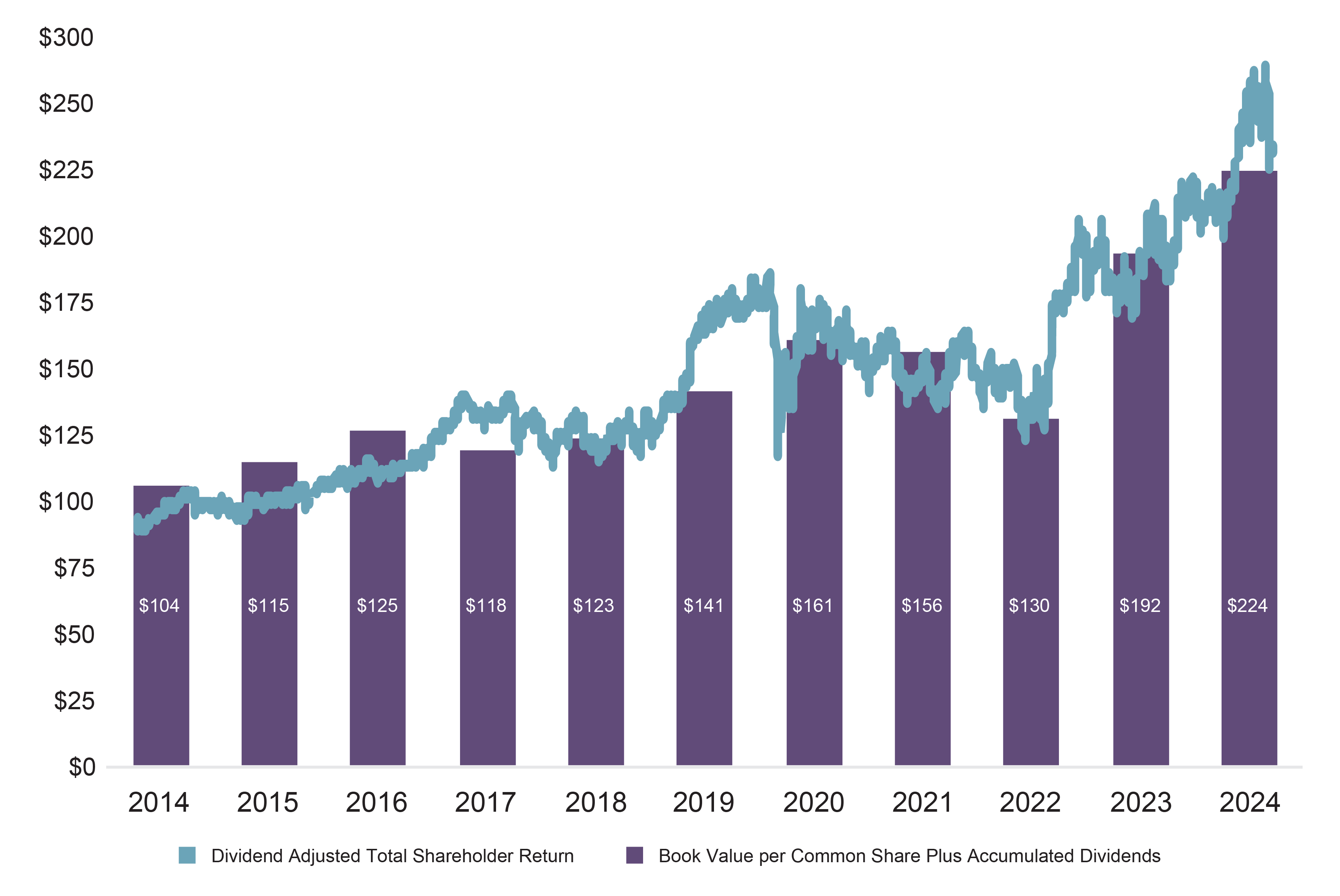

Total Shareholder Return CAGR: 10.9%(1)
(1)Total shareholder return is dividend adjusted and measured from January 2, 2014 through December 31, 2024.
Source: S&P Capital IQ database.
4 | RenaissanceRe 2025 Proxy Statement
|
Director Nominees and Continuing Directors
Committee Membership |
||||||||
Name and Primary Occupation |
Age |
Director
Since
|
AC |
CG&
HCMC
|
IRMC |
SC |
||
Class II Term Will Expire in 2027 |
||||||||
 |
Loretta J. Mester
 Former President and Chief Executive Officer of the
Federal Reserve Bank of Cleveland
|
66 |
2024 |
 |
||||
Class III Term Will Expire in 2028 |
||||||||
 |
Henry Klehm III
 Partner, Jones Day
|
66 |
2006 |
 |
||||
 |
Valerie Rahmani
 Former Chief Executive Officer, Damballa, Inc.
|
67 |
2017 |
 |
||||
 |
Carol P. Sanders
 Former Chief Financial Officer, Sentry Insurance
a Mutual Company
|
58 |
2016 |
 |
||||
 |
Cynthia Trudell
 Former Chief Human Resources Officer, PepsiCo, Inc.
|
71 |
2019 |
 |
||||
Class I Term Will Expire in 2026 |
||||||||
 |
David C. Bushnell
 Retired Chief Administrative Officer, Citigroup Inc.
|
70 |
2008 |
 |
||||
 |
James L. Gibbons
 Chairman, Harbour International Trust Company Limited
|
61 |
2008 |
 |
||||
 |
Shyam Gidumal
 Former President and Chief Operating Officer, WeWork Inc.
|
65 |
2022 |
 |
||||
 |
Torsten Jeworrek
 Former Member of the Board of Management Munich
Reinsurance AG
|
63 |
2023 |
 |
 |
|||
Class II Term Will Expire in 2027 |
||||||||
 |
Duncan P. Hennes
 Co-Founder and Managing Member, Atrevida Partners, LLC
|
68 |
2017 |
 |
||||
 |
Kevin J. O’Donnell
President and Chief Executive Officer,
RenaissanceRe Holdings Ltd.
|
58 |
2013 |
 |
||||
Director Nominees
Continuing Directors
 |
Independent |
AC |
Audit Committee |
|
 |
Chair |
CG & HCMC |
Corporate Governance and Human Capital Management Committee |
|
 |
Member |
IRMC |
Investment and Risk Management Committee |
|
SC |
Standing Committee |
|||
RenaissanceRe 2025 Proxy Statement | 5
|
Board Snapshot
Independence
91%
Independent
1 |
Not Independent |

10 |
Independent |
Board Refreshment
9 Years
Average Tenure
3 0 to 5 Years
4 6 to 10 Years
4 > 10 Years
New Directors in the
Last 3 Years
3


Diversity
45%
Diverse

1 |
Racially /
Ethnically Diverse
|
4 |
Gender Diverse |
Age
65
Average
2 < 60
3 61 to 65
6 > 65

Key Skills and Experience
 |
Actuarial |
 |
Corporate Governance |
 |
Data Analytics /
Digital
|
 |
Executive Management |
 |
Financial & Audit |
 |
International |
 |
Investments /
Asset Management
|
 |
Macroeconomic Policy |
 |
Public Company
Executive
|
 |
(Re)insurance
Operations
|
 |
Risk / Compliance /
Regulation
|
 |
Strategic Transactions |
 |
Sustainability |
 |
Talent /
Human Capital
|
 |
Technology /
Cybersecurity
|
 |
Underwriting |
6 | RenaissanceRe 2025 Proxy Statement
|
Corporate Governance Highlights
Our Board is comprised almost entirely of independent directors with a wide range of professional experience and has
consistently implemented corporate governance best practices to ensure that we serve the long-term interests of our
shareholders.
Board Independence and Composition |
||
•Independent Chair
•Fully independent principal committees
•Executive sessions of solely independent directors
•Rigorous director evaluation and selection criteria to enhance Board effectiveness and refreshment
•Refreshment of directors, committee membership and select chair rotations in 2023 and 2024
•Consideration of Board candidates with diverse characteristics, backgrounds and perspectives, including skills,
experience, race, gender and ethnicity
•In 2024, performed both internal and independent third-party board assessment processes
|
||
Active Oversight |
||
•Board oversight of strategic planning and enterprise-wide risk management, including climate change and insurance risk
as key financial risks
•Active shareholder engagement program, including participation of independent directors
•Robust Code of Ethics and Conduct (“Code of Ethics”) for all directors and employees
•Board and committee oversight of key sustainability, diversity, equity and inclusion (“DEI”) and corporate social
responsibility (“CSR”) initiatives
•Audit Committee responsible for risks related to cybersecurity
•Chief Executive Officer succession planning and management development pipeline
|
||
Shareholder Alignment |
||
•Majority vote standard for uncontested director elections
•Meaningful share ownership guidelines for all directors and named executive officers, with policy change in 2024 to not
count unearned performance shares toward equity ownership value
•Anti-hedging, anti-pledging, compensation clawback and insider trading policies
•At-risk pay as a percentage of total annual target compensation is 87% for our Chief Executive Officer and ranges from
76% to 80% for our other named executive officers
•Pay-for-performance philosophy guides executive compensation decisions
•Regular assessment of composition of peer groups
•Mix of financial performance metrics and strategic goals and objectives in our compensation plan measure financial
success of our business while balancing risk and reward and driving achievement of strategic goals
|
||
RenaissanceRe 2025 Proxy Statement | 7
|
Executive Compensation Highlights
Our executive compensation program is designed to support our long-term strategy and risk management practices, align the
interests of our shareholders and executives, and encourage operational and financial consistency over the market cycles and
earnings volatility that are inherent and unique to our industry.
2024 Compensation Snapshot
A significant portion of our annual target executive compensation is at-risk and/or performance-based, with a mix of
quantitative and qualitative metrics that we believe aligns the interests of our executives with our shareholders and rewards
our Chief Executive Officer and other named executive officers for delivering strong performance on our strategic plan without
incentivizing excessive risk taking. The Corporate Governance and Human Capital Management Committee (the “Governance
and Human Capital Committee”) evaluates and sets performance goals under our executive compensation program which are
designed to be rigorous, with the goals set at the time of grant for all performance-based compensation. The link between pay
and performance and the components and outcomes of our executive compensation program for 2024 are discussed in detail
in the “Compensation Discussion and Analysis” section of this proxy statement.
2024 Annual Target Pay Mix*
The annual target pay mix for our Chief Executive Officer and each of our other named executive officers for 2024 was:
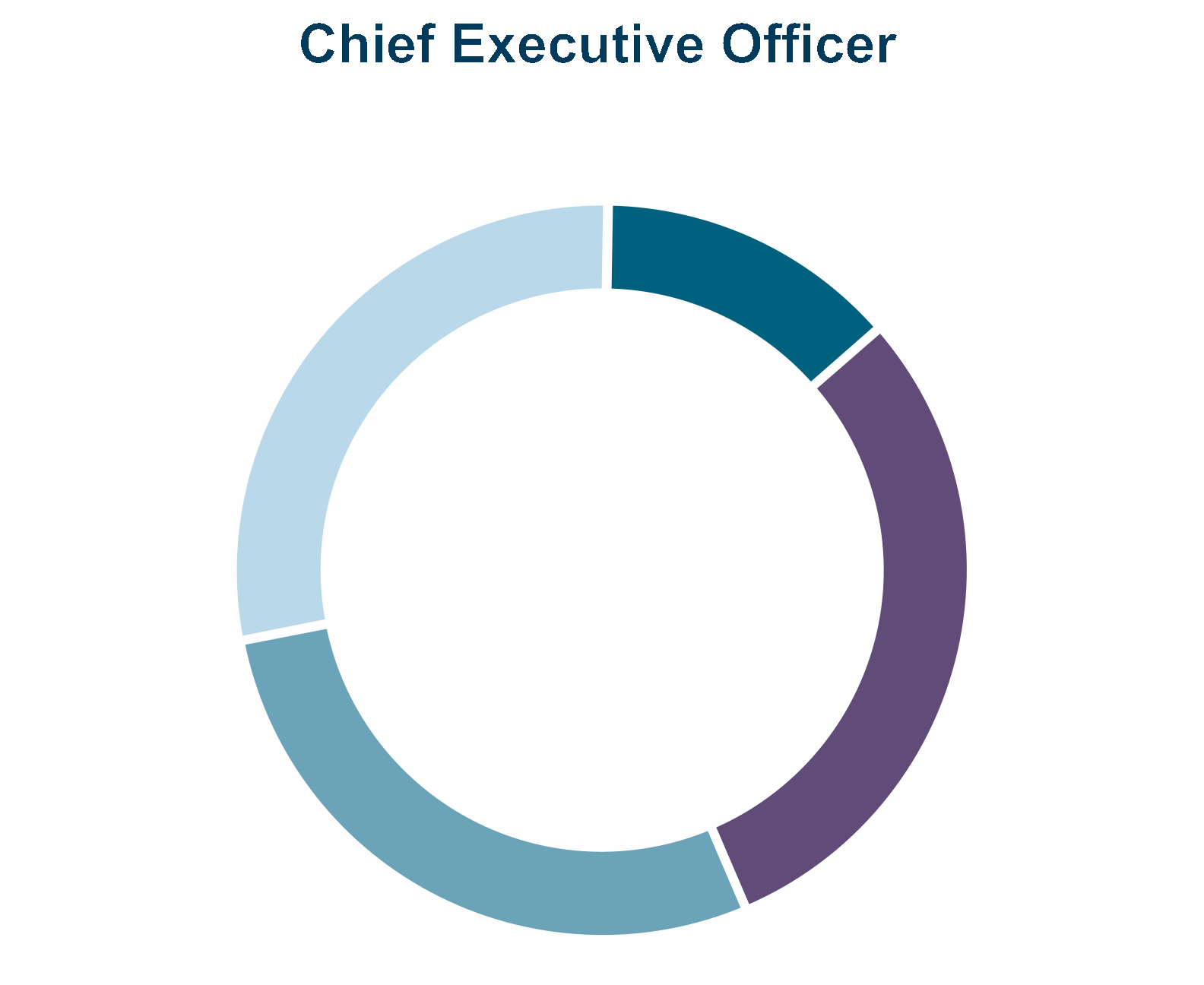
13% |
Salary |
30% |
Annual Incentive
Bonus
|
28% |
Time Vested
Restricted
Shares
|
28% |
Performance
Shares
|

87%
At-Risk

20-24%
|
Salary |
30-35%
|
Annual Incentive
Bonus
|
21-25%
|
Performance
Shares
|
21-25%
|
Time Vested
Restricted
Shares
|

76-80%
At-Risk
*Due to rounding, percentages may not total precisely.
8 | RenaissanceRe 2025 Proxy Statement
|
Shareholder Engagement
We recognize the value of engaging in a dialogue with our shareholders to solicit their views and input. Our ongoing
engagement program includes interactions led by our investor relations team with many of our largest shareholders, and
regular participation by members of our executive leadership in investor conferences. Members of senior management also
engage with investors in meetings that are primarily focused on corporate governance, executive compensation and
sustainability topics, some of which are led by an independent director. Our Board appreciates the insights gained in these
discussions and receives a summary of shareholder engagement, including shareholder feedback, at each quarterly Board
meeting. The Governance and Human Capital Committee is also provided with a detailed summary of direct shareholder
communications at each quarterly committee meeting.
Since our 2024 Annual Meeting, we reached out to a broad group of our shareholders | ||||||
We engaged with shareholders representing approximately 68% of shares outstanding.
| ||||||
We engaged with shareholders in multiple ways |
We discussed a number of topics with shareholders |
|||||
■Purpose and long-term strategy
■Financial performance and Three Drivers of Profit
■Capital management framework
■Integration of Validus
■Executive compensation, including program design and
shareholders’ rationale for advisory say-on-pay votes
■Board composition and refreshment
■Sustainability strategy
■Human capital and culture
|
||||||
 |
 |
 |
||||
One-on-one
meetings
|
Quarterly financial
results conference
calls
|
Annual Letter to
Shareholders
|
||||
 |
 |
|||||
Regular participation in
industry conferences
|
Press releases and our
investor website
|
|||||
At our May 2024 Annual General Meeting of Shareholders (the “2024 Annual Meeting”), we were pleased by the high level of
support for our directors but acknowledge the 72% support for our say-on-pay proposal was below our traditionally high level
of support. As part of our ongoing shareholder engagement program, in the months following our 2024 Annual Meeting, we
reached out to a broad group of shareholders and met with shareholders representing approximately 68% of shares
outstanding, including shareholders who voted against our say-on-pay proposal.
In these meetings, we sought feedback on a range of topics, including our compensation program, with a focus where
applicable, on understanding the rationale for voting against our say-on-pay proposal and what actions could be taken to
address concerns. Overall, our discussions were open, wide-ranging and informative, encompassing our strong performance
over the past year, progress on the successful integration of Validus, updates on market outlook, executive compensation, our
approach to board structure and composition, and our approach to sustainability, including climate risk and human capital
management.
RenaissanceRe 2025 Proxy Statement | 9
|
Below are the most common topics discussed in engagements and the Board’s response or actions taken:
Board Composition and Refreshment: |
||
■We discussed the composition of our Board and the Board’s evolution over the past several years. The Board is
committed to ongoing refreshment and to adding individuals with relevant experience and backgrounds.
■This past November, Loretta. J. Mester was appointed to the Board. Dr. Mester is a recognized thought leader and a
seasoned executive with nearly four decades of experience setting economic policy and is the third new director that
we have added to the Board in the past three years.
|
||
Rationale for Classified Board: |
||
■We discussed the Board’s classified structure, and the Board continues to believe that the current classified structure
provides considerable value to the Company and our shareholders due to the continuity and stability that it creates.
This is especially true given the complexities, volatility and highly regulated nature of our business and the industry in
which we operate.
■The Board has enhanced the disclosure around its rationale for maintaining its classified structure in the “Board
Structure and Engagement” section.
|
||
Limited Use of One-Time Awards: |
||
■Shareholders, including both those who voted for and against our say-on-pay proposal, generally expressed
satisfaction with the Governance and Human Capital Committee’s overall approach to executive compensation, and an
understanding of the rationale for granting the performance recognition award in November 2023, particularly given our
long history of responsible compensation practices and responsiveness to shareholder concerns. Those shareholders
who voted against our say-on-pay proposal shared that the primary reason for doing so was the principle around the
use of a one-time award.
■In response, the Governance and Human Capital Committee affirmed that it does not intend to make any additional
one-time awards absent exceptional circumstances.
|
||
Enhancements to Disclosure on Management-Related Performance Goals: |
||
■Shareholders requested greater insight into the key objectives that comprise the management-related performance
goals in the performance recognition award made to Mr. O’Donnell in November 2023.
■We have provided additional context and disclosure in this proxy statement around the progress made on those key
objectives, including succession planning and talent development. See “Responding to Our Say-on-Pay Vote—
Enhancements to Disclosure on Management-Related Performance Goals” for additional information.
|
||
Simplification of Annual Incentive Bonus Design: |
||
■Over the past several years, including in the 2024 off-season, shareholder discussions have covered the performance
metrics used for our annual incentive bonus.
■In 2024, the Governance and Human Capital Committee modified the metrics and weightings for the annual incentive
bonus to better reflect our strategy and performance, align with market practice and shareholder feedback, and
address the decreased availability of comparable peers. These changes simplify the structure of the program by
eliminating relative metrics, streamlining financial metrics and increasing the weighting of financial metrics compared
to strategic metrics. See “Annual Incentive Bonus Design and Mechanics—2024 Design Change” for a fulsome
discussion of the changes to the annual incentive bonus design.
|
||
For more information on compensation changes made in response to shareholder feedback, please see “Shareholder Engagement.”
10 | RenaissanceRe 2025 Proxy Statement
|
Sustainability Highlights
Our commitment to sustainability matters has always been a central part of, and integrated with, our corporate strategy at
RenaissanceRe and remains a core area of focus. Our Board recognizes the importance of investing time and resources into
business practices that emphasize environmental sustainability and good corporate citizenship, and oversees internal
strategies and related activities through regularly scheduled reports by management to the Board and its committees
throughout the year.
Our sustainability strategy focuses on three core areas where we apply our core business strengths to make a meaningful
impact on society — promoting climate resilience, closing the protection gap, and inducing positive societal change:
 |
 |
For additional information
on our sustainability and
human capital
management activities,
see the “Sustainability”
section of our website, as
well as our Form 10-K.
|
|||
Promoting Climate
Resilience
|
Closing the
Protection Gap
|
Inducing Positive
Societal Change
|
|||
Developing and sharing
our skills and expertise
to help the world better
manage climate risk
|
Partnering to provide
sustainable risk
mitigation solutions for
those who are
vulnerable in society
|
Shaping a positive
environment for our
people and communities
|
|||
For more than 30 years, we have been a leader in understanding and modeling the impact of climate-related events.
We believe that the frequency and severity of natural catastrophes have increased due to human-driven climate change
and are focused on preventing and mitigating its impact on society.
Climate Leadership
•25+ years of leadership by our
dedicated team of scientists in
researching and modeling climate-
related risks
•Leveraging industry-leading
climate data and expertise and
integrating it holistically into our
enterprise-wide risk management
process and catastrophe models
•Long-standing member of
ClimateWise, an organization that
promotes a systematic response
to climate change across the
financial system, with our Chief
Executive Officer, Mr. O’Donnell
serving as the Chair of the
ClimateWise Insurance Advisory
Council since 2022
|
Responsible Investing
•Elimination of direct investments
in companies with (i) an MSCI
CCC rating, (ii) more than 10% of
revenues from thermal coal
mining, or (iii) high carbon
intensity (as measured by MSCI)
•Formal Responsible Investing
Policy
•Approximately 72% reduction in
carbon intensity of our corporate
credit and equity portfolios
between December 2020 and
December 2024
|
Environmental Footprint
•Dedicated internal Global Green
Group responsible for
consolidating environmental data
and advancing our operational
sustainability strategy
•Tracking and offsetting of our
estimated operational carbon
emissions
|
||
Promoting Climate Resilience
RenaissanceRe 2025 Proxy Statement | 11
|
We have a long track record of leadership in applying our risk expertise and leveraging our partnerships to increase the
economic resiliency of vulnerable communities. Reinsurance plays an important role in helping communities recover after a
natural disaster, and we have made significant commitments to reduce the protection gap and mitigate the impact of natural
disasters on populations and economies in the developing world. We have a dedicated global team focused on public sector
partnership activities to support our continued work in this space.
Resiliency and Risk Mitigation Leadership
•Leveraging our partnerships to increase the
economic resiliency of vulnerable communities
•Formal strategy and dedicated global team for our
public sector partnership activities
•Significant commitments to reduce the protection gap
and mitigate the impact of natural disasters
•Signatory of the UN Principles for Sustainable
Insurance
|
Industry Expertise at Local and Global Levels
•Long-standing role in the Insurance Development
Forum to increase global risk understanding
•Active member of the Sustainable Markets Initiative
Insurance Task Force to drive progress towards a
resilient and sustainable future
•Founding member of Lloyd’s Disaster Risk Facility to
address underinsurance, including an active role in
supporting parametric protection gap products
|
|
Closing the Protection Gap
Our employees are our most valuable asset, and we are committed to maintaining a culture that supports every one of them in
their personal and professional journey. We share a passion for solving our customers’ biggest challenges through a
collaborative and entrepreneurial culture that empowers employees and rewards creative thinking.
Investing in Our People
•Conducted employee engagement survey in 2023,
and leveraged insights to improve employee
satisfaction and engagement
•Investment in our employees’ professional
development and personal growth through skills-
based training, technical development and stretch
assignments
•Encouragement of open dialogue with employees and
regular “pulse” checks to measure satisfaction and
engagement
|
Supporting Our Communities
•Signatory of the UN Global Compact
•Long-standing dedication to community engagement
and charitable giving through employee matching and
corporate grants
•Global CSR strategy with a locally led philosophy so
that our employees can impact where they live
|
|
Inducing Positive Societal Change
12 | RenaissanceRe 2025 Proxy Statement
|
Corporate Governance
PROPOSAL 1 |
|||
Election of One Class II and Four Class III Director Nominees
Named in this Proxy Statement
|
|||
 |
The Board unanimously recommends that shareholders vote FOR the election of Dr. Mester, Mr. Klehm,
Dr. Rahmani, Ms. Sanders and Ms. Trudell.
|
||
Election of Directors
Our Amended and Restated Bye-laws (our “Bye-laws”) provide that the number of directors shall be determined by our Board
and shall be between eight and eleven members. Currently, that number has been fixed by the Board at eleven. The Board
consists of three classes, with directors of one class elected each year for terms extending to the annual general meeting of
shareholders held in the third year following their election.
The terms of our Class III directors will expire at the Annual Meeting. The Board, upon the recommendation of the Governance
and Human Capital Committee, has nominated Mr. Klehm, Dr. Rahmani, Ms. Sanders and Ms. Trudell for election as Class III
directors. If elected at the Annual Meeting, these Class III director nominees will serve until the expiration of their terms in
2028, or until their earlier resignation or removal.
Mr. Klehm, Dr. Rahmani, Ms. Sanders and Ms. Trudell were each last elected to the Board at our 2022 Annual General
Meeting of Shareholders.
The Board, upon the recommendation of the Governance and Human Capital Committee, has nominated Loretta J. Mester for
election as a Class II director. Dr. Mester was appointed by the Board in November 2024 to fill the vacancy created by the
retirement of Mr. Gray. If elected at the Annual Meeting, Dr. Mester will serve until the expiration of the term of the Class II
directors in 2027, or until her earlier resignation or removal.
Dr. Mester was identified as a potential director candidate by a former independent director of the Company through their
professional networks. The Governance and Human Capital Committee then undertook a comprehensive evaluation process
described below in the section “Selection and Nomination of Directors” and determined that she possessed a combination of
qualifications and experience that will contribute to the Board’s oversight duties, and was qualified under the Board’s criteria.
We have no reason to believe that any of the nominees will be unable or unwilling to serve if elected. However, if a nominee
becomes unable or unwilling to accept a nomination or election, the Board may select a substitute nominee and the common
shares represented by proxies may be voted for such nominee unless shareholders indicate otherwise.
Majority Vote Requirement
Each director nominee who receives a majority of the votes cast at the Annual Meeting will be elected as a director. However, if
a nominee fails to receive a majority of the votes cast at the Annual Meeting, such nominee will tender an irrevocable
resignation that will be effective upon the Board’s acceptance of such resignation, as codified in our Corporate Governance
Guidelines. Upon the submission of the resignation, the Governance and Human Capital Committee will promptly consider the
resignation and make a recommendation to the Board, and the Board will consider any relevant factors in deciding whether to
accept or reject the director’s resignation.
RenaissanceRe 2025 Proxy Statement | 13
|
Skills and Experience of Our Nominees and Continuing Directors
Each nominee has extensive business experience, education and personal skills that qualify him or her to serve as an effective
Board member. The specific experience and qualifications of the nominees are set forth below. We encourage you to read the
biographies of our nominees and continuing directors, as well as the discussion of our Board’s composition.
Alignment of Director and Director Nominee Skills and Strategy
RenaissanceRe is a global provider of reinsurance and insurance. Our mission is to match desirable risk with efficient
capital to achieve our vision of being the best underwriter. We believe that this will allow us to produce superior
returns for our shareholders over the long term, and to enable our purpose of protecting communities and enabling
prosperity. Our strategy focuses on operating as an integrated system of three competitive advantages: superior risk
selection, superior customer relationships and superior capital management.
Our Governance and Human Capital Committee has determined that each of our directors and director nominees
possess the appropriate skills and experiences individually to effectively oversee our business strategy on a collective
basis. As detailed in each director and director nominees’ biography below, our Board collectively leverages its
strength in the following areas:
|
|||||||||
 |
 |
 |
 |
 |
 |
 |
 |
||
Actuarial |
Corporate
Governance
|
Data
Analytics /
Digital
|
Executive
Management
|
Financial &
Audit
|
International |
Investments /
Asset
Management
|
Macroeconomic
Policy
|
||
 |
 |
 |
 |
 |
 |
 |
 |
||
Public
Company
CEO
|
(Re)Insurance
Operations
|
Risk /
Compliance /
Regulation
|
Strategic
Transactions
|
Sustainability |
Talent/Human
Capital
|
Technology /
Cybersecurity
|
Underwriting |
||
14 | RenaissanceRe 2025 Proxy Statement
|
Director Nominees
Class II Director (whose term, if elected, expires in 2027)
 |
Age: 66
Director Since: 2024
Committees: Investment
and Risk Management
|
Other Public Company
Boards
•None
Investment Company
Boards
•The Haverford Trust
Company
|
Loretta J. Mester
INDEPENDENT
Background and Qualifications
Loretta J. Mester served as the President and Chief Executive Officer of the Federal
Reserve Bank of Cleveland from 2014 until her retirement in 2024. Prior to joining the
Federal Reserve Bank of Cleveland, she served at the Federal Reserve Bank of
Philadelphia in a variety of roles, including executive vice president and director of
research. Dr. Mester has been an adjunct professor of finance at the Wharton School of
the University of Pennsylvania since 2001, and currently serves as a trustee of the
Cleveland Clinic, a director of the Council for Economic Education, a trustee of the Musical
Arts Association (Cleveland Orchestra), a founding director of the Financial Intermediation
Research Society, a member of the senior council of the Central Bank Research
Association, a member of the advisory board of the Financial Intermediation Network of
European Studies, and as a member of the Visa Economic Institute Advisory Council. Dr.
Mester is currently a member of the Board of Directors of The Haverford Trust Company,
an SEC registered investment advisor. Over the course of her career, Dr. Mester
participated in the formulation of U.S. monetary policy, engaged in the supervision and
regulation of commercial banks, and oversaw an organization that conducted economic
research, promoted community development and provided payment services to the U.S.
Treasury.
RenaissanceRe 2025 Proxy Statement | 15
|
Class III Directors (whose terms, if elected, expire in 2028)
 |
Age: 66
Director Since: 2006
Committees: Governance
and Human Capital
(Chair)
|
Other Public Company
Boards
•None
|
Henry Klehm III
INDEPENDENT
Background and Qualifications
Mr. Klehm has been a partner at the law firm Jones Day since 2008 and has been the
Practice Leader of the firm’s Securities Litigation and SEC Enforcement Practice since
January 2017. From 2002 to 2007, Mr. Klehm served as Global Head of Compliance for
Deutsche Bank, AG. Prior to joining Deutsche Bank, AG, Mr. Klehm served as Chief
Regulatory Officer and Deputy General Counsel at Prudential Financial from 1999 to
2002. Prior to joining Prudential Financial, Mr. Klehm served in various positions with the
U.S. Securities and Exchange Commission (the “Commission” or the “SEC”), including as
Senior Associate Director of the Northeast Regional Office. Mr. Klehm has extensive
experience counseling boards, corporations and financial institutions on a range of matters
including related to risk, compliance, regulation and corporate governance.
 |
Age: 67
Director Since: 2017
Committees: Audit
|
Other Public Company
Boards
•London Stock
Exchange Group, plc
(2017 to present)
|
Valerie Rahmani
INDEPENDENT
Background and Qualifications
Dr. Rahmani has more than 30 years of experience in the technology industry, including
more than 25 years at IBM, where she served in roles of increasing seniority across
multiple global business segments from 1981 to 2009, most recently as General Manager
of Internet Security Systems. Subsequent to her tenure at IBM, Dr. Rahmani was Chief
Executive Officer at Damballa, Inc., a privately held Internet security software company,
from 2009 to 2012. From 2017 to 2019, she served as the part-time head of the Innovation
Panel at Standard Life Aberdeen plc, a UK-based FTSE 100 global investment company.
She has served on the Board of the London Stock Exchange Group, plc since 2017, and
currently serves as a member of the Nomination Committee, Remuneration Committee
and Risk Committee. Previously, Dr. Rahmani served as a member of the boards of
directors of Elliot Opportunity II Corp. from 2021 to 2023, Computer Task Group,
Incorporated from 2015 to 2023, and Aberdeen Asset Management PLC from 2015 to
2017. Dr. Rahmani has significant experience as an executive and serving on public
company boards of directors, as well as expertise and knowledge related to technology,
technical risk management, and digital transformation.
16 | RenaissanceRe 2025 Proxy Statement
|
 |
Age: 58
Director Since: 2016
Committees: Audit (Chair)
|
Other Public Company
Boards
•Alliant Energy
Corporation
(2005 to present)
•First Business
Financial Services,
Inc. (2016 to 2024)
|
Carol P. Sanders
INDEPENDENT
Background and Qualifications
Ms. Sanders has served as the President of Carol P. Sanders Consulting, LLC, providing
consulting services to the insurance and technology industries, since June 2015. From
June 2013 until June 2015, she served as Executive Vice President, Chief Financial
Officer and Treasurer of Sentry Insurance Company. Previously she served as the
Executive Vice President and Chief Operating Officer of Jewelers Mutual Insurance
Company from November 2012 until June 2013, where she also served as Senior Vice
President, Chief Financial Officer and Treasurer from May 2011 until November 2012 and
as Chief Financial Officer and Treasurer from 2004 until May 2011, after holding a series
of positions of increasing responsibility in finance, accounting, treasury and tax. Ms.
Sanders is currently a member of the board of directors of Alliant Energy Corporation, a
public utility holding company, where she serves as the Lead Independent Director, Chair
of the Nominating and Governance Committee, and as a member of the Audit Committee
and the Executive Committee, and a member of the board of directors and Chair of the
Risk Committee of GuideOne Insurance Group, a mutual insurance company. Ms.
Sanders previously served on the board of directors of First Business Financial Services,
Inc., a registered bank holding company from 2016 until December 2024. She brings
significant experience related to strategic leadership, finance and audit, human capital
management and risk management to the Board.
 |
Age: 71
Director Since: 2019
Committees: Governance
and Human Capital
|
Other Public Company
Boards
•Canadian Tire
Corporation
(2019 to present)
|
Cynthia Trudell
INDEPENDENT
Background and Qualifications
Ms. Trudell has served as the sole principal of Trudell Human Capital Consulting, LLC
since 2017. From 2011 until her retirement in September 2017, Ms. Trudell served as
Executive Vice President and Chief Human Resources Officer of PepsiCo, Inc.
(“PepsiCo”). From 2007 through 2011, she served as Senior Vice President and Chief
Personnel Officer of PepsiCo. Prior to her tenure at PepsiCo, Ms. Trudell held a number of
executive operating and general management positions with General Motors Corporation
from 1981 to 2001, and Brunswick Corporation from 2001 to 2006, including chairwoman
and president of Saturn Corporation, president of IBC Vehicles and president of Sea Ray
Group. Since 2019, Ms. Trudell has served on the board of Canadian Tire Corporation, a
Canadian retail company publicly traded on the Toronto Stock Exchange, where she is
Chair of the Compensation Committee and a member of the Governance Committee.
From 2013 to 2019, she served as a member of the Defense Business Board, which
provides business advice to the U.S. Department of Defense. Previously, Ms. Trudell
served as a member of the boards of directors of ISS A/S from 2015 to 2023, The Pepsi
Bottling Group, Inc. from 2008 to 2010, Canadian Imperial Bank of Commerce from 2005
to 2008, and PepsiCo, Inc. from 2000 to 2007. Ms. Trudell brings significant experience
related to human capital management, executive leadership and strategy, and global
operations to the Board.
RenaissanceRe 2025 Proxy Statement | 17
|
Continuing Directors
The members of the Board whose terms do not expire at the Annual Meeting and who are not standing for election at this
year’s Annual Meeting are set forth below.
Class I Directors (whose terms expire in 2026)
 |
Age: 70
Director Since: 2008
Committees: Governance
and Human Capital
|
Other Public
Company Boards
•None
|
David C. Bushnell
INDEPENDENT
Background and Qualifications
Mr. Bushnell has served as the principal of Bushnell Consulting, a financial services
consulting firm, since 2008. Mr. Bushnell retired from Citigroup Inc. in 2007, after 22 years
of service. Mr. Bushnell served as the Senior Risk Officer of Citigroup from 2003 through
2007 and retired as Chief Administrative Officer in 2007. Following his retirement from
Citigroup, Mr. Bushnell served as a consultant to Citigroup until December 31, 2008.
Previously, Mr. Bushnell worked for Salomon Smith Barney Inc. (later acquired by
Citigroup) and its predecessors in a variety of positions, including as a managing director
and Chief Risk Officer. In addition to his board service on Cordia Bancorp Inc. (“Cordia”), a
public bank holding company, from 2011 to 2016, Mr. Bushnell served as Chief Risk
Officer of Cordia and its wholly owned subsidiary, Bank of Virginia, from 2011 until Cordia
was acquired in September 2016. Mr. Bushnell brings significant experience related to risk
management, operations, investments and asset management to the Board.
 |
Age: 61
Director Since: 2008
Committees: Standing
|
Other Public Company
Boards
•None
|
James L. Gibbons
INDEPENDENT NON-EXECUTIVE CHAIR OF THE BOARD
Background and Qualifications
Mr. Gibbons, a Bermudian citizen, is Executive Chairman of Harbour International Trust
Company Limited and the Treasurer, a Director and member of the Executive Committee
of Edmund Gibbons Limited (“EGL”). Mr. Gibbons also serves as a Director and member
of the Risk Committee of Clarien Bank Limited (“Clarien”), an international financial
company. He was also Non-Executive President of Bermuda Air Conditioning Limited
(“BACL”) through March 2019 and currently serves as a Director of BACL. Mr. Gibbons
served as Chair of Capital G Bank Limited from 1999 to 2013 and as President and Chief
Executive Officer of Capital G Limited from 1999 to 2010, prior to the change of name to
Clarien from Capital G in 2014. He also serves as an Honorary Trustee of the Bermuda
Underwater Exploration Institute. Mr. Gibbons has substantial expertise related to
executive management, and financial and audit skills, as well as the Bermuda business
and regulatory environment.
18 | RenaissanceRe 2025 Proxy Statement
|
 |
Age: 65
Director Since: 2022
Committees: Audit
|
Other Public Company
Boards
•None
|
Shyam Gidumal
INDEPENDENT
Background and Qualifications
From February 2020 to November 2021, Mr. Gidumal served as the President and Chief
Operating Officer of WeWork Inc. From March 2011 to June 2019, Mr. Gidumal served as
a Principal at Ernst & Young Global Limited, where he led the Consumer Products and
Retail segment. Over his career he has held several executive roles, including at
Worldcom (Asia), Acterna, Armstrong Furniture, and The Boston Consulting Group. Mr.
Gidumal has been a Member of the Board of Directors of the National Multiple Sclerosis
Society since 2014. Mr. Gidumal has over 35 years of experience in operational
leadership, digital transformation, and strategy development as a senior executive, board
member, private equity investor and advisor.
 |
Age: 63
Director Since: 2023
Committees: Investment
and Risk Management,
Standing
|
Other Public Company
Boards
•None
|
Torsten Jeworrek
INDEPENDENT
Background and Qualifications
From 2003 until his retirement in 2022, Dr. Jeworrek served as a Member of the Board of
Management and the CEO Reinsurance of Munich Reinsurance AG (“Munich Re”). As
CEO Reinsurance, Dr. Jeworrek was directly responsible for Reinsurance Strategy, Data
and Analytics, IT, Group Innovation, Internet of Things, Corporate Underwriting and Geo &
Climate Risks Research. Dr. Jeworrek joined Munich Re in 1990 as an underwriter, and
served in a variety of roles, including Head of Department for Financial Reinsurance from
1999 to 2001 and Head of P&C for Netherlands, Nordic countries, UK and Ireland from
2001 to 2003. Dr. Jeworrek has been a member of the Executive Board of the National
Academy of Science and Technology since 2023. Dr. Jeworrek brings significant
experience related to underwriting and risk management, data analytics and actuarial
knowledge to the Board.
RenaissanceRe 2025 Proxy Statement | 19
|
Class II Directors (whose terms expire in 2027)
 |
Age: 68
Director Since: 2017
Committees: Investment
and Risk Management
(Chair)
|
Other Public Company
Boards
•Citigroup Inc.
(2013 to present)
|
Duncan P. Hennes
INDEPENDENT
Background and Qualifications
Mr. Hennes has served as the Co-Founder and Managing Member of Atrevida Partners,
LLC (“Atrevida”) since 2007. Prior to co-founding Atrevida, he served as Co-Founder and
Partner of Promontory Financial Group from 1999 to 2006. Prior to that, Mr. Hennes
served in a number of senior executive positions at Bankers Trust Corporation, including
Executive Vice President in charge of Trading, Sales and Derivatives, and as the
Chairman of the Board of Oversight Partners I, the consortium that took control of Long
Term Capital Management, from 1987 to 1998. From 1998 to 1999 he was the Chief
Executive Officer at Soros Fund Management, LLC. Mr. Hennes is currently a member of
the Board of Directors of Citigroup Inc. (“Citigroup”), where he serves as the Chair of the
Risk Management Committee and the Compensation, Performance Management and
Culture Committee, and as a member of the Audit Committee and the Executive
Committee, and is also a member of the Board of Directors of Citibank, N.A., Citigroup’s
primary subsidiary. Mr. Hennes is an experienced financial services professional who has
significant expertise in the areas of financial services, risk management and regulatory
and compliance.
 |
Age: 58
Director Since: 2013
Committees: Standing
(Chair)
|
Other Public Company
Boards
•None
|
Kevin J. O’Donnell
CHIEF EXECUTIVE OFFICER
Background and Qualifications
Mr. O’Donnell has served as our Chief Executive Officer since July 2013 and as our
President since November 2012. Mr. O’Donnell has served in a number of roles since
joining the Company in 1996, including Global Chief Underwriting Officer, Executive Vice
President, Senior Vice President, Vice President and Assistant Vice President. Mr.
O’Donnell has also served as the Chair of ClimateWise since 2022, and as a member of
the U.S. Department of the Treasury Federal Advisory Committee on Insurance since
2023. He served as the Chair of the Global Reinsurance Forum from 2018 to 2020 and as
the Chair of the Association of Bermuda Insurers and Reinsurers in 2017 and 2018.
Through his roles at RenaissanceRe, Mr. O’Donnell has significant experience as a public
company chief executive officer and has extensive knowledge of the Company’s
operations, regulatory interaction, human capital management, strategy, and values and
culture.
20 | RenaissanceRe 2025 Proxy Statement
|
Board Composition and Effectiveness
We believe the Board benefits from taking a holistic approach to its composition and refreshment. Our Board values a mix of
new directors, who bring fresh perspectives, and longer-serving directors, who bring continuity and breadth of experience with
our business, strategies and risk management processes. Our Board has developed comprehensive and ongoing assessment
and succession planning processes and regularly reviews the biographical backgrounds and skills of its current members and
potential nominees in connection with its ongoing evaluation of Board composition and refreshment.
Achieving Board Effectiveness
•Rigorous director nominee evaluation and selection
criteria
•Commitment to source diverse Board candidates
•Annual Board self-evaluation and assessment of
individual directors
•Comprehensive director orientation and ongoing
education programs
|
Board Changes Over the Past Three Years
•Added three new directors
•Enhanced Board skill sets relating to sustainability,
human resources and cybersecurity
•Continued alignment with long-term strategy
|
|

Selection and Nomination of Directors
Director Nomination Process
The Governance and Human Capital Committee is responsible for identifying and recommending qualified candidates for
nomination to the Board.
Assess Board
Composition
|
•Governance and Human Capital Committee regularly assesses appropriate Board size and
composition
•Needs are determined based on current and evolving strategies, potential vacancies and
competencies, skills and experiences of the Board as a whole
|
Identify and Source
Candidates
|
•The Board is committed to expanding the pool from which it selects qualified director
candidates, and is focused on seeking candidates based on a comprehensive analysis of the
skills, qualifications, experience and attributes that are determined to best serve the Board
and the interests of stockholders
•Candidate recommendations may come from current or former Board members, management,
search firms, shareholders or other sources
•Utilization of non-traditional methods to identify a diverse pool of candidates from which new
director nominees may be selected
|
Select Director
Nominees
|
•The Governance and Human Capital Committee reviews candidates to ensure fit with the
needs and collegiality of the Board
•Aim to find a diverse combination of qualities and experience that will complement and
contribute to the competencies of the Board as a whole
•Interviews by the Governance and Human Capital Committee members, Non-Executive Chair
and other members of the Board are conducted before the full Board votes to nominate
|




RenaissanceRe 2025 Proxy Statement | 21
|
Assessment of Board Composition
The Board conducts a comprehensive analysis of the skills, qualifications, experience and attributes that are determined to
best serve the Board and the interests of stockholders. When identifying and considering potential director nominees and
evaluating the current composition of our Board, the Governance and Human Capital Committee focuses on:
•the composition and competencies of our Board as a whole,
•how the traits possessed by individual directors and director nominees complement one another,
•the ability of the current and proposed members to operate collegially and effectively, and
•the intersection of these factors with our current strategy, operational plans and oversight requirements.
The Board also considers outside commitments of directors, including service on other boards and board committees, in
assessing their ability to serve on the Board and committees of the Board.
Director Qualifications
As discussed in our Corporate Governance Guidelines, we do not set specific criteria for directors, but believe that candidates
should show evidence of leadership in their particular field and have broad experience and the ability to exercise sound
business judgment. In selecting directors, the Board generally seeks a combination of qualities and experience that will
contribute to the exercise of the duties of the Board, including active or former chief executive or senior officers of major
complex businesses, leading academics and entrepreneurs. The factors considered by the Governance and Human Capital
Committee when evaluating individual director nominees include:
 |
 |
 |
 |
Personal and professional
ethics, integrity and values
|
Business acumen, leadership
qualities and record of
accomplishment
|
Compatibility with the existing
Board composition
|
Commitment to serve on
our Board for a potentially
extended period of time, in
light of the market cycles
and earnings volatility that
characterize our industry
|
 |
 |
 |
 |
Independence, including the
ability to represent all of our
shareholders and other key
stakeholders without any
conflicting relationship with
any particular constituency
|
Professional experience and
industry expertise considering
our evolving strategic and
operational plans over time
|
Ability and willingness to
devote sufficient time to
carrying out Board duties
and responsibilities fully and
effectively, particularly as a
result of our Bermuda
headquarters location
|
Other attributes of the
candidate, our business and
strategic conditions, and
external factors that the
Governance and Human
Capital Committee deems
appropriate
|
The Governance and Human Capital Committee has the discretion to weigh these, and other, factors as it deems appropriate.
The relative importance of these factors may vary from candidate to candidate, depending on our evolving circumstances, and
no particular criterion is necessarily applicable to all prospective nominees.
Our Board believes that the backgrounds and qualifications of the directors and director nominees, both individually and
considered as a group, should provide a diverse range of viewpoints, backgrounds, skills, experiences, expertise, and abilities
that will allow the Board to fulfill its responsibilities, taking into account our evolving strategic direction and needs. The
Governance and Human Capital Committee evaluates and discusses these factors at both the Board and committee levels
when carrying out its director selection, recruitment and nomination obligations and also when assessing the performance of
current directors. This assessment is undertaken at least annually.
22 | RenaissanceRe 2025 Proxy Statement
|
The Governance and Human Capital Committee may use search firms to identify potential candidates to stand for election to
the Board. Our Corporate Governance Guidelines formalize our commitment to source Board candidates that have a range of
viewpoints, backgrounds, skills, experiences and expertise, and other diverse characteristics.
Annual Board Assessment and Evaluation
The Board recognizes that a robust and constructive evaluation process is an essential part of good corporate governance and
Board effectiveness. Pursuant to its charter, the Governance and Human Capital Committee has responsibility for oversight of
the Board’s annual overall effectiveness reviews, review of individual director performance and similar matters. In 2024, we
performed both internal and independent third-party board assessment processes.
Multi-Faceted Evaluation Process
Individual Interviews
by Board Chair
|
At the direction of the Governance and Human Capital Committee, our Non-Executive Chair of the Board
facilitates the annual assessment of the effectiveness of the Board and each principal committee of the
Board. The Non-Executive Chair of the Board conducts individual interviews with Board members and
management, facilitating reviews of individual director effectiveness, as well as of the Board as a whole.
|
Periodic Use of
Independent Third
Parties
|
From time to time, the Board engages independent third parties to review the Board’s practices and
procedures and assess its effectiveness.
|
Committee Self-
Evaluations
|
Each principal committee of the Board performs a comprehensive annual self-assessment as part of the
Board’s overall governance effectiveness review and assessment.
|
Board Chair
Assessment
|
The Chair of the Governance and Human Capital Committee, along with the Board members, reviews the
performance of the Non-Executive Chair of the Board.
|
Incorporation of
Feedback
|
Results are compiled and discussed by the Board and each committee, and changes in practices,
Board composition and procedures are recommended by the Governance and Human Capital
Committee as necessary.
|








Director Orientation and Continuing Education
Our Governance and Human Capital Committee oversees the orientation process for new directors. Each new director and
new member of a Board committee participates in a comprehensive orientation program run by management. The orientation
includes presentations by senior management to familiarize the new director with our strategic plan, significant accounting and
risk management factors unique to our business, compliance programs, Code of Ethics and other relevant topics.
We encourage our directors to participate in continuing education programs and reimburse them for reasonable expenses
associated with third-party training programs relating to our business, industry or the discharge of Board duties. We also
provide ongoing education programs on topics relevant to RenaissanceRe and our industry as part of regular Board and
committee meetings, and directors are invited and encouraged to visit our offices to meet with management.
RenaissanceRe 2025 Proxy Statement | 23
|
Director and Director Nominee Independence
The Governance and Human Capital Committee has reviewed the independence of each of our current directors and director
nominees and affirmatively determined that each of Drs. Rahmani, Jeworrek and Mester, Mses. Sanders and Trudell and
Messrs. Bushnell, Gibbons, Gidumal, Hennes and Klehm are independent. Mr. O’Donnell is not independent because of his
employment as our President and Chief Executive Officer.
The New York Stock Exchange (the “NYSE”) listing standards require that a majority of our directors be independent. For a
director to be considered independent, the Board must determine that the director does not have any direct or indirect material
relationship with us either directly or as a partner, shareholder or officer of an organization that has a relationship with us. Our
Corporate Governance Guidelines provide that a majority of our directors will meet the NYSE’s listing standards regarding
independence criteria and set forth additional parameters that the Board uses to determine director independence, which we
believe are more stringent than the independence requirements in the NYSE listing standards. In addition, the Board considers
all relevant facts and circumstances known or reported to it in making independence determinations.
In particular, when making its independence determinations, the Governance and Human Capital Committee considered the
following relationships and determined that none of the directors or director nominees involved had a material relationship with
us as a result of these relationships. Mr. Hennes serves as a director of Citigroup. We have current and historical financial
relationships with Citigroup and its subsidiaries and affiliates, including Citigroup acting in manager roles in several of our
securities offerings over the last few years and being a party to letter of credit facilities with us. Ms. Sanders serves as a
director of GuideOne Insurance. From time to time, we have entered into reinsurance contracts with GuideOne, all in the
ordinary course of business on terms available to similarly situated parties. Mr. Gibbons is the Treasurer and a director of EGL,
the parent company of a number of varied businesses in Bermuda, including Coralisle Group Ltd. (“Coralisle”), and a director
of BACL. We have entered into reinsurance contracts with Coralisle which are described under “Certain Relationships and
Related Transactions” below. In addition, we have other immaterial business relationships with a variety of the other
businesses owned by EGL and BACL, relating primarily to local services and procurement in Bermuda, for which we paid
these entities a total of approximately $171,461 in 2024. Mr. Gibbons is not directly involved in the management of Coralisle or
any of the other businesses owned by EGL or BACL with which we do business, and all of the transactions were entered into
in the ordinary course of business on terms available to similarly situated parties. Furthermore, the EGL and BACL entities did
not make payments to, or receive payments from, us in an amount which, in any of the last three fiscal years, exceeded the
greater of $1 million or 2% of EGL’s or BACL’s consolidated gross revenues.
Shareholder Nomination Process
Candidates recommended by shareholders for nomination to the Board will be considered and evaluated by the Governance
and Human Capital Committee using the same process and criteria that we use to evaluate other candidates, assuming the
proper procedures for shareholder nominations are followed. The Governance and Human Capital Committee will consider
nominees to the Board recommended by no fewer than 20 shareholders holding in the aggregate not less than 10% of the
outstanding paid-up share capital of RenaissanceRe. Any shareholder recommendation must be sent to our Corporate
Secretary not less than 60 days prior to the scheduled date of the annual general meeting of shareholders and must set forth
for each nominee: (i) the name, age, business address and residence address of the nominee; (ii) the principal occupation or
employment of the nominee; (iii) the class or series and number of shares of capital stock of RenaissanceRe that are owned
beneficially or of record by the nominee; and (iv) any other information relating to the nominee that would be required to be
disclosed in a proxy statement or other filing required to be made in connection with solicitations of proxies for election of
directors pursuant to Section 14 of the U.S. Securities Exchange Act of 1934, as amended (the “Exchange Act”) and the rules
and regulations promulgated thereunder. The written notice must also include the following information with regard to the
shareholders giving the notice:
•the name and record address of such shareholders;
•the class or series and number of shares of capital stock of RenaissanceRe that are owned beneficially or of record by such
shareholders;
•a description of all arrangements or understandings between such shareholders and each proposed nominee and any other
person (including his or her name and address) pursuant to which the nomination(s) are to be made by such shareholders;
•a representation that such shareholder intends to appear in person or by proxy at the annual general meeting of
shareholders to nominate the persons named in its notice; and
•any other information relating to such shareholder that would be required to be disclosed in a proxy statement or other filing.
24 | RenaissanceRe 2025 Proxy Statement
|
Such notice must be accompanied by a written consent of each proposed nominee to be named as a nominee and to serve as
a director if elected. The Governance and Human Capital Committee may refuse to acknowledge the nomination of any person
not made in compliance with the foregoing procedure.
The Board’s Role and Key Responsibilities
Strategic Oversight
Our Board believes that long-range strategic issues should be discussed and reviewed at regular Board meetings. Our
Corporate Governance Guidelines provide that the Board review and critique our strategic plan at least annually, with quarterly
reviews of performance in comparison to the financial plan. Senior management and the full Board engage in long-term
strategy discussions at least annually, and the Board and committees regularly receive updates from business function leaders
on our performance against our tactical plans.
Our strategic plan drives the Board’s goal setting in many areas. For example, the goals of each Board committee are tied to
the achievement of the strategic plan and the Governance and Human Capital Committee determines and measures executive
compensation against the achievement of strategic goals and objectives.
Risk Oversight
We consider enterprise-wide risk management to be a key strategic objective and believe that our enterprise-wide risk
management processes and practices help to identify potential events that may affect us; quantify, evaluate and manage the
risks to which we are exposed; and provide reasonable assurance regarding the achievement of corporate objectives. For
each identified and measured risk, we have identified (i) a day-to-day owner and management response, (ii) a process for
monitoring and reporting on the risk, (iii) a senior management committee, and (iv) Board and/or committee oversight. We
believe that this risk management process, along with our culture and focus on enterprise-wide risk management, ensures
effective risk oversight by our Board.
RenaissanceRe 2025 Proxy Statement | 25
|
Risk Management Process
BOARD |
||||
•The Board is responsible for overseeing enterprise-wide risk management and is actively involved in the monitoring of risks that
could affect us.
•The members of the Board have direct access to, and receive regular reports from, the senior executives and other officers
responsible for identifying and monitoring our risks, and coordinating enterprise-wide risk management, including our Group Chief
Risk Officer, Chief Portfolio Officer, Group Chief Underwriting Officer, Chief Financial Officer and Group General Counsel, each of
whom reports directly to our Chief Executive Officer, as well as other senior personnel such as our Chief Investment Officer, Chief
Compliance Officer, Chief Accounting Officer, Global Corporate Controller and Head of Internal Audit. The Board also receives
regular reports from the Operational Risk and Resilience Committee, which includes members of senior management, compliance
professionals and others and oversees policies and procedures relating to accounting, financial reporting, internal controls, legal
and regulatory matters, and complex transactions, among other matters.
•The Board delegates certain of its risk management responsibilities to its committees as set forth in the committee charters and
described under “Committees of the Board” below, with key risks set forth below.
•The Non-Executive Chair of the Board participates in meetings of each committee from time to time on an ex officio basis and
monitors the identification of risks or other matters that might require cross-committee coordination and collaboration or the
attention of the full Board.
|
||||

COMMITTEES |
||||||||
•Each committee regularly receives and discusses materials from the other committees, and we believe this allows the directors to
be aware of the various risks across the Company.
•Each committee performs a comprehensive annual self-assessment as part of the Board’s overall governance effectiveness review
and assessment, which reflects the committees’ evaluation of our corporate risk management practices and, if applicable, the
identification of potential new oversight needs in light of changes in our strategy, operations or business environment.
•Each committee considers the self-assessment and identified new oversight needs when conducting their annual charter reviews
and recommending changes to the charters.
|
||||||||
Key Risks Overseen |
||||||||
Audit Committee |
Governance and
Human Capital
|
Investment and Risk
Management Committee
|
||||||
•Financial statements integrity and
reporting
•Cybersecurity and business
continuity
•Legal, regulatory and compliance
•Tax compliance
•Financial risk management
|
•Executive and employee
compensation
•Succession planning (executive and
director)
•DEI, talent development, CSR and
similar ESG matters
•Governance structure and
processes
•Shareholder concerns
|
•Enterprise-wide risk management
framework
•Investment strategies and risk limits
•Key financial risk or exposures
(including climate risk)
•Insurance risk
•Capital and liquidity requirements
|
||||||

MANAGEMENT |
||||
•At least annually, our Group Chief Risk Officer presents a comprehensive risk management overview to the Board to demonstrate
management coverage and Board oversight of significant identified risks. This overview outlines our procedures for the identification
and measurement of, response to, and monitoring and reporting of risk.
•Management representatives from our risk, legal, regulatory, compliance, human resources, treasury, finance, investments,
reserving, information security, accounting and internal audit functions:
◦Regularly report to the Board and each committee at quarterly scheduled sessions, including at least annually to the Governance
and Human Capital Committee regarding any potential risks of our compensation policies and practices; and
◦Separately meet with, and are interviewed by, our committees in executive sessions.
|
||||
26 | RenaissanceRe 2025 Proxy Statement
|
Board Oversight of Sustainability
We have an integrated approach to sustainability governance, with cross-collaboration among our Board committees and
management. Our Board and its committees are actively engaged in the oversight of sustainability initiatives and our
management provides regular reports on progress and developments.
The Governance and Human Capital Committee, pursuant to its charter, is charged with overseeing, monitoring and reviewing
our sustainability policies, programs and practices. This oversight includes health and safety, DEI and related matters. Our
dedicated sustainability team reports to the Governance and Human Capital Committee regularly, and to the full Board at least
annually, on our sustainability initiatives and progress on implementation of our sustainability strategy. In addition, the
Governance and Human Capital Committee is actively engaged in the oversight of our employees, work environment, DEI
initiatives and compensation practices, and receives regular updates from management on progress and developments, and
our executive management team and Governance and Human Capital Committee receive regular reports on progress against
our annual human resources tactical plans.
The consideration of the impacts of climate change is integral to our enterprise-wide risk management process. Certain
aspects of sustainability are monitored by the full Board or other committees. For example, the Investment and Risk
Management Committee is charged with overseeing key financial risks, such as the financial risk of climate change. We have
been progressively integrating the consideration of the financial risk of climate change into our governance frameworks, risk
management processes and business strategies over the past several years.
Cross-Committee Risk and Strategy Oversight Collaboration
At their quarterly meetings, each committee reviews and discusses its current and future agendas in the context of our
strategic plan and any new Company, industry or market information and identifies matters that should be discussed with other
committees or the full Board. In addition, each principal committee reports to the full Board at each quarterly Board meeting.
Our Audit, Governance and Human Capital, and Investment and Risk Management Committees coordinate their oversight of
our financial and operating risks and routinely collaborate to address specific matters requiring coordination and cross-
committee oversight. We believe that these collaborative efforts sustain high levels of enterprise-wide risk management and
facilitate sound corporate governance.
Executive Succession Planning
We believe that executive succession planning and leadership development are critical to our long-term success and are key
to ensuring effective risk oversight and execution of our strategy. Our succession planning programs are designed to ensure
that the Board has appropriate oversight. On behalf of the Board, our Governance and Human Capital Committee collaborates
with our Chief Executive Officer in the development and monitoring of our programs for long-term executive succession,
generally on a quarterly basis. Our Board, in coordination with the Governance and Human Capital Committee, also maintains
an emergency succession plan, which is intended to enable us to respond quickly to unexpected vacancies to maintain the
continuity of our business operations and minimize disruptions.
The Governance and Human Capital Committee dedicates at least one meeting each calendar year to an in-depth review of
talent development plans, including development plans for internal succession candidates and identification of potential
external succession candidates. Updates to the executive succession plan are made as necessary.
To further support the succession planning process, the Governance and Human Capital Committee is regularly presented
with information on the Company’s employee population, ranging from the results of engagement surveys to detailed
succession plans for senior or critical roles. Together, the Chief Executive Officer, the Chief Human Resources Officer and the
management governance committee identify individuals who they believe have demonstrated potential to grow into senior
executive positions and review these individuals with the Governance and Human Capital Committee. The careers of these
individuals are monitored to ensure that over time they have appropriate exposure both to the Board and to our business.
These individuals interact with our Board in various ways, including through participation in Board meetings and other Board-
related activities and meetings with individual directors. The Governance and Human Capital Committee regularly briefs the full
Board on these matters and has overseen recent changes to our leadership structure in accordance with our succession
planning processes.
RenaissanceRe 2025 Proxy Statement | 27
|
Board Structure and Processes
Our Commitment to Effective Corporate Governance
Our Board and management have a strong commitment to effective corporate governance. We believe we have a
comprehensive corporate governance framework which takes into account applicable regulatory requirements and best
practices. The key components of this framework are set forth in the following documents:
•our Bye-laws;
•our Corporate Governance Guidelines;
•our Code of Ethics;
•our Audit Committee Charter;
•our Governance and Human Capital Committee Charter; and
•our Investment and Risk Management Committee Charter.
The Board regularly reviews corporate governance developments and modifies our Corporate Governance Guidelines, Code
of Ethics, committee charters and key Board practices when it believes modifications are warranted. A copy of each of these
documents is published on our website at www.renre.com under “Investors—Corporate Governance,” except our Bye-laws,
which are filed with the SEC and can be found on the SEC website at www.sec.gov. Each of these documents is available in
print to any shareholder upon request.
Governance Highlights
•In November 2024, we streamlined our Board committee structure by combining multiple special purpose
committees into one Standing Committee with authority to approve certain strategic transactions, securities offerings
and transition matters.
•In November 2024, we appointed Loretta J. Mester to the Board, our third new director in the last three years,
illustrating our commitment to board refreshment and thoughtful Board composition as the Company evolves.
•In November 2023, we updated our Audit Committee Charter to formalize the Audit Committee’s responsibility for
oversight of risks related to cybersecurity.
|
||
Code of Ethics
Our Code of Ethics applies to all of our directors and employees, including our principal executive officer, principal financial
officer and principal accounting officer, and all of our employees performing financial or accounting functions. Our Code of
Ethics is available without charge on our website, www.renre.com, under “Investors—Corporate Governance.” We will also
provide a printed copy of our Code of Ethics to any shareholder upon request. We intend to disclose any amendments to our
Code of Ethics by posting them on our website. Any waivers of our Code of Ethics applicable to our directors, principal
executive officer, principal financial officer, principal accounting officer, controller and other executive officers who perform
similar functions will be disclosed by filing a Current Report on Form 8-K with the SEC.
Insider Trading Policy
We have adopted an insider trading policy that outlines the procedures which employees, officers, directors, independent
contractors and consultants of the Company must follow to ensure compliance with U.S. rules related to disclosure and insider
trading. In addition, our insider trading policy provides that the Company will not trade in RenaissanceRe securities in violation
of applicable securities laws or stock exchange listing standards. A copy of the Company’s insider trading policy has been filed
as Exhibit 19.1 to our Annual Report on Form 10-K for the year ended December 31, 2024.
28 | RenaissanceRe 2025 Proxy Statement
|
Board Structure and Engagement
Our Board regularly evaluates its structure to ensure that it is best serving the interests of the Company and our shareholders.
The Governance and Human Capital Committee is responsible for overseeing overall Board effectiveness, and regularly
discusses the suitability of the Board’s structure for the Company at its meetings. The Board currently maintains a classified
board structure led by an independent, Non-Executive Chair, similar to certain of our peers in the industry. The Board has
determined that its current classified structure remains appropriate and provides considerable value due to the continuity and
stability that it creates by staggering Board member terms and preventing significant board turnover in a single year. The
Board believes that a classified board structure is beneficial to retaining a focus on value creation for shareholders over the
long-term, rather than the short-term. This is particularly important given the complexities of the business and unique market
cycles and earnings volatility in the industry in which we operate. Our Board believes that its structure does not hinder our
ability to recruit highly-qualified directors, diminish director accountability or limit investor dialogue. We regularly engage with
shareholders on this matter, share relevant feedback with the entire Board, and have continued to evolve our governance,
compensation and sustainability practices in response to this feedback over the past several years.
Pursuant to our Corporate Governance Guidelines, the Chair of the Board may be an officer/director or an outside director and
may or may not be the Chief Executive Officer, at the option of the Board. The Board believes it should be free to make these
determinations depending on what it believes is best for the Company and our shareholders in light of all the circumstances. At
this time, the Board has determined that it is appropriate to separate the roles of Chair and Chief Executive Officer and to have
a Non-Executive Chair of the Board. The Board believes that having an independent director serve as Non-Executive Chair of
the Board is in the best interests of the Company and our shareholders at this time and that this structure currently assists the
independent directors in the oversight of the Company and facilitates participation of the independent directors in setting
agendas and establishing priorities and procedures for the work of the Board.
Role of the Non-Executive Chair of the Board
Currently, Mr. Gibbons serves as the Non-Executive Chair of the Board. In addition to chairing each meeting of the Board, the
Non-Executive Chair of the Board has significant responsibilities, including: (i) having the authority to call meetings of the
Board; (ii) setting the agendas for Board meetings and executive sessions to ensure that Board members receive the
information necessary to fulfill the Board’s primary responsibilities; (iii) chairing executive sessions of the independent
directors; (iv) briefing the Chief Executive Officer on issues that arise in the executive sessions, as appropriate; (v) facilitating
discussion among the independent directors on key issues and concerns that arise outside of Board meetings and serving as
a non-exclusive conduit to communicate views, concerns and issues of the independent directors to the Chief Executive
Officer; (vi) interviewing candidates for directorship; (vii) facilitating the assessment of the Board’s effectiveness, at the
direction of the Governance and Human Capital Committee; and (viii) together or in coordination with the Chief Executive
Officer, representing the organization in external interactions with shareholders, employees and other stakeholders.
The Non-Executive Chair of the Board typically does not serve as a member of the Board’s three principal committees (the
Audit Committee, the Governance and Human Capital Committee, and the Investment and Risk Management Committee), but
rather attends such meetings and other functions of the committees on an ex officio basis as warranted by the facts and
circumstances. The Non-Executive Chair of the Board serves as a member of the Standing Committee, which meets on an as-
needed basis.
Meetings and Attendance
Our Board held the following meetings of the Board and committees during 2024:
Board |
Audit Committee |
Corporate
Governance and
Human Capital
Management
Committee
|
Investment and Risk
Management
Committee
|
Standing Committee
(including former
Transaction and
Offerings
Committees)
|
|
Meetings |
4 |
4 |
4 |
4 |
1 |
Each of our directors attended 75% or more of the meetings of the Board and committees of the Board on which they served
during 2024 (during the periods that they served). For more information on our committees, please see below.
RenaissanceRe 2025 Proxy Statement | 29
|
While we do not have a formal policy with regard to our directors’ attendance at annual general meetings of shareholders,
generally it is the practice of our Board to attend such meetings. All of our directors attended our 2024 Annual Meeting, which
was held on May 13, 2024 in Bermuda.
Executive Sessions
Separate executive sessions of our non-management directors are held in conjunction with each regular quarterly Board
meeting. The Non-Executive Chair of the Board presides at these executive sessions of the Board. The principal committees of
the Board also conduct regular executive sessions, which are chaired by the respective chairs of the committees.
Communicating with the Board
Any shareholder or other party may communicate directly with the Board, any committee of the Board, any member of the
board or our non-management directors as a group by writing to the intended recipient in the care of the Corporate Secretary.
Shareholders can send communications through our website at www.renre.com by clicking on “email” under “About Us—
Offices & Contacts—General Contacts—Legal or Corporate Information” or by mail to: RenaissanceRe Holdings Ltd., P.O. Box
HM 2527, Hamilton HMGX, Bermuda, Attn: Corporate Secretary. If properly addressed, communications will be forwarded to
the intended recipient unopened.
The Audit Committee, on behalf of itself and our other non-management directors, has established procedures to enable
employees or other parties who may have a concern about our conduct or policies to communicate that concern. Our
employees are encouraged and expected to report any conduct which they believe in good faith to be an actual or apparent
violation of our Code of Ethics. In addition, as required by the Sarbanes-Oxley Act of 2002, the Audit Committee has
established procedures for receiving, retaining and treating complaints regarding accounting, internal accounting controls or
auditing matters, as well as for confidential submission by Company employees of concerns regarding questionable
accounting or auditing matters, among other things. These communications may be anonymous, and may be submitted in
writing, e-mailed or reported by phone through various internal and external mechanisms as provided on the Company’s
internal website. Additional procedures by which internal communications may be made are provided to each employee. Our
Code of Ethics prohibits any employee or director from retaliating or taking any adverse action against anyone for raising or
helping to resolve an integrity concern.
Committees of the Board
The Board maintains three principal standing committees: the Audit Committee, the Governance and Human Capital
Committee, and the Investment and Risk Management Committee. The primary responsibilities of these committees are
summarized below and more fully described in their charters. These committees may delegate any of their responsibilities to a
subcommittee composed of one or more members of the committee. In addition, the Board maintains one standing, special
purpose committee, the Standing Committee. The responsibilities of these committees are summarized below.
The Board has determined that each member of the Audit Committee and the Governance and Human Capital Committee
meets the applicable independence standards of the Commission and the NYSE. The Board has also determined that each
member of the Audit Committee is financially literate and has accounting or related financial management expertise as
required by NYSE rules and is an “audit committee financial expert” under the Commission’s rules, in each case, given his or
her experience as set forth in his or her biography above.
30 | RenaissanceRe 2025 Proxy Statement
|
Audit Committee
Members:
Carol P. Sanders (Chair)
Shyam Gidumal
Valerie Rahmani
|
The Audit Committee’s key responsibilities include oversight of:
•Our accounting and financial reporting process, as well as the integrity, quality and
accuracy of our financial statements, including internal controls;
•Our operational risk assessment and risk management process, in coordination
with the Investment and Risk Management Committee, which has primary
responsibility for oversight of financial risk management;
•Our compliance with legal and regulatory requirements, including review of our
Code of Ethics and internal compliance program;
•Our information security and cybersecurity programs and risks;
•Our use of non-GAAP measures and metrics, including environmental, social and
governance metrics;
•Our independent auditor’s appointment, compensation, qualifications,
independence and performance; and
•The performance of our internal audit function.
|
Corporate Governance and Human Capital Management Committee
Members:
Henry Klehm III (Chair)
David Bushnell
Cynthia Trudell
|
The Corporate Governance and Human Capital Management
Committee’s key responsibilities include:
Compensation-Related
•Determining compensation of our Chief Executive Officer and directors, and
reviewing and approving other executive officers’ compensation after considering
the Chief Executive Officer’s recommendations;
•Overseeing incentive and equity-based compensation plans, including granting and
setting the terms of awards;
•Evaluating the performance of our executive officers;
•Reviewing and recommending policies, practices and procedures concerning
compensation strategy and other human resources-related matters, including DEI
and talent development;
•Reviewing and advising on executive succession planning; and
•Reviewing, analyzing and overseeing the mitigation of risks associated with our
compensation programs.
Corporate Governance-Related
•Overseeing and supervising the director nomination process, including identifying
and evaluating prospective Board candidates;
•Reviewing and monitoring the performance and composition of the Board and its
committees;
•Overseeing the new director orientation process and director continuing education
policies;
•Developing and evaluating our corporate governance practices and procedures,
including compliance with legal and regulatory requirements;
•Overseeing and reviewing related-party transactions (as defined in SEC Regulation
S-K, Item 404) for potential conflicts of interest;
•Overseeing, monitoring and reviewing our policies, programs and practices related
to ESG matters, including sustainability, health and safety and DEI matters; and
•Reviewing any properly submitted shareholder proposals.
|
RenaissanceRe 2025 Proxy Statement | 31
|
Governance and Human Capital Committee Advisors
The Governance and Human Capital Committee has the authority to select, retain and dismiss compensation consultants,
financial and other advisors and independent legal counsel as it deems necessary in accordance with the procedures set forth
in the charter and considering independence and potential conflicts of interest. For a discussion regarding the Governance and
Human Capital Committee’s independent compensation consultant, please see “Compensation Discussion and Analysis—
Independent Compensation Consultant.”
In addition, our Governance and Human Capital Committee reviews our compensation programs for consistency with our risk
management practices and to assist us in structuring our programs in a manner that aligns our executives and employees with
the long-term interests of shareholders in light of the market cycles and earnings volatility that characterize our industry. For a
discussion regarding our compensation policies and practices as they relate to our risk management see “Compensation and
Risk Management” below.
Compensation Committee Interlocks and Insider Participation
Mr. Bushnell, Mr. Klehm and Ms. Trudell served on the Governance and Human Capital Committee during the 2024 fiscal year.
No member of the Governance and Human Capital Committee during the 2024 fiscal year was an officer or employee of the
Company during the 2024 fiscal year or was formerly an officer of the Company, or had any relationship requiring disclosure by
the Company as a transaction with a related person under Item 404 of Regulation S-K (“Regulation S-K”) of the U.S. Securities
Act of 1933, as amended (the “Securities Act”). No executive officer of the Company served on any board of directors or
compensation committee of any other company for which any of our directors served as an executive officer at any time during
the 2024 fiscal year.
Investment and Risk Management Committee
Members:
Duncan P. Hennes (Chair)
Torsten Jeworrek
Loretta J. Mester
|
The Investment and Risk Management Committee’s key
responsibilities include:
•Overseeing our investment strategies, performance and risk management;
•Reviewing management procedures to develop investment strategies and risk
limits and monitoring adherence to those guidelines;
•Reviewing and monitoring investment manager and investment portfolio
performance;
•Assisting the Board with assessing our financial risk management, in coordination
with the Audit Committee, which has primary responsibility for oversight of
operational risk management; and
•Overseeing the processes used to manage key financial risks, including risks
related to liquidity, solvency margins, capital management and leverage, third-party
credit risk, foreign exchange exposure, financial risk of climate change and
insurance risks.
|
Special Purpose Committee
Standing Committee
In 2024, we streamlined our Board committee structure by combining multiple special purpose committees into one Standing
Committee, which currently consists of Dr. Jeworrek, Mr. Gibbons and Mr. O’Donnell (Chair). Previously, the Transaction
Committee had the authority to consider and approve, on behalf of the full Board, certain strategic investments and other
transactions and the Offerings Committee had the authority to consider and approve, on behalf of the full Board, offerings
pursuant to our shelf registration program. In May 2024, in conjunction with revising aspects of succession planning, the Board
created the Standing Committee, and authorized it to act with the full authority of the Board in connection with certain events.
In November 2024, the Board combined the Transaction, Offerings and Standing Committees into one committee and
designated it the Standing Committee, with all of the authority previously granted to each of the three committees in addition to
any additional authorizations that may be granted to the Standing Committee by the Board in the future.
32 | RenaissanceRe 2025 Proxy Statement
|
Certain Relationships and Related Transactions
We have adopted a written policy with respect to the review, approval and ratification of transactions with related persons. The
policy covers, among other things, transactions between us and any of our executive officers, directors, nominees for director,
any of their immediate family members or any other related persons as defined in Item 404 of Regulation S-K. Each
transaction covered by this policy is reviewed by the Governance and Human Capital Committee to determine whether the
transaction is in the best interests of the Company and our shareholders. Pursuant to the policy, our Governance and Human
Capital Committee also conducts a reasonable prior review and oversight of all related-party transactions required to be
disclosed pursuant to Item 404 of Regulation S-K for potential conflicts of interest, including to determine whether any such
transaction is inconsistent with the interests of the Company and our shareholders. The transactions described below include
certain transactions we have entered into with parties that are, or could be deemed to be, related to us.
Relationship with BlackRock, Inc.
BlackRock, Inc. (“BlackRock”) reported a beneficial ownership interest of more than 5% of our common shares as of
December 31, 2023 and we believe continues to beneficially own more than 5% of our common shares outstanding. Affiliates
of BlackRock provide investment management, risk analytics, investment accounting, fund accounting and administrative
services to us. During 2024, we incurred $9.8 million in fees relating to these services and we expect to incur slightly higher
fees in 2025 due to additional assets under management. These fees were at then-prevailing market rates determined
pursuant to arm’s-length negotiations between us and such affiliates.
Relationship with Coralisle Group Ltd.
Mr. Gibbons is the Treasurer of EGL, the parent company of Coralisle. We entered into reinsurance contracts with Coralisle
pursuant to which we received premiums of approximately $121,856 from Coralisle in 2024, and paid $Nil in claims to Coralisle
in 2024. In his position at EGL, Mr. Gibbons is not directly involved in the management of Coralisle, and all of these
transactions with Coralisle were entered into in the ordinary course of business on terms available to similarly situated parties.
Use of Company Aircraft
Pursuant to their employment agreements, members of our management governance committee, which consists of Messrs.
O’Donnell, Qutub, Curtis and Marra, and Ms. Bender, are permitted business use and a limited amount of Company-funded
personal use (with a value up to the aggregate incremental cost to us of $85,000 each) of our fractional interest program with
NetJets Aviation Inc. (“NetJets”). Since 2020, in light of concerns for safety and continuing commercial travel limitations in
Bermuda, the Governance and Human Capital Committee adopted a policy allowing our management governance committee
members additional Company-funded personal use of our NetJets program. The aggregate incremental cost to us of any
personal use for named executive officers is included in the 2024 Summary Compensation Table below. Our executive officers
pay imputed income tax on the value of these benefits and are not entitled to tax gross-ups on any perquisites. In addition,
Messrs. O’Donnell, Curtis and Qutub have each entered into an aircraft use agreement with us which allows them to use our
fractional interest program with NetJets for additional travel beyond that which is provided for in their employment
arrangements, provided that they pay for such use in advance of any trip at the fully loaded variable rate (which rate
represents our aggregate incremental cost of such use within the meaning of Regulation S-K and the rules and other guidance
of the Commission). They must maintain a deposit with us from which we are authorized to withdraw funds in order to satisfy
any amounts owed under the agreement. The form of aircraft use agreement was approved by the Governance and Human
Capital Committee. None of our executive officers had any additional personal use of the aircraft interest for travel during 2024
for which they were required to reimburse us. For additional information regarding our executive officers’ use of our corporate
aircraft, see “Other Benefits and Perquisites” below.
RenaissanceRe 2025 Proxy Statement | 33
|
Housing Arrangements with Executive Officers
As discussed under “Other Benefits and Perquisites” below, we provide housing allowances to certain of our named executive
officers, as well as to other executive officers and employees. The amount of the housing allowance is included in the 2024
Summary Compensation Table for each named executive officer (see “All Other Compensation Table” below). Our executive
officers pay imputed income tax on the value of these benefits and are not entitled to tax gross-ups on any perquisites. In
2021, one of our subsidiaries acquired a property in Bermuda previously subject to a long-term lease and subsequently leased
this property to Mr. O’Donnell for his Bermuda residence at market rates, consistent with his historical housing benefits.
Charitable Donations
RenaissanceRe provides support to various charitable organizations in Bermuda and other communities in which we operate,
including organizations that support insurance industry education and training, crime prevention, substance abuse prevention,
affordable housing and educational assistance. As part of our efforts, we match donations made by our employees to
appropriately registered charities up to certain maximum amounts and make direct charitable contributions. Certain of our
executive officers and directors, director nominees, and spouses of certain of these persons, serve and have served as
directors, officers or trustees of some of these organizations. We did not contribute more than $120,000 to any one charity in
2024 for which any of our executive officers and directors, director nominees and spouses of certain of these persons served
as a director, officer or trustee.
34 | RenaissanceRe 2025 Proxy Statement
|
Director Compensation
2024 Director Compensation Table
The following table sets forth information concerning compensation paid to each director who served on the Board during
2024, other than Mr. O’Donnell, who is not separately compensated for his service on our Board and whose compensation as
our President and Chief Executive Officer is set forth under “2024 Summary Compensation Table” below:
Name |
Fees Earned or
Paid in Cash(1)
($)
|
Stock
Awards(2)
($)
|
Total
($)
|
David C. Bushnell |
125,000 |
164,832 |
289,832 |
James L. Gibbons |
190,000 |
314,924 |
504,924 |
Shyam Gidumal |
125,000 |
164,832 |
289,832 |
Brian G. J. Gray |
160,000 |
164,832 |
324,832 |
Duncan P. Hennes |
125,000 |
164,832 |
289,832 |
Torsten Jeworrek |
125,000 |
164,832 |
289,832 |
Henry Klehm III |
160,000 |
164,832 |
324,832 |
Loretta J. Mester |
62,500 |
164,795 |
227,295 |
Valerie Rahmani |
125,000 |
164,832 |
289,832 |
Carol P. Sanders |
160,000 |
164,832 |
324,832 |
Cynthia Trudell |
125,000 |
164,832 |
289,832 |
(1)Amounts shown reflect the annual retainer and annual committee chair retainers, described below, with the retainer paid to Dr. Mester
pro-rated for her service on the Board during 2024.
(2)The amounts in this column represent the aggregate grant date fair value of time-vested restricted shares granted to our non-employee
directors in 2024, computed in accordance with Financial Accounting Standards Board (“FASB”) Accounting Standards Codification
(“ASC”) Topic 718, excluding the effect of estimated forfeitures. The assumptions made in the valuation of stock awards are discussed in
Note 17. (Stock Incentive Compensation and Employee Benefit Plans) of our 2024 Form 10-K. These values do not represent the actual
value the recipient will or has received from the award. On March 1, 2024, each of Messrs. Bushnell, Gidumal, Gray, Hennes and Klehm,
Drs. Jeworrek and Rahmani, and Mses. Sanders and Trudell, were awarded 738 restricted shares, and Mr. Gibbons was awarded 1,410
restricted shares. On November 6, 2024, Dr. Mester was awarded 593 restricted shares. All of the restricted shares awarded to our non-
employee directors in 2024 are scheduled to vest in three substantially equal annual installments beginning on March 1, 2025, subject to
the director’s continued service through the applicable vesting date. The aggregate number of restricted shares outstanding as of
December 31, 2024 for each non-employee director who served on the Board during 2024 was as follows: Mr. Gibbons: 3,076 restricted
shares; Messrs. Bushnell, Hennes and Klehm and Mses. Sanders and Trudell, and Dr. Rahmani: 1,599 restricted shares each; Mr.
Gidumal: 1,591 restricted shares; Dr. Jeworrek: 1,260 restricted shares; Dr. Mester: 593 restricted shares and Mr. Gray: 0 restricted
shares. In connection with Mr. Gray’s retirement from the Board on November 6, 2024, the vesting of all of his outstanding restricted
shares accelerated in accordance with the terms of his award agreements.
Director Compensation Program
The Governance and Human Capital Committee reviews director compensation annually. While the Governance and Human
Capital Committee does not target specific director pay levels against market data, with the assistance of Mercer (U.S.) Inc.
(“Mercer”), its independent compensation consultant, the Governance and Human Capital Committee analyzes the
competitiveness of our director compensation using market data for non-employee directors of the same group of peer
companies used to evaluate executive compensation (see “The Market for Talent” below). The Governance and Human
Capital Committee reviews both the structure and amount of non-employee director compensation paid at these peer
companies. In addition, since the talent market for directors is broader than the market for executives, the Governance and
Human Capital Committee also reviews director compensation among companies in the S&P 500 indices. The Governance
and Human Capital Committee did not make any changes to non-executive director compensation in connection with its
annual 2024 review.
RenaissanceRe 2025 Proxy Statement | 35
|
Annual Cash Retainers. During 2024, each of our non-employee directors other than the Non-Executive Chair of the Board
received an annual cash retainer of $125,000. Our Non-Executive Chair of the Board received an annual cash retainer of
$190,000. In addition, the Chairs of our Audit Committee, Governance and Human Capital Committee, and Investment and
Risk Management Committee each received a committee chair cash retainer of $35,000. These amounts were consistent with
the amounts paid in 2023. If a non-employee director joins the Board after the start of the fiscal year, the director will be paid a
prorated retainer based on the number of regularly scheduled Board meetings anticipated to be attended as director, subject to
a minimum of 50% of the annual retainer fee.
We reimburse all directors for expenses incurred in connection with service on the Board, including reimbursement of
expenses incurred in connection with attending educational seminars. The Non-Executive Chair of the Board is reimbursed
for expenses incurred in connection with attending certain industry events and functions. Generally, spousal travel on our
corporate aircraft in connection with a business-related trip of a director is permitted, with spousal travel added to the
director’s reported U.S. federal income, as applicable, based on the standard industry fare level valuation method. There is
no incremental cost to us of providing this benefit and we do not reimburse the directors for the additional tax associated
with this benefit.
Equity Awards. Our Governance and Human Capital Committee weighs directors’ compensation heavily in equity-based
incentive awards to further align their interests with the long-term interests of our shareholders. During 2024, each non-
employee director other than the Non-Executive Chair of the Board received a grant of restricted shares valued at
approximately $165,000, and the Non-Executive Chair of the Board received a grant of restricted shares valued at
approximately $315,000. The values of these grants were consistent with the 2023 grants. Restricted shares granted to our
non-employee directors generally vest in equal annual installments over three years. These restricted shares generally
accelerate and vest on a director’s separation from service on the Board unless a director is requested to depart the Board for
cause, in which case such restricted shares are forfeited. Dividends are paid currently on time-vested restricted shares. Non-
employee directors who start mid-year receive a full-value annual restricted stock grant. The date of grant for such awards will
be the director’s start date, and the awards will vest on the same dates as the regular director grants.
Limitation on Non-Employee Director Compensation. Pursuant to the RenaissanceRe Holdings Ltd. 2016 Long-Term
Incentive Plan, as amended (the “2016 LTI Plan”), the maximum value of any awards granted to any non-employee director in
any one calendar year, taken together with any cash fees paid to such non-employee director during such calendar year, may
not exceed $1,500,000.
Director Equity Ownership Policy; No Hedging or Pledging
Pursuant to our equity ownership policy for independent directors, which is designed to further our goal of aligning the interests
of our directors and shareholders, each of our independent directors is required to hold common shares (including vested and
unvested restricted shares) having a value equal to five times their then-current annual cash retainer or such lesser amount as
the director has been granted to date. Our independent directors generally are not permitted to sell any of the equity granted to
them unless they have met their ownership requirements. As of December 31, 2024, all of our independent directors had
satisfied their ownership requirements other than Dr. Jeworrek, who did not join the Company until May 9, 2023, and Dr.
Mester, who did not join the Company until November 6, 2024. However, Drs. Jeworrek and Mester are in compliance with our
guidelines because they are not required to purchase shares in the open market in order to satisfy their ownership
requirements.
Our directors are subject to our anti-hedging, anti-pledging and other trading policies, which prohibit transactions in our
securities outside of designated “window” periods (except pursuant to previously adopted and approved Rule 10b5-1 plans),
hedging the market value of any of our securities, and short sales of, or margin loans on, our securities.
36 | RenaissanceRe 2025 Proxy Statement
|
Executive Officers
Our executive officers provide functional oversight of our business units and have primary responsibility for setting Company
policy and decision-making authority. Our executive officers, as defined in the Exchange Act, include our Chief Executive
Officer, Chief Financial Officer, Chief Portfolio Officer, Group Chief Underwriting Officer, Group General Counsel, Chief
Investment Officer, and Chief Accounting Officer.
 |
|||
Kevin J. O’Donnell
Mr. O’Donnell has served as our Chief Executive Officer since July 2013 and as our
President since November 2012. Mr. O’Donnell has served in a number of roles since
joining the Company in 1996, including Global Chief Underwriting Officer, Executive Vice
President, Senior Vice President, Vice President and Assistant Vice President. Mr.
O’Donnell has also served as the Chair of ClimateWise Insurance Advisory Council
since 2022, and as a member of the U.S. Department of the Treasury Federal Advisory
Committee on Insurance since 2023. He served as the Chair of the Global Reinsurance
Forum from 2018 to 2020 and as the Chair of the Association of Bermuda Insurers and
Reinsurers in 2017 and 2018.
| |||
President and Chief
Executive Officer
Age: 58
|
|||
 |
|||
Robert Qutub
Mr. Qutub has served as our Executive Vice President and Chief Financial Officer since
August 2016. Prior to joining RenaissanceRe, Mr. Qutub served as Chief Financial
Officer and Treasurer for MSCI Inc., a leading provider of portfolio construction and risk
management tools and services for global investors, from July 2012 to May 2016. Prior
to MSCI Inc., Mr. Qutub was with Bank of America from November 1994 to June 2012,
where he held several segment Chief Financial Officer roles. He has served on the
Board of Directors of USAA Federal Savings Bank since June 2014 and also served in
the United States Marine Corps.
| |||
Executive Vice President
and Chief Financial
Officer
Age: 63
|
|||
 |
|||
Ross A. Curtis
Mr. Curtis has served as our Chief Portfolio Officer since January 2023 and Executive
Vice President since May 2020. Mr. Curtis has served in a number of roles since joining
the Company in 1999 as a Catastrophe Reinsurance Analyst, including Group Chief
Underwriting Officer from 2014 to 2022, Chief Underwriting Officer of European
Operations based in London from 2010 to 2014 and Senior Vice President of
Renaissance Reinsurance Ltd. in Bermuda, primarily responsible for underwriting the
international and retrocessional property catastrophe portfolios and assisting in the
development of our specialty reinsurance lines, from 2006 to 2010.
| |||
Executive Vice President
and Chief Portfolio Officer
Age: 52
|
|||
RenaissanceRe 2025 Proxy Statement | 37
|
 |
|||
David Marra
Mr. Marra has served as our Executive Vice President and Group Chief Underwriting
Officer since January 2023. Mr. Marra has served in a number of roles since joining the
Company in 2008 as a Vice President, including Senior Vice President and Chief
Underwriting Officer – Casualty & Specialty from 2014 to 2022, and President of
Renaissance Reinsurance U.S. Inc. from 2016 to January 2023. Mr. Marra has over 25
years of insurance and reinsurance experience, including more than 15 years in the
Bermuda reinsurance market in various underwriting and actuarial positions.
| |||
Executive Vice President
and Group Chief
Underwriting Officer
Age: 50
|
|||
 |
|||
Shannon L. Bender
Ms. Bender has served as our Group General Counsel and Corporate Secretary since
joining the Company in January 2021 and as Executive Vice President since June 2022,
when she was promoted from Senior Vice President. Prior to joining RenaissanceRe,
Ms. Bender served as Senior Vice President and Chief Corporate Counsel of CIT Group
Inc. (“CIT”), a publicly listed financial and bank holding company. Prior to working at CIT,
Ms. Bender was a Partner at Fried, Frank, Harris, Shriver & Jacobson LLP in New York.
| |||
Executive Vice President,
Group General Counsel
and Corporate Secretary
Age: 58
|
|||
 |
|||
Sean Brosnan
Mr. Brosnan has served as our Senior Vice President and Chief Investment Officer since
April 2017. Mr. Brosnan has served in a number of roles since joining the Company in
2004, including Vice President, Managing Director of Investments from 2012 to 2017
and Chief Executive Officer of Renaissance Reinsurance of Europe Unlimited Company
from 2014 to 2017. Prior to joining the Company, Mr. Brosnan worked in investment and
finance positions at Irish Life Investment Managers and Bank of Ireland. Mr. Brosnan is
a Chartered Certified Accountant and a CFA Charterholder.
| |||
Senior Vice President and
Chief Investment Officer
Age: 49
|
|||
 |
|||
James C. Fraser
Mr. Fraser has served as our Senior Vice President and Chief Accounting Officer
since December 2016. He joined RenaissanceRe in 2009 and served as our Vice
President and Head of Internal Audit from 2011 through 2016. Prior to joining the
Company, Mr. Fraser worked in finance and risk management positions at XL Capital
and Deloitte. Mr. Fraser is a Chartered Professional Accountant and a Certified
Internal Auditor.
| |||
Senior Vice President and
Chief Accounting Officer
Age: 49
|
|||
38 | RenaissanceRe 2025 Proxy Statement
|
Executive Compensation
PROPOSAL 2 |
|||
Advisory Vote on the Compensation of Our Named
Executive Officers
|
|||
 |
The Board unanimously recommends that shareholders vote FOR the approval of the compensation of
the Company’s named executive officers, as disclosed in the Compensation Discussion and Analysis,
compensation tables and narrative discussion contained in this proxy statement.
|
||
Overview of Proposal
We are submitting to our shareholders an advisory vote, commonly known as a “say-on-pay” proposal, to approve the
compensation of our named executive officers as disclosed in this proxy statement pursuant to Item 402 of Regulation S-K.
This advisory vote gives shareholders a mechanism to convey their views about our executive compensation program and
policies. This vote is not intended to address any specific item of compensation, but rather the overall compensation of our
named executive officers and the philosophy, policies and practices described in this proxy statement. The following resolution
will be submitted for a shareholder vote at our Annual Meeting:
“RESOLVED, that the shareholders of the Company approve, on an advisory basis, the compensation of the Company’s
named executive officers, as disclosed in the proxy statement for the Company’s Annual General Meeting pursuant to Item 402
of Regulation S-K, including the Compensation Discussion and Analysis, compensation tables and narrative discussion.”
We currently hold say-on-pay votes annually, and we expect to hold the next such vote at our 2026 Annual Meeting.
The Board urges you to review carefully the information under the heading “Executive Compensation” in this proxy statement
and to vote, on an advisory basis, to approve the compensation of our named executive officers. Although your vote on
executive compensation is not binding on the Board or the Company, the Board values the views of the Company’s
shareholders. The Board and the Governance and Human Capital Committee will review the results of the vote and take them
into consideration in addressing future compensation policies and decisions.
Approval of this proposal requires the affirmative vote of a majority of the votes cast at the Annual Meeting and entitled to vote
thereon.
RenaissanceRe 2025 Proxy Statement | 39
|
Compensation Discussion and Analysis
Our named executive officers are:
Kevin J. O’Donnell
President and Chief
Executive Officer
|
Robert Qutub
Executive Vice
President and Chief
Financial Officer
|
Ross A. Curtis
Executive Vice
President and Chief
Portfolio Officer
|
David Marra
Executive Vice
President and Group
Chief Underwriting
Officer
|
Shannon L. Bender
Executive Vice
President, Group
General Counsel and
Corporate Secretary
|
Executive Summary
Our Strategy and Compensation Philosophy
RenaissanceRe is a global provider of reinsurance and insurance. Our mission is to match desirable risk with efficient capital,
and our vision is to be the best underwriter. We believe that this will allow us to produce superior returns for our shareholders
over the long term, and enable our purpose to protect communities and enable prosperity. We seek to accomplish these goals
by delivering a value proposition composed of leadership, expertise and partnership, through our operation as an integrated
system of three competitive advantages: superior risk selection, superior customer relationships and superior capital
management.
We have a team-based approach to leading, managing and operating the Company. Our executives develop and implement
our strategy on a Company-wide basis, in addition to being responsible for their specific business units and functions. Our
executive compensation program is designed to reflect this approach, rewarding executives based on overall Company
performance.
Our executive compensation program is designed to:
•support our strategy and risk management practices;
•align the interests of our executives with the long-term
interests of our shareholders;
•encourage operational and financial consistency over the
market cycles and earnings volatility that are inherent and
unique to our industry; and
•promote our team-based approach.
|
We do this by:
•making a meaningful portion of named executive officer
compensation at-risk pay through annual incentive bonuses
and long-term incentive awards;
•rewarding our named executive officers based primarily on
our overall performance rather than the performance of
individual business units or functions; and
•requiring our named executive officers to own a significant
number of our shares and prohibiting pledging, hedging and
similar transactions of our shares.
|
|

Over the last several years, we have executed on our multi-year strategy to transform our business and position
RenaissanceRe to succeed in the rapidly evolving reinsurance market. On November 1, 2023, we completed the Validus
acquisition, and in 2024, our Chief Executive Officer and other named executive officers were instrumental in driving the
successful integration of Validus and delivering the combined Validus and RenaissanceRe portfolio, achieving the increased
scale which we believe positions us among the five largest global property and casualty reinsurers.
Over the last 10 years, we have made key strategic decisions to build the capabilities and scale that we believe will allow us to
generate superior returns in an evolving marketplace. We have differentiated and selectively grown our underwriting portfolio in
response to market conditions and the ongoing impacts of climate change. Over time, we have successfully grown our three
principal drivers of profit: underwriting income; fee income; and investment income. We believe the successful implementation
of our strategy is a reflection of the experience and skill of our leadership, including our named executive officers, along with
our superior underwriting expertise. With these changes and our general increase in scale, we have become a more complex
organization, requiring enhanced management and Board oversight to appropriately align our enterprise risk management to
maximize shareholder returns and support the long-term sustainability of the Company.
40 | RenaissanceRe 2025 Proxy Statement
|
2024 Executive Compensation Highlights
To achieve the goals of our executive compensation program, the Governance and Human Capital Committee ties a significant
portion of the compensation of our Chief Executive Officer and other named executive officers to the Company’s short- and
long-term performance. We measure success against a mix of key performance metrics, the majority of which are objectively
measurable. We believe this mix of metrics aligns the interests of our executives and shareholders and rewards our Chief
Executive Officer and other named executive officers for delivering strong performance on our strategic plan without
incentivizing excessive risk taking.
2024 Annual Target Pay Mix
Description |
Performance Period/Metrics |
|||||||
Salary |
Fixed component of compensation |
■Reflects expertise and scope of responsibilities in a
competitive market for executive talent
|
||||||
Annual Incentive
Bonus
|
Annual, at-risk cash incentive program
designed to promote achievement of
financial metrics and strategic goals and
objectives against pre-defined targets that
support long-term growth and operational
efficiencies.
See "Annual Incentive Bonus Design and
Mechanics—2024 Design Changes" for
updates to this component of
compensation.
|
■One-year performance period
■Metrics (weighting):
•Adjusted Operating ROE(1) vs. target (50%)
•Ratio of actual gross premiums written to budget
(20%)
•Board-approved strategic goals and objectives
(30%)
|
||||||
Long-Term
Incentive Awards
(At-risk, long-term,
equity-based
compensation to
encourage multi-
year performance
and retention)
|
Time-Vested Restricted Shares
■Subject to service-based vesting
■Comprise 50% of annual long-term
incentive awards for all named
executive officers
|
■Four-year vesting period (equal annual
installments)
|
||||||
Performance Shares
■Subject to both performance-and
service-based vesting
■Comprise 50% of annual long-term
incentive awards for all named
executive officers
|
■Three-year performance/vesting period
■Metrics (weighting):
•Average change in book value per common share
plus change in accumulated dividends (75%)
•Average underwriting expense ratio rank
compared to peers (25%)
|
|||||||
At-Risk Pay
Short-Term
Long-Term
(1)For additional information on our calculation of Adjusted Operating ROE and how the Governance and Human Capital Committee
determines the target, see “Annual Incentive Bonus Design and Mechanics—Performance Metrics.”
The Governance and Human Capital Committee does not mandate a specific allocation among the compensation
components, but believes that a majority of total direct compensation should be at-risk and subject to the achievement of
performance objectives and/or our stock price performance as well as service-based vesting criteria. Mr. O’Donnell has the
highest overall percentage of performance-based and at-risk pay, followed by the other named executive officers, who report to
Mr. O’Donnell and are members of our management governance committee, along with Mr. O’Donnell.
The Governance and Human Capital Committee conducted an in-depth assessment of the competitive pay environment in
2024 with input from its independent compensation consultant, Mercer, and determined that the compensation program
continued to reflect the needs of the Company, with the majority of executive pay being at-risk and subject to successful
execution against pre-set performance metrics. The annual target pay mixes for the named executive officers were generally
consistent with the prior year, except for Mr. Marra, our Group Chief Underwriting Officer, who received a salary increase in
November of 2024 to reflect the increased scale and complexity of his role after the integration of Validus, and better align him
with our peers. The details of the pay mix are discussed below under “Principal Components of Our Executive Compensation
Program.”
RenaissanceRe 2025 Proxy Statement | 41
|
In 2024, the Governance and Human Capital Committee modified the metrics and weightings for the annual incentive bonus to
better reflect our strategy and performance, align with market practice and shareholder feedback, and address the decreased
availability of comparable peers. These changes simplify the structure of the program by eliminating relative metrics,
streamlining financial metrics and increasing the weighting of financial metrics compared to strategic metrics. See “Annual
Incentive Bonus Design and Mechanics—2024 Design.”
The annual target pay mix for our Chief Executive Officer and each of our other named executive officers for 2024 was:

13% |
Salary |
30% |
Annual Incentive
Bonus
|
28% |
Time Vested
Restricted
Shares
|
28% |
Performance
Shares
|

87%
At-Risk

20-24%
|
Salary |
30-35%
|
Annual Incentive
Bonus
|
21-25%
|
Performance
Shares
|
21-25%
|
Time Vested
Restricted
Shares
|

76-80%
At-Risk
*Due to rounding, percentages may not total precisely.
Link Between Pay and Performance for 2024
When reviewing the performance and considering the compensation of our named executive officers, the Governance and
Human Capital Committee considers our strategic, operational and financial performance over both the short and long term.
The Governance and Human Capital Committee evaluates and sets performance goals that are designed to be rigorous, with
the goals set at the time of grant for all performance-based compensation.
In 2024, we benefited from strong execution of our consistent long-term strategy. We believe that completing the Validus
integration further accelerated our strategy at a critical juncture in the reinsurance cycle. As discussed in more detail below
under “Annual Incentive Bonus Design and Mechanics—2024 Design Changes,” for 2024, the Governance and Human Capital
Management Committee streamlined and adjusted the weighting of the performance metrics applicable to our annual incentive
bonus to better reflect our strategy and performance, align with market practice and shareholder feedback, and address the
decreased availability of comparable peers. We saw strong performance against our strategic plan, exceeded our target
Adjusted Operating ROE and met our gross premiums written target for the year. As a result, our 2024 annual incentive
bonuses paid out at 176% of target.
For metrics applicable to our 2022 performance share awards, we achieved above-target performance on both metrics –
average change in book value per common share plus change in accumulated dividends over the three-year performance
cycle and three-year average underwriting expense ratio rank compared to peers. As a result, our performance shares for the
2022 to 2024 performance period paid out at 180% of target.
42 | RenaissanceRe 2025 Proxy Statement
|
The graphic below provides supplemental disclosure regarding the performance metrics under our incentive programs
and the achievement levels against those metrics and should not be viewed as a substitute for the disclosure included in
“Pay Versus Performance.”
Adjusted Operating ROE(1)
|
28.8%
(Target of 10.44%)
|
Annual Incentive Bonus
176%
of Target
|
|||||
Gross Premiums Written |
$11.7B
(100.6% of Budget)
|
||||||
■Consistent commitment to our strategy as a global reinsurer
■Strong performance across Three Drivers of Profit
■Continued to deliver on our value proposition composed of leadership,
expertise and partnership
■Completed integration of Validus
■Successful delivery of the combined RenaissanceRe and Validus portfolio
■Introduced new underwriting leadership roles to support our increased
scale
■Prudent capital management in volatile environment
■Enhanced share repurchase program
■Continued to enhance operations to execute at scale
■Effective succession planning and talent management
|
|||||||
Three-Year Average Change in Book Value per Common
Share plus Change in Accumulated Dividends(2)
|
27.4%
(Target of 7.0%)
|
Performance Shares
180%
of Target
|
|||||
Three-Year Average Underwriting Expense Ratio Rank
Compared to Peers(2)
|
31.0%
(5th Best in Peer Group)
|
||||||
Annual Incentive Bonus
Performance Shares
Financial
Performance
Metrics
Strong Strategic
Plan Performance



(1)For additional information on our calculation of Adjusted Operating ROE and how the Governance and Human Capital Committee
determines the target, see “Annual Incentive Bonus Design and Mechanics—Performance Metrics.”
(2)The calculation of these metrics is described in more detail in “2024 Performance Share Metrics” below.
RenaissanceRe 2025 Proxy Statement | 43
|
Executive Compensation Best Practices
We remain committed to continually reviewing and improving our executive compensation program to reflect the views of our
shareholders and implement commonly-viewed best practices. Some highlights of the best practices we have implemented in
our executive compensation program include the following:
 |
|||
 |
Tie Pay to Performance, with a Goal-Setting
Process Aligned to Shareholder Returns
|
||
 |
Robust Share Ownership Guidelines
|
||
 |
Clawback Policy for Incentive Compensation
|
||
 |
Minimum Vesting Periods for Equity Awards
|
||
 |
Independent Compensation Consultant
|
||
 |
Active Shareholder Engagement
|
||
 |
Maximum Payout Cap for Long-Term Incentives
and Annual Incentive Bonus
|
||
 |
Double-Trigger Severance and Vesting in the
Event of a Change in Control
|
||
 |
Fixed Share Reserve for Equity Awards
|
||
 |
|||
 |
No Tax Gross-ups for Excise Taxes or Perquisites
|
||
 |
No Special Retirement Arrangements for Executive
Officers
|
||
 |
No Option or Stock Appreciation Rights Repricing
|
||
 |
No Hedging, Pledging or Unapproved Trading
Plans
|
||
 |
No Dividends or Dividend Equivalents Paid on
Unvested Performance Shares
|
||
 |
No Vesting of Performance Shares if Threshold
Performance Not Met
|
||
Shareholder Engagement
We recognize the value of engaging in a dialogue with our shareholders to solicit their views and input. Our ongoing
engagement includes interactions led by our investor relations team with many of our largest shareholders, and regular
participation by members of our executive leadership in investor conferences. Members of senior management also engage
with investors in meetings that are primarily focused on corporate governance, executive compensation, and sustainability
topics, some of which are led by an independent director. Our Board appreciates the insights gained in these discussions and
receives a summary of shareholder engagement, including shareholder feedback, at each quarterly Board meeting. The
Governance and Human Capital Committee is also provided with a detailed summary of direct shareholder communications at
each quarterly committee meeting.
Since our 2024 Annual Meeting, we reached out to a broad group of our shareholders
| ||||||
We engaged with shareholders representing approximately 68% of shares outstanding.
| ||||||
We engaged with shareholders in multiple ways |
We discussed a number of topics with shareholders |
|||||
■Purpose and long-term strategy
■Financial performance and Three Drivers of Profit
■Capital management framework
■Integration of Validus
■Executive compensation, including program design and
shareholders’ rationale for advisory say-on-pay votes
■Board composition and refreshment
■Sustainability strategy
■Human capital and culture
|
||||||
 |
 |
 |
||||
One-on-one
meetings
|
Quarterly financial
results conference
calls
|
Annual Letter to
Shareholders
|
||||
 |
 |
|||||
Regular participation in
industry conferences
|
Press releases and our
investor website
|
|||||
44 | RenaissanceRe 2025 Proxy Statement
|
Responding to Our Say-on-Pay Vote
2024 Say-on-Pay Vote Result
We acknowledge the 72% support on say-on-pay at our 2024 Annual Meeting
was below our traditionally high level of support, which averaged 95% over the
previous four years. At the direction of our Board, we undertook a
comprehensive effort to ensure that we understood the rationale of those
shareholders who voted for and against say-on-pay and proactively addressed
feedback in advance of our 2025 Annual Meeting.

In the months following our 2024 Annual Meeting, we reached out to a broad group of our shareholders, inclusive of those who
voted both for, and against, our say-on-pay proposal and engaged with shareholders representing 68% of our outstanding
shares. As part of this process, we offered a meeting or spoke with all of our top-10 shareholders, and spoke with all of those
that voted against our say-on-pay proposal. Overall, our discussions were open, wide-ranging and informative, encompassing
our strong performance over the past year, progress on the successful integration of Validus, updates on market outlook,
executive compensation, our approach to board structure and composition, and our approach to sustainability, including
climate risk and human capital management.
Below is a summary of the actions taken by the Governance and Human Capital Committee to align our compensation
practices with our strategy and respond to shareholder feedback on the three most common compensation-related topics
raised in those discussions.
Performance Recognition Awards and Use of One-Time Awards
Shareholders, including those who voted both for and against our say-on-pay proposal, generally expressed satisfaction with
the Governance and Human Capital Committee’s approach to executive compensation. In recent engagement discussions, as
well as in meetings which occurred in the weeks leading up to our 2024 Annual Meeting, those shareholders who voted
against our say-on-pay proposal shared that the primary reason for not supporting the proposal was due to the one-time
nature of the performance recognition awards made in November 2023 in connection with our acquisition of Validus, rather
than a reflection of other concerns regarding the overall compensation program. Some shareholders asked whether the
Governance and Human Capital Committee intended to grant additional awards outside of the compensation program to our
senior leaders.
As originally disclosed in our 2024 proxy statement, we conveyed that the performance recognition awards were granted to
appropriately recognize the efforts of our Chief Executive Officer in closing the Validus acquisition and incentivize and retain
our senior leadership team to maximize the value of the transaction over the following years. Shareholders generally
understood the Governance and Human Capital Committee’s rationale and expressed support for the strong progress we had
made to integrate Validus and the Company’s exceptional performance since the acquisition. We reiterated that the
Governance and Human Capital Committee considers the transformational acquisition of Validus to be an extraordinary
circumstance, and as noted above, the Governance and Human Capital Committee does not intend to make any additional
one-time awards absent exceptional circumstances.
Enhancements to Disclosure on Management-Related Performance Goals
While shareholders generally expressed an understanding for the Governance and Human Capital Committee’s rationale for
granting the performance recognition awards, a number of investors sought clarity on the structure of the Chief Executive
Officer’s award, including its differentiation from the performance-based incentives used in the annual performance share
awards, as well as the specific metrics tied to the management-related performance objectives for Mr. O’Donnell. We
addressed certain of these topics in our 2024 proxy statement, including the rationale for the award structure, the intentional
choice of metrics, time horizon, rigor and how the performance recognition award metrics differed from those in our annual
performance share awards.
RenaissanceRe 2025 Proxy Statement | 45
|
As previously disclosed, vesting of a portion of the Chief Executive Officer’s performance recognition award is tied to the
Board’s evaluation of Mr. O‘Donnell’s successful execution of key management-related performance objectives. These include:
maximizing the potential value that the Validus acquisition brings to shareholders through successful integration; leading the
Company as we bring together two businesses and accelerate our long-term strategy; and developing talent, including new
Validus employees and long-term succession planning. Over the course of 2024, substantial progress was made related to
certain of these key management-related performance objectives. This included: the full integration of Validus’ people,
processes and systems into RenaissanceRe which enabled us to successfully deliver the combined RenaissanceRe and
Validus portfolio; enhancing our organizational succession planning and talent development; introducing new underwriting
leadership roles to support our increased scale; and progressing projects related to data insights and to enable us to continue
to enhance our operations to execute at scale. Following the conclusion of the performance period, we will provide additional
disclosure in our annual proxy statement regarding the performance objectives and the achievement levels.
Simplification of Annual Incentive Bonus Design
We also regularly discuss the structure and performance metrics used for our annual incentive bonus plan in shareholder
meetings. Most shareholders expressed that they were pleased with how the annual incentive bonus aligns executives’
interests with their long-term interests and the strong link between pay and performance. Shareholders expressed interest in
better understanding the rationale for the choice of metrics and target setting in the annual incentive bonus plan.
The Governance and Human Capital Committee continuously evaluates our annual incentive bonus design, taking into
account market practices, shareholder feedback and alignment with our corporate strategy. In February 2024, the Governance
and Human Capital Committee modified the metrics and weightings for the annual incentive bonus to better reflect our strategy
and performance, align with market practice and shareholder feedback, and address the decreased availability of comparable
peers. These changes simplify the structure of the program by eliminating relative metrics, streamlining financial metrics and
increasing the weighting of financial metrics compared to strategic metrics. See “Annual Incentive Bonus” below for additional
disclosure.
The Governance and Human Capital Committee greatly appreciates the feedback received during these meetings and
believes that the affirmation regarding the use of one-time awards, enhancements to disclosure and programmatic changes
discussed above continue to align executive compensation with long-term shareholder value creation and are responsive to
feedback from our shareholders. The Governance and Human Capital Committee remains confident that the current executive
compensation design reflects the best interests of the Company and its shareholders and looks forward to continued dialogue
on these topics in the years ahead.
46 | RenaissanceRe 2025 Proxy Statement
|
Executive Compensation Determination Process
In order to design an executive compensation program that aligns the interests of our executives with the long-term interests of
our shareholders, our Governance and Human Capital Committee leads a rigorous and continuous process evaluating our
executive compensation program throughout the year.
Assess |
•Feedback on compensation program from shareholder outreach, as well as
through annual say-on-pay vote
•Market data with Mercer to determine competitiveness
•Alignment of performance measures with our overall strategy
•Ability of our incentive plan to attract, motivate and retain highly talented
executive officers
•Annual risk review of our compensation structure, elements and incentives,
including perquisites and personal benefits
•Makeup of peer group
|
|
Establish |
•Performance metrics for short- and long-term awards
•Specific targets, thresholds and maximums for each performance metric
•Relevant compensation and performance share peer groups
•Performance goals for our Chief Executive Officer
•Salary and target annual incentive bonus levels for our named executive officers
|
|
Monitor |
•Regular discussions with management and Mercer
•Executive sessions during regular quarterly Board meetings to review progress
against financial and strategic goals
|
|
Approve |
•Performance metric results for short- and long-term awards
•Achievement of strategic objectives for annual incentive bonuses
•Perquisites and personal benefits
•Final total compensation for our Chief Executive Officer and each named
executive officer
|
|






RenaissanceRe 2025 Proxy Statement | 47
|
Roles and Responsibilities
Governance and Human Capital Committee |
||||
Our Governance and Human Capital Committee establishes and oversees our executive compensation philosophy and
has primary responsibility for overseeing executive compensation policies and programs.
•Determines all aspects of our Chief Executive Officer’s compensation
•Approves compensation for all other named executive officers, after considering the Chief Executive Officer’s
recommendations
•Meets at least quarterly, and meetings may include other members of the Board, members of management and third-
party advisors
•Conducts an executive session at each meeting with no members of management present
•Only committee members may vote on committee matters
•The Governance and Human Capital Committee’s responsibilities with respect to compensation are set forth in its
charter, and are described in more detail above under “Corporate Governance and Human Capital Management
Committee”
|
||||
Independent Compensation Consultant |
||||
The Governance and Human Capital Committee has retained Mercer as its independent compensation consultant to
provide market intelligence on compensation trends, views and recommendations with respect to our compensation
programs, and analyses and recommendations with respect to the amount and form of senior executive and director
compensation.
Assessment of Independence
•During 2024, the Governance and Human Capital Committee renewed its engagement of Mercer, a wholly owned
subsidiary of Marsh & McLennan Companies, Inc. (“Marsh McLennan”) as its independent compensation consultant
•No member of management or the Governance and Human Capital Committee has any contractual or pecuniary
arrangement with Mercer
•During 2024, Mercer performed compensation advisory services on behalf of the Governance and Human Capital
Committee. We incurred fees in 2024 in respect of these engagements totaling approximately $523,000. The
Governance and Human Capital Committee approved fees for all compensation advisory services
•Other subsidiaries of Marsh McLennan acted as a broker or agent with respect to 37% of our gross premiums written
and 29% of ceded written premiums in 2024, and provided $15,000 of investment consulting services. The
Governance and Human Capital Committee was not involved in the decision to engage, or the approval of, the
engagement of the other subsidiaries of Marsh McLennan for these other services
•After considering the independence factors under the NYSE listing standards, the Governance and Human Capital
Committee has assessed the independence of Mercer pursuant to the SEC rules and the NYSE listing standards and
has concluded that the engagement did not raise any conflicts of interest
|
||||
Management |
||||
Our executive officers and key members of our human resources function help support the Governance and Human
Capital Committee’s executive compensation process, and collaborate on the development of our strategic plan, which
the Governance and Human Capital Committee uses as the basis for setting the goals and targets for our performance-
based compensation.
Chief Executive Officer
•Regularly attends and participates in portions of the Governance and Human Capital Committee’s meetings
•Provides the Governance and Human Capital Committee with strategic context regarding our products, underwriting
and operational risks, strategy and performance, and shareholder value-creation over time
•Collaborates with the Governance and Human Capital Committee on matters such as the alignment of our incentive
plan performance measures with our overall strategy and the impact of the design of our equity incentive awards on
our ability to attract, motivate and retain highly talented executive officers
•Makes recommendations regarding the compensation of executive officers who report to him, including our named
executive officers, and provides feedback on their performance
|
||||
48 | RenaissanceRe 2025 Proxy Statement
|
Peer Group
The Market for Talent
Our ability to attract and retain talented executive officers is critical to achieving our strategic goals. We believe that the pool of
candidates that meet our criteria is small and that competition for talent continues to increase.
While the Governance and Human Capital Committee does not target specific market positioning for compensation component
levels or total compensation of the named executive officers, it periodically assesses the competitiveness of the compensation
levels of our named executive officers and considers the overall competitive market in which we operate. With the assistance
of management and its independent compensation consultant, Mercer, the Governance and Human Capital Committee uses
market data of a group of peer companies to conduct this assessment.
Peer Selection
The Governance and Human Capital Committee dedicates significant time and effort to developing a relevant compensation
peer group for the Company and works with Mercer and management to regularly review and assess the peer group to
evaluate its continued applicability. Our compensation peer group is used to analyze and make decisions regarding our
executive compensation program and levels. It is composed of companies with significant reinsurance and insurance
operations and risk portfolios that are comparable to ours, taking into account the criteria described below.
In selecting peers, the Governance and Human Capital Committee considers the following key criteria:
Key Criteria When Identifying Peer Group Companies
Companies that have a
similar business and
whose results are driven
by a similar risk portfolio
|
•The companies in our compensation peer group are companies with which we compete
for business.
•The companies are in risk-bearing businesses with significant reinsurance operations and
risk portfolios, with similar financial characteristics.
•To achieve an adequate sample size, the 2024 compensation peer group was broadened
to include talent competitors that primarily focus on property and casualty insurance.
|
|
Company size, by
revenue and market
capitalization
|
•We consider both the revenue and market capitalization of prospective peer companies.
•Our market presence and financial position are broadly comparable with our
compensation peer group as a whole and with the individual companies that comprise it.
•We review the competitive pay information for all companies individually, rather than
relying on average or other summary statistics that may be distorted by outliers, to better
understand the full distribution of market compensation data.
|
|
Companies we compete
with for qualified
executive talent
|
•The companies in our compensation peer group are companies with which we compete
for executive talent and from which we seek to attract qualified executives.
•The companies have similar professional skill and talent needs.
•We consider companies who select us for inclusion in their peer group.
|
|
Companies located in
similar jurisdictions
|
•Companies in similar jurisdictions to us are in competitive pay markets with similar pay
practices.
•While our Bermuda location means that we compete in a unique geographic talent market,
we also compete for executive talent with U.S.-based companies.
|
|
Consistency from
year-to-year
|
•We seek to maintain consistency in the peer group from year-to-year, to the extent
possible and appropriate to support long-term alignment of goal measurement.
|
RenaissanceRe 2025 Proxy Statement | 49
|
Executive compensation determinations made for 2024 were based on the 2023 peer group identified below. In February
2024, in consultation with Mercer, the Governance and Human Capital Committee conducted its regular review and
assessment of our existing peer group, including consideration of new peers that align with our peer selection criteria,
particularly the Company’s larger size after the acquisition of Validus. Following this review, the Governance and Human
Capital Committee determined the composition of our compensation peer group for 2024, to be used to monitor and evaluate
compensation trends and formulate plans for our executive compensation program for 2025. Based on this review, Argo Group
International Corporation was removed following its acquisition by Brookfield Reinsurance Ltd. at the end of 2023 and
Greenlight Capital Re was removed due to its smaller size relative to the Company. The Hartford Financial Services Group,
Inc., Reinsurance Group of America, Incorporated, CNA Financial Corporation, and Cincinnati Financial Corporation were
added given their alignment with the Company’s selection criteria, in particular their size, position in the industry, and general
peer alignment and overlap. The following companies comprised our 2023 and 2024 compensation peer groups:
2023 Compensation Peer Group |
2024 Compensation Peer Group
|
||||||
•American Financial Group,
Inc.
•Arch Capital Group Ltd.
•Argo Group International
Holdings, Ltd.
•Axis Capital Holdings Limited
•Enstar Group Limited
•Everest Group, Ltd.
|
•Greenlight Capital Re, Ltd.
•Markel Group Inc.
•Selective Insurance Group,
Inc.
•SiriusPoint Ltd.
•The Hanover Insurance
Group, Inc.
•W. R. Berkley Corporation
|
•American Financial Group,
Inc.
•Arch Capital Group Ltd.
•Axis Capital Holdings Limited
•Cincinnati Financial
Corporation
•CNA Financial Corporation
•Enstar Group Limited
•Everest Group, Ltd.
•Markel Group Inc.
|
•Reinsurance Group of
America, Incorporated
•Selective Insurance Group,
Inc.
•SiriusPoint Ltd.
•The Hanover Insurance
Group, Inc.
•The Hartford Financial
Services Group, Inc.
•W. R. Berkley Corporation
|
||||
Due to industry consolidation, the number of standalone publicly traded reinsurance companies comparable to the Company
has decreased over the past several years. Nevertheless, we believe this is a carefully considered peer group comprised of
companies that we compete with for business, executive talent or both. We also monitor the compensation practices of large
insurance companies and non-traditional entrants into our industry with which we compete for talent to inform our
compensation program design and determinations.
As discussed below under “Principal Components of our Executive Compensation Program,” in addition to our compensation
peer group, we also have peer groups against which we measure certain performance metrics for performance shares.
Managing Dilution
Management and the Governance and Human Capital Committee balance the goal of aligning the interests of our executives
and employees with the long-term interests of shareholders with active monitoring of our equity-based grant practices and
potential for shareholder dilution. In determining 2024 equity-based grants, the Governance and Human Capital Committee
and the Board considered our prior equity grant practices, outstanding equity awards, and the impact on shareholder dilution of
these instruments and of contemplated grants. We periodically analyze the impact of our equity-based grants on dilution and
share plan utilization models used by our institutional shareholders and by third parties who issue proxy voting
recommendations.
50 | RenaissanceRe 2025 Proxy Statement
|
Principal Components of Our Executive Compensation Program
Salary
Base salaries provide a fixed component of compensation at a competitive level to attract and retain executives. Salaries for
our named executive officers are based on several factors, including the scope of job responsibilities, experience, expertise,
performance and competitive market compensation. From time to time, salaries may be adjusted to reflect promotions,
increases in responsibilities and competitive considerations. In 2024, David Marra, our Group Chief Underwriting Officer,
received a salary increase to reflect the increased complexity and scale of his role after the integration of Validus, and to align
him further with the competitive market as supported by competitive practices data provided by Mercer.
Name |
2023
Salary
($)
|
2024
Salary
($)
|
%
Increase
|
Kevin J. O’Donnell |
1,180,000 |
1,180,000 |
—% |
Robert Qutub |
675,000 |
675,000 |
—% |
Ross A. Curtis |
725,000 |
725,000 |
—% |
David Marra |
700,000 |
900,000 |
29% |
Shannon L. Bender |
600,000 |
600,000 |
—% |
Annual Incentive Bonus
Our annual incentive bonus contributes to the alignment of compensation and corporate performance for our named executive
officers and other employees. Amounts are earned based on our attainment of both financial measures and quantitative and
qualitative strategic and operating accomplishments, representing a form of variable pay. The Governance and Human Capital
Committee and management believe that quantitative results should be the primary, but not the sole, measure of executive
performance. This is because our business is subject to significant volatility over the short- and intermediate-term due to our
exposure to catastrophic events, which makes it difficult to evaluate performance purely on a quantitative basis. This mix of
quantitative and qualitative objectives is chosen to encourage underwriting discipline and to discourage excessive or
inappropriate risk taking. The objectives also emphasize the investment of time and resources in projects to increase
scalability and efficiency that will benefit shareholders over the long term. When considered together with the other
components of our program that utilize different performance metrics and time frames, we believe this mix aligns with our
corporate strategy and helps ensure that short-term corporate performance is not pursued at the expense of long-term
shareholder value creation.
We believe that our performance-based annual incentive bonus process fosters relative internal pay equity and aligns
employees with overall corporate results in a manner consistent with our team-based compensation philosophy and
organizational culture.
Annual Incentive Bonus Design and Mechanics
Each year, in connection with its annual compensation review, the Governance and Human Capital Committee reviews our
annual incentive bonus design to assess the design’s alignment with our pay-for-performance philosophy and current strategy
and operating environment. At the beginning of each year, as part of this review, the Governance and Human Capital
Committee determines a target level for each named executive officer’s annual incentive bonus and selects and approves the
financial performance metrics and strategic goals and objectives that will be used to determine the ultimate amount of the
annual incentive bonus. This includes establishing specific targets, thresholds and maximums for each of the performance
metrics. As discussed in more detail below, the Governance and Human Capital Management Committee implemented
changes to the performance metrics for 2024.
Following year end, the Governance and Human Capital Committee measures our performance against the approved financial
metrics and strategic goals and objectives to determine a “business performance factor.” The business performance factor is
equal to the sum of the outcomes for each performance metric, calculated as the percentage achievement multiplied by its
relative weight, and subject to a maximum. Bonus allocations for employees, including our named executive officers, are then
made from a pool funded by multiplying the aggregate target bonuses by the business performance factor after adjusting for
individual performance and contributions.
RenaissanceRe 2025 Proxy Statement | 51
|
2024 Annual Incentive Bonus Determinations
2024 Design Changes
To better reflect our strategy and performance, align with market practice and shareholder feedback, and address the
decreased availability of comparable peers, the Governance and Human Capital Committee implemented the following
changes to our annual incentive bonus design for 2024:
•Streamlined financial metrics to focus on key business imperatives, simplify the design and further align with market
practice:
◦Selected a new absolute financial metric, Adjusted Operating ROE versus target, to replace two relative financial metrics,
relative operating return on average common equity versus peers and combined ratio rank versus peers, enhancing
focus on this key financial measure. We believe that Adjusted Operating ROE is an appropriate metric because it
provides an accurate measure of our results of operations while reducing variability and improving year-over-year
comparability with prior results
◦Eliminated the relative metrics because identifying a sufficient sample of comparable and relevant business competitors
with similar risk profiles and consistent reporting standards became increasingly challenging due to our growth and
industry consolidation and accounting changes related to the timing of recognition of contracts under International
Financial Reporting Standard 17, Insurance Contracts (“IFRS 17”)
•Increased the weighting of financial metrics to 70% and reduced the weighting of strategic accomplishments to 30%
(previously 66.7% and 33.3% respectively), to increase emphasis on financial results:
◦50% weighting for the new financial metric, Adjusted Operating ROE versus target
◦Increased weighting of ratio of gross premiums written to budget to 20% to reward profitable growth in line with our risk
appetite
◦Decreased weighting of strategic accomplishments to 30%, reducing the amount of the annual incentive bonus based on
qualitative measures
•Enhanced disclosure of our pre-established strategic objectives.
Annual Incentive Bonus Target Levels
The target levels, as a percentage of base salary, for each named executive officer’s 2024 annual incentive bonuses were the
same as the 2023 levels.
Name |
2023 Target
(% of Salary)
|
2024 Target
(% of Salary)
|
Kevin J. O’Donnell |
225% |
225% |
Robert Qutub |
150% |
150% |
Ross A. Curtis |
150% |
150% |
David Marra |
150% |
150% |
Shannon L. Bender |
150% |
150% |
These amounts were determined by the Governance and Human Capital Committee based on its annual analysis of the
competitiveness of our executive compensation program, which is conducted with the assistance of Mercer. The Governance
and Human Capital Committee believes these amounts reflect our competitive position in the industry and support our goal of
having a significant portion of our named executive officer pay be at-risk.
52 | RenaissanceRe 2025 Proxy Statement
|
Performance Metrics
As discussed above, for 2024, the Governance and Human Capital Committee approved a new mix of financial performance
metrics and strategic goals and objectives in its annual incentive bonus determinations, as set forth below. The Governance
and Human Capital Committee believes that each financial performance metric represents an important measure of the
financial success of our business, and, together with the strategic goals and objectives, serve to balance risk and reward and
drive achievement of our strategic goals.
The performance metrics approved by the Governance and Human Capital Committee for 2024 are set forth below.
20%
Ratio of actual gross
premiums written to
budget
|
50%
Adjusted Operating ROE
versus target
|
30%
Strategic
accomplishments
|
Adjusted Operating ROE represents our reported operating income (loss) available for (attributable to) RenaissanceRe
common shareholders, adjusted by a portion of the impact of catastrophe events, and divided by beginning of year common
equity. Our intention is to reflect the impact of catastrophe losses, but mitigate the impact in extreme years that have either
high or low catastrophe activity. The adjustment limits the impact of catastrophe activity to 40% of anticipated catastrophe
losses in the annual operating plan while retaining 60% of the net negative impact of catastrophe losses for the current fiscal
year above the set limit percentage. The anticipated catastrophe losses in the annual operating plan reflects an average
catastrophe loss ratio for each of the property catastrophe and critical catastrophe components of our other property book of
business. The Average Operating ROE target approved by the Governance and Human Capital Committee was established by
calculating RenaissanceRe’s cost of equity under a capital asset pricing model (“CAPM”) and adding a margin that
approximates the market implied cost of equity over the preceding 10 years based on long-term observable inputs.
The gross premiums written target aligns to our annual operating plan, which considers our growth targets and our strict
underwriting discipline. For 2024, our gross premiums written target reflected 39% growth over 2023. This was in addition to
the 7% increase in the target in 2023 and the 13% increase in the target in 2022. While the gross premiums written target has
increased since 2022, due to the nature of our industry and our strategy of proactive cycle management, our budgeted gross
premiums written target may be variable from year-to-year depending on anticipated market conditions.
RenaissanceRe 2025 Proxy Statement | 53
|
The Board reviews our strategic plan annually, and at the beginning of each year, the Governance and Human Capital
Committee uses the strategic plan as the basis for setting the strategic goals and objectives for the annual incentive bonus.
Upon completion of the year, the Governance and Human Capital Committee reviews and evaluates a detailed analysis of the
Company’s performance against those pre-established strategic plan goals and objectives in order to determine the strategic
accomplishments score, as discussed in more detail under “2024 Payout Determination” below.
Our accomplishments against the strategic goals and objectives approved for 2024 included:
Summary Strategic goals and objectives: |
Strategic accomplishments: |
||||
Successfully integrate Validus |
•Completed the integration of Validus entities, systems and
personnel by November 2024
|
||||
Deliver the combined Validus and
RenaissanceRe underwriting portfolio
|
•Successful January 1 renewals in 2024 and 2025, and delivery
of the combined RenaissanceRe and Validus portfolio
•Achieved $11.7 billion gross premiums written at December 31,
2024, in line with expectations communicated to the market
|
||||
Generate strong performance across
Three Drivers of Profit
|
•Underwriting income of $1.6 billion
•Net investment income of $1.7 billion
•Fee income of $326.8 million
|
||||
Actively manage capital to optimize returns |
•Optimized capital management by integrating Validus portfolio
into our flexible capital model
•Enhanced share repurchase program
•Increased dividend for thirtieth consecutive year
|
||||
Deliver enhancements to our operating
model to increase the scalability of our
global platform
|
•Introduced new underwriting leadership roles to support our
increased scale
•Enhanced talent development programs and framework for
progression
•Invested in infrastructure and data insight projects to better
serve clients
•Achieved organizational efficiencies through entity optimization
and delegations of authority
|
||||
54 | RenaissanceRe 2025 Proxy Statement
|
Full details of the specific targets, thresholds and maximums for each metric, as well as the actual results for 2024, are set
forth in the graphic below. For each performance metric, an actual result below the set threshold would result in no payout
related to that metric.
Adjusted Operating ROE = 28.8%
2.76x Target
|
GPW = $11.7B
100.6% of budget
|
Strategic Projects
Score = 2.65
|
|||||||||||||||
Performance Metrics |
Goals(1)
|
Payout as a % of
Target
|
Weight |
||||||||||||||
Threshold |
Target |
Maximum |
|||||||||||||||
Adjusted Operating ROE
versus Target(2)
|
200% |
50.0% |
|||||||||||||||
Ratio of Actual
Gross Premiums
Written to Budget
|
103% |
20.0% |
|||||||||||||||
Strategic Projects
Score(3)
|
185% |
30.0% |
|||||||||||||||
Bonus Pool Funding
176%
|
|||||||||||||||||
Target x 0.5 |
10.44% |
≥Target x 1.5 |
|
Payout %: |
50% |
100% |
200% |
70% |
100% |
≥120%
|
|
Payout %: |
50% |
100% |
200% |
0.9 |
1.8 |
≥2.8
|
|
Payout %: |
10% |
100% |
200% |
Financial Performance Metrics
Strategic
Accomplishments
2.76x |

100.6% |
2.65 |


(1)Actual payout between threshold and target and target and maximum is determined by straight-line interpolation. Performance below
threshold results in no payout for the applicable metric.
(2)For additional information on our calculation of Adjusted Operating ROE and how the Governance and Human Capital Committee
determines the target, see “Annual Incentive Bonus Design and Mechanics—Performance Metrics.”
(3)With input from management and in conjunction with the Board’s annual review of our strategic plan, the Governance and Human Capital
Committee evaluates performance on the pre-established strategic goals and objectives, resulting in a strategic projects score between 0
and 3.0, which translates to a specific payout on the pre-established payout schedule.
2024 Payout Determination
In February 2025, the Governance and Human Capital Committee reviewed the Company’s performance for the 2024 fiscal
year and the payout formula for determining the business performance factor. Performance against financial metrics is
calculated formulaically based on actual results and the Governance and Human Capital Committee determined that it would
not exercise discretion to reduce the payout determination. To determine performance against our strategic plan, the
Governance and Human Capital Committee reviews detailed information provided by management regarding progress on
each of the various pre-established goals and objectives and consults with the Audit Committee, the Investment and Risk
Management Committee, and the Non-Executive Chair of the Board, then gives a score to each area and averages the results
to determine a final “strategic projects score” that corresponds to a pre-established payout percentage. The Governance and
Human Capital Committee believes that, as discussed above under “Link Between Pay and Performance for 2024,” the
Company performed very well against the pre-established strategic goals and objectives for the annual incentive bonuses for
2024.
RenaissanceRe 2025 Proxy Statement | 55
|
Based on our actual performance achievements, the Governance and Human Capital Committee established an overall
business performance factor of 176% of target for 2024 (in accordance with the formula described above) and determined that
the actual annual incentive bonus for 2024 for each named executive officer would be equal to our business performance
factor of 176%, multiplied by their target bonus amount.
The target and actual annual incentive bonuses for 2024 for each of our named executive officers, as determined by the
Governance and Human Capital Committee, are set forth in the table below:
Name |
Base Salary
($)
|
Target 2024
Bonus as a
Percent of Base
Salary
(%)
|
Target 2024
Bonus
($)
|
Actual 2024
Bonus
($)
|
Kevin J. O’Donnell |
1,180,000 |
225% |
2,655,000 |
4,672,800 |
Robert Qutub |
675,000 |
150% |
1,012,500 |
1,782,000 |
Ross A. Curtis |
725,000 |
150% |
1,087,500 |
1,914,000 |
David Marra |
900,000 |
150% |
1,350,000 |
2,376,000 |
Shannon L. Bender |
600,000 |
150% |
900,000 |
1,584,000 |
Long-Term Incentives
Performance shares made up
50% of the 2024 annual long-
term incentive awards for
named executive officers
|
Our long-term incentive awards link the compensation of our named executive officers
directly to corporate performance over the long term. These awards make up a
significant component of total direct compensation. For all of our named executive
officers, the long-term incentive award consisted of a combination of performance
shares and time-vested restricted shares. The combination of awards with
performance-based and service-based vesting supports our pay-for-performance
philosophy by encouraging long-term performance, retention and shareholder value-
creation and fostering an ownership culture.
Long-Term Incentive Award Mechanics
evaluate whether such policies comply with governing regulations and are consistent with good corporate practices. Generally,
the Governance and Human Capital Committee makes annual long-term incentive awards to the named executive officers in
connection with its annual review of compensation in the first quarter of the year, after results for the preceding fiscal year
become available and after review and evaluation of each executive officer’s performance, enabling the Governance and
Human Capital Committee to consider both the prior year’s performance and expectations for the succeeding year in making
grant decisions. Generally, the Governance and Human Capital Committee makes decisions regarding annual equity awards
shortly following the public release of results for the preceding year, which is a time when the Company is less likely to have
Committee does not intend to make any additional one-time awards absent exceptional circumstances.
Time-vested restricted shares generally vest in four equal annual installments subject to continued service with the Company.
Performance share awards generally have a three-year performance period, and cliff vest at the end of a three-year service
period.
The Governance and Human Capital Committee reviews the terms and conditions of our performance shares at least annually
to assess alignment with our strategic plan. It selects the performance metric or metrics that will be used, and sets specific
targets, thresholds and maximums.
56 | RenaissanceRe 2025 Proxy Statement
|
Dividends are generally payable currently with respect to time-vested restricted shares. Dividends are accrued on unvested
performance shares and are paid without interest at the same time as the underlying shares vest. No dividends are paid on
2024 Long-Term Incentive Award Determinations
2024 Grants of Annual Equity Awards
In 2024, the Governance and Human Capital Committee granted each named executive officer an annual long-term incentive
award. The award was split evenly between performance shares and restricted shares for all named executive officers.
The total target values and composition of the annual long-term incentive awards made in 2024 were based on the named
executive officers’ responsibilities, performance and contributions during the previous year. The total target value of the awards
for Mr. O’Donnell and Ms. Bender were generally aligned with the prior year, while Mr. Curtis’ and Mr. Qutub’s total target value
decreased somewhat. The total target values of the award for Mr. Marra increased from the prior year to reflect his strong
execution of our strategy and the increasing responsibilities of his role commensurate with our increased scale and to bring his
target level in line with the competitive market. The annual long-term incentive awards granted to our named executive officers
in 2024 are set forth in the following table:
Name |
Performance
Shares(1)
($)
|
Time-Vested
Restricted
Shares
($)
|
Total Target Long-
Term Equity-Based
Incentive Award
($)
|
Kevin J. O’Donnell |
2,507,327 |
2,507,327 |
5,014,654 |
Robert Qutub |
843,593 |
843,593 |
1,687,186 |
Ross A. Curtis |
906,131 |
906,131 |
1,812,262 |
David Marra |
874,862 |
874,862 |
1,749,724 |
Shannon L. Bender |
524,873 |
524,873 |
1,049,746 |
(1)The values of the performance shares are shown at target based on the closing price of our common shares on the date of grant.
2024 Performance Share Metrics
In 2024, the Governance and Human Capital Committee granted annual performance share awards with the same terms and
metrics as the awards it granted in 2023, which include a three-year performance period and two performance metrics. The
Governance and Human Capital Committee believes these terms and metrics continue to align with the Company’s current
business, risk and investment portfolios.
Metrics |
Weighting |
Average change in book value per common share plus change in accumulated dividends during the three-year
performance period
|
75% |
Three-year average underwriting expense ratio rank compared to peers |
25% |
Key Features |
|
•Assuming performance conditions are met, cliff vest after three years, subject to continued service.
•In the event that industry-wide losses during a performance year are greater than a pre-set magnitude determined at the time of grant and
change in book value per common share plus change in accumulated dividends for that performance year is below the set threshold, the
book value per common share plus change in accumulated dividends for the performance year will be set at the threshold achievement
level, unless the Governance and Human Capital Committee determines to apply below threshold achievement due to performance
against modelled outcomes for such an event being outside of the acceptable modelled range.
| |
RenaissanceRe 2025 Proxy Statement | 57
|
In addition, consistent with the 2023 performance share awards, the maximum payout for the 2024 performance share awards
is 200.0% for all named executive officers. The performance metrics and corresponding vesting levels for the 2024
performance share awards are set forth in the following table:
Hurdle |
Average Change in Book
Value per Common Share
plus Change in Accumulated
Dividends
|
Vesting Level
(as Percent of
Target)
|
Average
Underwriting
Expense Ratio
Rank
|
Vesting Level
(as Percent of
Target)
|
|
Below Threshold |
< 3.5%
|
0% |
< 7
|
0% |
|
Threshold |
3.5% |
35% |
7 |
35% |
|
Target |
7.0% |
100% |
10 |
100% |
|
Maximum |
14.0% |
200% |
18 |
200% |
If performance falls between threshold and target or between target and maximum, vesting level (as a percent of target) is
determined using linear interpolation. The Governance and Human Capital Committee has the authority to consider downward
adjustments in conjunction with any vesting of performance shares but may not make any upward adjustments.
To determine average underwriting expense ratio rank relative to our peers for the purposes of payout of our performance
shares granted in 2024, the Governance and Human Capital Committee, in consultation with Mercer and management,
selected an expanded group of peers that included 11 of the companies in our compensation peer group, plus six additional
companies. These additional companies are relevant for performance comparisons based on their business and risk profile
and U.S. or Bermuda headquarters, but are generally too small to be considered as compensation peers. The following 17
companies comprised our performance share peer group for 2024 awards:
2024 Performance Share Peer Group
|
|||||
•Arch Capital Group Ltd.
•Axis Capital Holdings
Limited
•Cincinnati Financial
Corporation
•CNA Financial Corporation
•Everest Group, Ltd.
|
•Fidelis Insurance Holdings
Limited
•Global Indemnity Group
LLC
•Greenlight Capital Re, Ltd.
•Hamilton Insurance Group,
Ltd.
|
•James River Group
Holdings, Ltd.
•Markel Group Inc.
•RLI Corp.
•Selective Insurance Group,
Inc.
|
•SiriusPoint Ltd.
•The Hanover Insurance
Group, Inc.
•The Hartford Financial
Services Group, Inc.
•W. R. Berkley Corporation
|
||
Performance Share Measurement For 2024
In February 2025, the Governance and Human Capital Committee reviewed and confirmed the results of the pre-approved
formula for the average change in book value per common share and three-year average underwriting expense ratio rank
compared to peers for the 2022 to 2024 performance cycle, for purposes of determining the vesting amount for the
performance shares granted to the named executive officers in 2022.
58 | RenaissanceRe 2025 Proxy Statement
|
The following table illustrates actual performance achieved and shares earned for performance shares granted in 2022 across
the three-year performance cycle, which resulted in an overall payout of 180% of target.
2022 |
2023 |
2024 |
||||||
Performance Metric |
Performance
Achieved
|
Performance
Achieved
|
Performance
Achieved
|
Three-Year
Average
|
% of Target
Achieved
|
|||
Average Change in Book Value per Common
Share plus Change in Accumulated Dividends(1)
|
3.5% |
59.3% |
19.4% |
27.4% |
200% |
|||
Average Underwriting Expense Ratio Rank(2)
|
29.9% |
30.8% |
32.4% |
31.0%
Rank 9 of 13
|
120% |
|||
Payout |
180% |
|||||||
(1)In accordance with the terms of the award agreements, because industry-wide losses during the 2022 performance year was greater than
$10 billion and change in book value per common share plus change in accumulated dividends for that performance year was below the
set threshold, the book value per common share plus change in accumulated dividends achievement level for 2022 was set at the
threshold achievement level of 3.5%. Actual book value per common share plus change in accumulated dividends was (19.7)%, 59.3%
and 19.4% for the fiscal years ended December 31, 2022, 2023 and 2024, respectively.
(2)Underwriting expense ratio for the Company’s performance peer group was compiled from S&P Capital IQ. In accordance with the terms
of the award agreement, three of the original members of the performance share peer group for this award were removed from the peer
group because of mergers or acquisitions during the performance period and three European peers were removed because data was not
available due to IFRS 17 accounting changes. Because not all of the companies in the performance peer group report underwriting
expense ratio or report financial results on a GAAP basis, the three-year average underwriting expense ratio for the Company was
calculated on an adjusted basis to allow for comparability with the performance peer group. Based on the S&P Capital IQ data, expense
ratios for members of the performance peer group include amortization, stock-based compensation and certain other corporate and
operating expenses as defined by S&P Capital IQ that are not included in expense ratios presented on a GAAP basis. To align with the
methodology used by S&P Capital IQ, corporate expenses included in the expense ratio calculation were: certain executive, director,
legal and consulting expenses; costs for research and development; impairment charges related to goodwill and other intangible assets;
and other miscellaneous costs, including those associated with operating as a public company. Our reported underwriting expense ratios
were 29.2%, 30.1% and 31.1% for the fiscal years ended December 31, 2022, 2023 and 2024, respectively.
Additional Compensation Practices
Other Benefits and Perquisites
Mr. O’Donnell, Mr. Qutub and Ms. Bender, our Bermuda-based, expatriate named executive officers, participate in a perquisite
and benefit program that we believe furthers our goal of attracting and retaining key talent to our strategic Bermuda
headquarters. Given the unique challenges of the Bermuda market, including travel to and from the island and the cost of living
and maintaining a residence, we provide benefits and perquisites, such as personal travel and housing allowances and travel
expenses to executive physicals, that are consistent with our competitors operating in this market and which we believe are
necessary for recruitment and retention purposes. See “Housing Arrangements with Executive Officers” above for additional
information.
Our named executive officers are also permitted Company-funded personal use of the corporate aircraft with a value up to the
aggregate incremental cost to the Company of $85,000 per year. The aggregate incremental cost of the use of the corporate
aircraft is calculated as the fully loaded variable rate of such aircraft. The named executive officers may also invite family
members or other guests to fly on already scheduled corporate aircraft business trips, for which there is no incremental cost to
us. Since 2020, in light of concerns for safety and continuing commercial travel limitations in Bermuda, the Governance and
Human Capital Committee adopted a policy allowing our management governance committee members additional Company-
funded personal use of our NetJets program. See “Use of Company Aircraft” above for additional information. In addition, Mr.
O'Donnell and Ms. Bender are entitled to the value of four and two commercial airline trips per year, respectively, for
themselves and each member of their immediate families.
We do not pay tax gross-ups on perquisites for our named executive officers. Our named executive officers pay imputed
income tax on the value of these benefits.
RenaissanceRe 2025 Proxy Statement | 59
|
Change in Control and Post-Termination Payments
Our named executive officers may be entitled to vesting of equity-based incentive awards and other severance payments and
benefits pursuant to the terms of our equity compensation plans and their employment agreements, and upon a qualifying
termination of employment or a change in control. The Governance and Human Capital Committee views post-termination
payments primarily as consideration for restrictive covenants applicable to our executives following termination of employment,
which we believe are essential to the protection of our business given the specialized markets in which we compete. In
addition, the Governance and Human Capital Committee believes that both the change in control and post-termination
payments and benefits are necessary components of a competitive compensation program. The benefits payable upon a
qualifying termination of employment or a change in control are described in detail under “Potential Payments Upon
Termination or Change in Control” below.
Compensation Governance
Clawback of Incentive Compensation
We have adopted a recoupment policy (“Clawback Policy”) to comply with the NYSE listing standards implementing the
compensation recovery requirements under the Dodd-Frank Wall Street Reform and Consumer Protection Act. The Clawback
Policy requires the Governance and Human Capital Committee to recoup certain cash and equity incentive compensation paid
or granted to certain current and former executive officers in the event the Company is required to prepare an accounting
restatement due to material noncompliance with any financial reporting requirement under the federal securities laws. Under
the policy, the Governance and Human Capital Committee will require recoupment if it determines that incentive-based
compensation received by an executive exceeded the amount of incentive-based compensation that otherwise would have
been received, had it been calculated based on the restated financial results.
If our Board were to determine that an executive officer engaged in fraudulent or intentional misconduct, the Board would
impose appropriate discipline, including possibly terminating the executive officer’s employment and/or initiating an action for
breach of fiduciary duty. These remedies as well as recoupment under the Clawback Policy would be in addition to any actions
that might be imposed by law enforcement agencies, regulators or other authorities. We also have a right to set off against
certain amounts owing to the executive officers should they engage in certain activities that are detrimental to the Company.
In addition to the Clawback Policy, Mr. O’Donnell’s employment agreement provides that incentive compensation (including
both cash bonuses and equity awards) that is determined to have been earned based upon financial statements that were
subsequently restated may be clawed back, or forfeited if unpaid, to the extent that such compensation would not have been
earned based upon the restated financials. If the restatement is determined to have been due to Mr. O’Donnell’s misconduct,
the clawback would apply to compensation paid within 60 months following our first filing with the SEC containing the financial
statement that was restated. Except as otherwise required pursuant to the Clawback Policy, for restatements not determined to
have been due to Mr. O’Donnell’s misconduct, our clawback rights under Mr. O’Donnell’s employment agreement apply only to
compensation paid within 24 months following the first SEC filing containing the financial statement that was restated. In
addition, our clawback rights under Mr. O’Donnell’s employment agreement apply to gains realized on sales of our securities in
the 12 months following the first SEC filing containing a financial statement that is ultimately restated due to Mr. O’Donnell’s
misconduct.
Compensation and Risk Management
The Governance and Human Capital Committee evaluates the relationship between our executive and firm-wide
compensation programs and policies and risk management on an annual basis. As discussed in this Compensation Discussion
and Analysis, we design our compensation programs to incorporate a range of components that we believe help mitigate
potential risks while rewarding employees for pursuing our strategic and financial objectives through appropriate risk taking,
risk management and prudent tactical and strategic decision making. The Governance and Human Capital Committee reviews
the programs and policies on a regular basis in an effort to eliminate or mitigate potential risks arising from such programs and
policies. In light of the market cycles and earnings volatility that characterize our industry, our efforts to align the interests of
our executives and employees with the long-term interests of our shareholders and to assess whether our compensation
structure, elements and incentives are reasonably likely to have a material adverse effect on the Company are ongoing. Senior
executives representing our risk, legal and compliance, human resources, finance and internal audit functions, as well as the
Governance and Human Capital Committee’s independent compensation consultant, are involved in this review process,
60 | RenaissanceRe 2025 Proxy Statement
|
which is conducted under the oversight of the Governance and Human Capital Committee. This process includes annual,
individual executive sessions with the Group Chief Risk Officer, Chief Accounting Officer, Group General Counsel, Head of
Internal Audit and Chief Human Resources Officer in advance of the establishment of compensation metrics for the coming
year. Based on this review, we do not believe that there are any risks arising from our compensation policies and practices for
our employees that are reasonably likely to have a material adverse effect on us.
For additional information regarding our risk management practices, see “Risk Oversight” above.
Equity Ownership Requirements
Our named executive officers are subject to equity ownership guidelines. In keeping with our overall compensation philosophy,
we believe that the equity ownership levels that they are required to maintain are high enough to assure our shareholders of
our executives’ commitment to long-term value creation. Under our guidelines, our named executive officers are required to
maintain ownership of our equity with a value equal to a multiple of salary as follows:
•7.5 times actual salary for our Chief Executive Officer; and
•4.5 times target salary for our other named executive officers.
In 2025, we modified our guidelines to provide that only the value of common shares owned outright and time vested restricted
shares are counted toward the equity ownership value. Equity ownership value does not include unearned performance shares
or vested or unvested stock options, if any, would also be excluded from determining the equity ownership value. A named
executive officer is not required to purchase shares in the open market in order to satisfy their ownership requirements but is
prohibited from selling any of the equity granted to them, other than automatic dispositions for tax withholding, until ownership
requirements are satisfied.
As of December 31, 2024, all of our named executive officers had satisfied their ownership requirements, other than Ms.
Bender who did not join the Company until January 2021. However, Ms. Bender is in compliance with our guidelines because
she is not required to purchase shares in the open market in order to satisfy her ownership requirements.
Anti-Hedging, Anti-Pledging and Insider Trading Policy
Our employees, including our named executive officers, are subject to our insider trading policy, which prohibits:
•transactions in our securities outside of Company-designated “window” periods, except pursuant to previously adopted and
approved Rule 10b5-1 plans;
•employees and their designees from hedging the market value of RenaissanceRe securities; and
•employees and their designees from engaging in short sales of, margin loans on, or pledging of RenaissanceRe securities.
It is the Board’s view that such activities are generally against the interest of our shareholders and could cause significant
repercussions to us and our shareholders if allowed.
We believe that each of our named executive officers is in compliance with our insider trading policy, including the prohibitions
on pledging and hedging. In addition, our insider trading policy provides that the Company will not trade in RenaissanceRe
securities in violation of applicable securities laws or stock exchange listing standards. A copy of the Company’s insider trading
policy has been filed as Exhibit 19.1 to our Annual Report on Form 10-K for the year ended December 31, 2024.
RenaissanceRe 2025 Proxy Statement | 61
|
Compensation Committee Report
The information contained in this report shall not be deemed to be “soliciting material” or to be “filed” with the Commission, nor
shall such information or report be incorporated by reference into any future filing by us under the Securities Act, or the
Exchange Act, except to the extent that we specifically incorporate it by reference in such filing.
We have reviewed and discussed with management the disclosure set forth under the heading “Compensation Discussion and
Analysis” in this proxy statement. Based on these reviews and discussions, we recommended to the Board that the
Compensation Discussion and Analysis be included in this proxy statement and the Company’s Annual Report on Form 10-K
for the fiscal year ended December 31, 2024. This report is provided by the following independent directors, who constitute the
Governance and Human Capital Committee:
Henry Klehm III, Chair
David C. Bushnell
Cynthia Trudell
62 | RenaissanceRe 2025 Proxy Statement
|
Executive Compensation Tables
2024 Summary Compensation Table
The table below sets forth compensation for our named executive officers in fiscal years 2024 and 2023 and, to the extent
required by SEC disclosure rules, fiscal year 2022.
Name and Principal Position |
Year |
Salary
($)
|
Bonus
($)
|
Stock
Awards(1)
($)
|
Non-Equity
Incentive Plan
Compensation(2)
($)
|
All Other
Compensation(3)
($)
|
Total
($)
|
Kevin J. O’Donnell
President and Chief
Executive Officer
|
2024 |
1,180,000 |
— |
5,014,654 |
4,672,800 |
670,501 |
|
2023 |
1,180,000 |
— |
17,014,841 |
4,832,100 |
620,312 |
||
2022 |
1,180,000 |
— |
5,014,750 |
3,212,550 |
723,322 |
||
Robert Qutub
Executive Vice President and
Chief Financial Officer
|
2024 |
675,000 |
— |
1,687,186 |
1,782,000 |
590,804 |
4,734,990 |
2023 |
668,750 |
— |
2,774,459 |
1,842,750 |
610,196 |
5,896,155 |
|
2022 |
650,000 |
— |
1,624,832 |
1,179,750 |
530,932 |
3,985,514 |
|
Ross A. Curtis
Executive Vice President and
Chief Portfolio Officer
|
2024 |
725,000 |
— |
1,812,262 |
1,914,000 |
177,536 |
4,628,798 |
2023 |
725,000 |
— |
2,962,111 |
1,979,250 |
360,086 |
6,026,447 |
|
2022 |
725,000 |
— |
1,812,224 |
1,315,875 |
111,316 |
3,964,415 |
|
David Marra(4)
Executive Vice President and
Group Chief Underwriting Officer
|
2024 |
733,333 |
— |
1,749,724 |
2,376,000 |
257,893 |
5,116,950 |
2023 |
693,750 |
— |
2,099,432 |
1,911,000 |
87,267 |
4,791,449 |
|
Shannon L. Bender(4)
Executive Vice President, Group
General Counsel and Corporate
Secretary
|
2024 |
600,000 |
— |
1,049,746 |
1,584,000 |
396,687 |
3,630,433 |
2023 |
545,833 |
— |
1,749,755 |
1,638,000 |
404,039 |
4,337,627 |
(1)The amounts shown in this column represent the aggregate grant date fair value of time-vested restricted shares and performance shares
granted to our named executive officers in the applicable fiscal year, computed in accordance with FASB ASC Topic 718, excluding the
effect of estimated forfeitures. The assumptions made in the valuation of stock awards are discussed in Note 17. (Stock Incentive
Compensation and Employee Benefit Plans) of our 2024 Form 10-K. These values do not represent the actual value the recipient will or
has received from the award. The terms of our 2024 stock awards are discussed above under “Long-Term Incentives.” For performance
shares granted in 2024, the grant date fair value is based on the probable outcome of the related performance share conditions at the
time of grant, which reflects the target level of performance. The grant date fair value of performance share awards made in 2024 based
on the maximum level of performance is as follows: Mr. O’Donnell: $5,014,654; Mr. Qutub: $1,687,186; Mr. Curtis: $1,812,262; Mr. Marra:
$1,749,724; and Ms. Bender: $1,049,746.
(2)The amounts shown in this column represent the actual amounts of the annual incentive bonuses paid to each named executive officer
for the applicable fiscal year.
(3)See the “2024 All Other Compensation Table” below for information on the amounts included in the “All Other Compensation” column for
2024.
(4)Beginning with the year ended December 31, 2023, Mr. Marra and Ms. Bender were each named executive officers. Mr. Marra and Ms.
Bender were not named executive officers for the fiscal year ended December 31, 2022. Therefore, their compensation for such year has
been excluded from the 2024 Summary Compensation Table in accordance with SEC disclosure rules.
RenaissanceRe 2025 Proxy Statement | 63
|
2024 All Other Compensation Table
The following table sets forth information regarding the amounts included in the “All Other Compensation” column of the 2024
Summary Compensation Table for 2024:
Name |
Company
401(k)/
Pension
Matching
Contribution(1)
($)
|
Value of
Life
Insurance
Premiums(2)
($)
|
Personal
Travel(3)
($)
|
Housing
Benefits(4)
($)
|
Pre-Paid
Non-
Compete
Consider
ation (5)
($)
|
Other
Benefits(6)
($)
|
Total Other
Compensation
($)
|
Kevin J. O’Donnell |
20,700 |
5,962 |
236,999 |
356,004 |
— |
50,836 |
670,501 |
Robert Qutub |
20,700 |
2,370 |
209,730 |
338,004 |
— |
20,000 |
590,804 |
Ross A. Curtis |
20,700 |
5,962 |
142,474 |
— |
— |
8,400 |
177,536 |
David Marra |
20,700 |
1,932 |
145,661 |
— |
75,000 |
14,600 |
257,893 |
Shannon L. Bender |
20,700 |
2,370 |
136,017 |
216,000 |
— |
21,600 |
396,687 |
(1)This column reports Company matching contributions to our named executive officers under our 401(k) plan for Messrs. O’Donnell, Qutub
and Marra and Ms. Bender, and the National Pension Scheme and International Savings Plan for Mr. Curtis.
(2)This column reports the value of premiums paid on behalf of our named executive officers with respect to life insurance coverage. The
death benefit under the life insurance coverage is up to a maximum of $2.0 million for Bermuda-based employees and up to a maximum
of $750,000 for U.S.-based employees.
(3)Personal travel includes: (a) costs for personal commercial travel for Mr. O’Donnell and Ms. Bender and their immediate family members
during 2024, (b) personal use of the corporate aircraft by each named executive officer and associated ground transportation, (c) costs of
flights, ground transportation and hotel stays for executive physicals for Mr. O’Donnell, Mr. Qutub and Ms. Bender, and (d) certain spousal
travel expenses for business related purposes for Mr. O’Donnell and Mr. Marra. The cost of personal commercial travel is an allowance
paid in accordance with Company policy. The cost of hotels and certain transportation is reimbursed directly to the named executive
officer, as applicable. The aggregate incremental cost of the use of the corporate aircraft is calculated as the fully loaded variable rate of
such aircraft. The cost of ground transportation associated with personal use of the corporate aircraft represents the amount billed to the
Company. The named executive officers may also invite family members or other guests from time to time to fly on already scheduled
corporate aircraft business trips. There is no incremental cost to us and, therefore, there is no value included in this column for such use
of the corporate aircraft by family or other guests. For more information on travel benefits provided to our named executive officers,
please see “Other Benefits and Perquisites” above.
(4)This column reports the value of housing benefits for Mr. O’Donnell, Mr. Qutub and Ms. Bender. The value for Mr. O’Donnell represents
the value of the market rate lease payments on his residence, which are imputed to him as income. The value of Mr. Qutub’s and Ms.
Bender’s housing allowances are reimbursed to them directly. For more information on housing allowances, please see “Housing
Arrangements with Executive Officers” and “Other Benefits and Perquisites” above.
(5)The amounts in this column represent pre-payment of the severance benefit to which Mr. Marra is entitled pursuant to his employment
agreement to comply with Section 457A of the Internal Revenue Code. The amount does not represent extra-contractual or additional
payments not otherwise due. The amount is equal to a portion of the lump sum salary to which the executive would become entitled upon
a future termination of employment and the amount of any future non-compete consideration would be reduced by the prepaid amount. In
addition, the amount is subject to clawback in the event of a future termination for cause or a violation of the restrictive covenants
contained in the executive’s employment agreement.
(6)Other benefits include a driver for local commuting by taxi in Bermuda for Mr. O’Donnell, tax planning expenses for each named
executive officer, club dues for Mr. O’Donnell and Ms. Bender, and Company matching on charitable donations for Messrs. O’Donnell,
Qutub and Curtis and Ms. Bender.
64 | RenaissanceRe 2025 Proxy Statement
|
2024 Grants of Plan-Based Awards Table
The following table sets forth information concerning grants of plan-based awards to the named executive officers during the
calendar year ended December 31, 2024.
Name |
Grant
Date(1)
|
Approval
Date(1)
|
Award Type |
Estimated Possible Payouts
Under Non-Equity Incentive Plan
Awards(2)
|
Estimated Future Payouts
Under Equity Incentive Plan
Awards(3)(4)
|
All Other
Stock Awards:
Number of
Shares of
Stock or
Units(4)(5)
|
Grant Date
Fair Value
of Stock
and
Option
Awards(6)
|
|||||||
Threshold
($)
|
Target
($)
|
Maximum
($)
|
Threshold
(#)
|
Target
(#)
|
Maximum
(#)
|
(#) |
($) |
|||||||
Kevin J.
O’Donnell
|
3/1/2024 |
2/6/2024 |
Performance
Shares
|
3,929 |
11,226 |
22,452 |
2,507,327 |
|||||||
3/1/2024 |
2/6/2024 |
Time-Vested
Restricted Shares
|
11,226 |
2,507,327 |
||||||||||
Annual Incentive
Bonus
|
1,008,900 |
2,655,000 |
5,310,000 |
|||||||||||
Robert
Qutub
|
3/1/2024 |
2/6/2024 |
Performance
Shares
|
1,321 |
3,777 |
7,554 |
843,593 |
|||||||
3/1/2024 |
2/6/2024 |
Time-Vested
Restricted Shares
|
3,777 |
843,593 |
||||||||||
Annual Incentive
Bonus
|
384,750 |
1,012,500 |
2,025,000 |
|||||||||||
Ross A.
Curtis
|
3/1/2024 |
2/6/2024 |
Performance
Shares
|
1,419 |
4,057 |
8,114 |
906,131 |
|||||||
3/1/2024 |
2/6/2024 |
Time-Vested
Restricted Shares
|
4,057 |
906,131 |
||||||||||
Annual Incentive
Bonus
|
413,250 |
1,087,500 |
2,175,000 |
|||||||||||
David
Marra
|
3/1/2024 |
2/6/2024 |
Performance
Shares
|
1,370 |
3,917 |
7,834 |
874,862 |
|||||||
3/1/2024 |
2/6/2024 |
Time-Vested
Restricted Shares
|
3,917 |
874,862 |
||||||||||
Annual Incentive
Bonus
|
513,000 |
1,350,000 |
2,700,000 |
|||||||||||
Shannon L.
Bender
|
3/1/2024 |
2/6/2024 |
Performance
Shares
|
822 |
2,350 |
4,700 |
524,873 |
|||||||
3/1/2024 |
2/6/2024 |
Time-Vested
Restricted Shares
|
2,350 |
524,873 |
||||||||||
Annual Incentive
Bonus
|
342,000 |
900,000 |
1,800,000 |
|||||||||||
(1)On February 6, 2024, the Governance and Human Capital Committee approved annual long-term incentive awards for our named
executive officers pursuant to the 2016 LTI Plan. In accordance with our practice, these equity-based awards were granted on March 1,
2024.
(2)The amounts reported in these columns represent estimated possible payouts of annual incentive bonuses in respect of 2024, assuming
threshold achievement, target achievement and maximum achievement of the applicable performance metrics. These annual incentive
bonuses were paid in March 2025 and the actual amounts paid to our named executive officers are included in the 2024 Summary
Compensation Table in the “Non-Equity Incentive Plan Compensation” column. See “Annual Incentive Bonus” above for a detailed
description of our annual incentive bonus program.
(3)The amounts reported in these columns represent awards of performance shares made pursuant to the 2016 LTI Plan. These awards are
scheduled to vest following the expiration of the service period on December 31, 2026. Vesting of the awards is also subject to the
Governance and Human Capital Committee’s determination of change in book value per common share plus change in accumulated
dividends and underwriting expense ratio rank compared to peers. These columns represent the number of performance shares that vest
at threshold achievement, target achievement and maximum achievement of the performance metrics. At or below the threshold
performance level, no shares will vest. See “Long-Term Incentives” above for a detailed description of the performance share program.
RenaissanceRe 2025 Proxy Statement | 65
|
(4)The number of time-vested restricted shares and target number of performance shares awarded were computed by dividing the approved
grant value by the closing price of our common shares on the date of grant of $223.35 per common share on March 1, 2024, rounded
down to the nearest whole number of shares. See “Long-Term Incentives” above for a detailed description of our equity grant practices.
(5)The amounts reported in this column represent awards of restricted shares made pursuant to the 2016 LTI Plan that are scheduled to
vest in four substantially equal annual installments beginning on March 1, 2025. Dividends are paid currently on time-vested restricted
shares.
(6)The amounts shown in this column represent the grant date fair value of time-vested restricted shares and performance shares granted to
our named executive officers in the applicable fiscal year, computed in accordance with FASB ASC Topic 718, excluding the effect of
estimated forfeitures. For performance shares, the grant date fair value is based on the probable outcome of the related performance
conditions at the time of grant, which reflects the target level of performance. The assumptions made in the valuation of stock awards are
discussed in Note 17. (Stock Incentive Compensation and Employee Benefit Plans) of our 2024 Form 10-K. These values do not
represent the actual value the recipient will or has received from the award. The terms of the awards are discussed above under “Long-
Term Incentives” and the maximum value as of the grant date of performance share awards made in 2024 is included in the footnotes to
the 2024 Summary Compensation Table.
66 | RenaissanceRe 2025 Proxy Statement
|
2024 Outstanding Equity Awards at Fiscal Year-End Table
The following table sets forth the outstanding equity awards held by our named executive officers as of December 31, 2024.
None of our named executive officers held options during the 2024 fiscal year.
Stock Awards |
|||||
Name |
Grant
Date
|
Number of Shares or
Units of Stock That
Have Not Vested
(#)
|
Market Value of
Shares or Units of
Stock That Have Not
Vested(1)
($)
|
Equity Incentive Plan
Awards: Number of
Unearned Shares That
Have Not Vested
(#)
|
Equity Incentive Plan
Awards: Market Value
of Unearned Shares
That Have Not
Vested(1)
($)
|
Kevin J. O’Donnell |
3/1/2021(2)
|
3,594 |
894,223 |
— |
— |
3/1/2022(3)
|
8,617 |
2,143,996 |
— |
— |
|
3/1/2023(4)
|
8,659 |
2,154,446 |
— |
— |
|
3/1/2024(5)
|
11,226 |
2,793,141 |
— |
— |
|
3/1/2022(6)
|
31,021 |
7,718,335 |
— |
— |
|
3/1/2023(7)
|
— |
— |
23,090 |
5,745,023 |
|
11/7/2023(8)
|
— |
— |
69,444 |
17,278,362 |
|
11/7/2023(9)
|
— |
— |
23,148 |
5,759,454 |
|
3/1/2024(10)
|
— |
— |
22,452 |
5,586,282 |
|
Robert Qutub |
3/1/2021(2)
|
1,099 |
273,442 |
— |
— |
3/1/2022(3)
|
2,792 |
694,678 |
— |
— |
|
3/1/2023(4)
|
3,496 |
869,840 |
— |
— |
|
3/1/2024(5)
|
3,777 |
939,755 |
— |
— |
|
3/1/2022(6)
|
10,051 |
2,500,789 |
— |
— |
|
3/1/2023(7)
|
— |
— |
9,322 |
2,319,407 |
|
11/7/2023(10)
|
— |
— |
7,232 |
1,799,394 |
|
3/1/2024(10)
|
— |
— |
7,554 |
1,879,511 |
|
Ross A. Curtis |
3/1/2021(2)
|
1,168 |
290,610 |
— |
— |
3/1/2022(3)
|
3,114 |
774,794 |
— |
— |
|
3/1/2023(4)
|
3,820 |
950,454 |
— |
— |
|
3/1/2024(5)
|
4,057 |
1,009,422 |
— |
— |
|
3/1/2022(6)
|
11,210 |
2,789,160 |
— |
— |
|
3/1/2023(7)
|
— |
— |
10,186 |
2,534,379 |
|
11/7/2023(10)
|
— |
— |
7,232 |
1,799,394 |
|
3/1/2024(10)
|
— |
— |
8,114 |
2,018,844 |
|
RenaissanceRe 2025 Proxy Statement | 67
|
Stock Awards |
|||||
Name |
Grant
Date
|
Number of Shares or
Units of Stock That
Have Not Vested
(#)
|
Market Value of
Shares or Units of
Stock That Have Not
Vested(1)
($)
|
Equity Incentive Plan
Awards: Number of
Unearned Shares That
Have Not Vested
(#)
|
Equity Incentive Plan
Awards: Market Value
of Unearned Shares
That Have Not
Vested(1)
($)
|
David Marra |
3/15/2021(11)
|
1,625 |
404,316 |
— |
— |
3/14/2022(12)
|
5,325 |
1,324,913 |
— |
— |
|
11/8/2022(12)
|
2,758 |
686,218 |
— |
— |
|
3/1/2023(4)
|
2,331 |
579,976 |
— |
— |
|
3/1/2024(5)
|
3,917 |
974,589 |
— |
— |
|
3/1/2023(7)
|
— |
— |
6,214 |
1,546,105 |
|
11/7/2023(10)
|
— |
— |
7,232 |
1,799,394 |
|
3/1/2024(10)
|
— |
— |
7,834 |
1,949,178 |
|
Shannon L. Bender |
3/1/2021(2)
|
492 |
122,415 |
— |
— |
3/1/2022(3)
|
1,100 |
273,691 |
— |
— |
|
3/1/2023(4)
|
1,727 |
429,695 |
— |
— |
|
3/1/2024(5)
|
2,350 |
584,704 |
— |
— |
|
3/1/2023(7)
|
— |
— |
4,604 |
1,145,521 |
|
11/7/2023(10)
|
— |
— |
7,232 |
1,799,394 |
|
3/1/2024(10)
|
— |
— |
4,700 |
1,169,407 |
|
(1)These amounts were determined based on the closing price of our common shares of $248.81 on December 31, 2024.
(2)Unvested portion remaining from an award of time-vested restricted shares granted under the 2016 LTI Plan that vested in four
substantially equal installments on March 1, 2022, 2023, 2024 and 2025.
(3)Unvested portion remaining from an award of time-vested restricted shares granted under the 2016 LTI Plan that vested or will vest in
four substantially equal installments on March 1, 2023, 2024, 2025 and 2026.
(4)Unvested portion remaining from an award of time-vested restricted shares granted under the 2016 LTI Plan that vested or will vest in
four substantially equal installments on March 1, 2024, 2025, 2026 and 2027.
(5)Unvested portion remaining from restricted shares granted under the 2016 LTI Plan that vested or will vest in four substantially equal
installments on March 1, 2025, 2026, 2027 and 2028.
(6)Performance shares granted under the 2016 LTI Plan which vested at the end of the service period on December 31, 2024 and following
the Governance and Human Capital Committee’s determination of average change in book value per common share plus change in
accumulated dividends over the three-year performance period and three-year average underwriting expense ratio rank versus peers.
Because all performance periods are complete, the number of shares earned are reported in the “Equity Incentive Plan Awards: Number
of Unearned Shares That Have Not Vested” column based on achieving the actual performance of 180.0% of the target number of
performance shares.
(7)Performance shares granted under the 2016 LTI Plan which vest at the end of the service period on December 31, 2025 and following the
Governance and Human Capital Committee’s determination of average change in book value per common share plus change in
accumulated dividends over the three-year performance period and three-year average underwriting expense ratio rank versus peers. As
a result of our performance for the service period to date being between target and maximum, in accordance with SEC rules, the number
of unearned performance shares is reported in the “Equity Incentive Plan Awards: Number of Unearned Shares That Have Not Vested”
column based on achieving the maximum number of performance shares that may be earned for the three-year performance period.
(8)Performance shares granted under the 2016 LTI Plan which vest at the end of the service period on December 31, 2026 and following the
Governance and Human Capital Committee’s determination of average growth in tangible book value per share plus accumulated
dividends over a four-year performance period (January 1, 2023 to December 31, 2026). As a result of our performance for the service
period to date being between target and maximum, in accordance with SEC rules, the number of unearned performance shares is
reported in the “Equity Incentive Plan Awards: Number of Unearned Shares That Have Not Vested” column based on achieving the
maximum number of performance shares that may be earned for the three-year performance period.
(9)Restricted shares granted under the 2016 LTI with vesting tied to Mr. O’Donnell’s execution of certain management-related performance
objectives over a five-year performance period, with 50% eligible for vesting on November 15, 2027 and the remaining 50% eligible for
vesting on November 15, 2028.
(10)Performance shares granted under the 2016 LTI Plan which vest at the end of the service period on December 31, 2026 and following the
Governance and Human Capital Committee’s determination of average change in book value per common share plus change in
accumulated dividends over the three-year performance period and three-year average underwriting expense ratio rank versus peers. As
68 | RenaissanceRe 2025 Proxy Statement
|
a result of our performance for the service period to date being between target and maximum, in accordance with SEC rules, the number
of unearned performance shares is reported in the “Equity Incentive Plan Awards: Number of Unearned Shares That Have Not Vested”
column based on achieving the maximum number of performance shares that may be earned for the three-year performance period.
(11)Unvested portion remaining from an award of time-vested restricted shares granted under the 2016 LTI Plan that vested in four
substantially equal installments on February 15, 2022, 2023, 2024 and 2025.
(12)Unvested portion remaining from an award of time-vested restricted shares granted under the 2016 LTI Plan that vested or will vest in
four substantially equal installments on February 15, 2023, 2024, 2025 and 2026.
2024 Option Exercises and Stock Vested Table
The following table sets forth information concerning the vesting of restricted shares and performance shares held by our
named executive officers during 2024. There were no options outstanding or exercised by any named executive officers during
the 2024 fiscal year.
Name |
Number of Shares
Acquired on Vesting
(#)
|
Value Realized on
Vesting(1)
($)
|
Kevin J. O’Donnell |
41,529 |
9,604,600 |
Robert Qutub |
13,238 |
3,057,289 |
Ross A. Curtis |
14,166 |
3,270,872 |
David Marra |
10,134 |
2,361,551 |
Shannon L. Bender |
1,617 |
361,157 |
(1)The value realized on vesting is calculated by multiplying the number of common shares acquired on vesting by the closing price of our
common shares on the vesting date.
RenaissanceRe 2025 Proxy Statement | 69
|
Potential Payments Upon Termination or Change in Control
Severance Payments and Benefits for Named Executive Officers
We have entered into employment agreements with each of our named executive officers, with the agreements for Messrs.
Qutub, Curtis, and Marra, and Ms. Bender having a one-year term that extends automatically absent 30 days’ notice (for
Messrs. Qutub and Curtis) or 90 days’ notice (for Mr. Marra and Ms. Bender,) by either party of such party’s intent not to renew
the term. Mr. O’Donnell’s employment agreement provides that his term of employment currently runs for a one-year term from
July 1 each year and extends automatically for an additional year on an annual basis absent 180 days’ notice by either party of
such party’s intent not to renew the term.
Pursuant to their employment agreements, our named executive officers would have been entitled to certain payments and
benefits upon certain qualifying terminations of their employment relationships with us occurring on December 31, 2024. A
named executive officer’s employment relationship may be terminated for any of the following reasons: (i) the executive’s
death or disability; (ii) by us with or without cause (as defined in the applicable executive’s agreement); (iii) by the executive
with or without good reason (as defined in the applicable executive’s agreement); and (iv) after expiration of the term of
employment following notice of non-extension by us or by the executive. No benefits are payable upon a termination by us for
cause.
Upon the termination of a named executive officer’s employment by the Company occurring on December 31, 2024 (other than
a termination by us for cause), and subject to the execution of a mutual general release of claims (if requested by us), the
executive would have become entitled to a combination of the following benefits:
(i)an amount equal to a percent (the “Installment Percent”) of the executive’s annual salary and the greater of (x) their
target bonus and (y) their actual bonus for the year of termination (the “Bonus Amount”), to be paid in installments
over the 12-month period following the termination of employment, provided that in the case of termination due to
disability the executive is only eligible for the Installment Percent with respect to base salary;
(ii)subject to the executive’s compliance with non-competition and other post-termination obligations, a lump sum
payment equal to a percent (the “Lump Sum Percent”) of their annual salary and the Bonus Amount to be paid at the
end of the 12-month period following the termination of employment, provided that in the case of termination due to
disability the executive is only eligible for the Lump Sum Percent with respect to base salary;
(iii)a pro rata annual bonus (at target) based on the number of days elapsed in the year of termination through the date
of termination;
(iv)continuation of health benefits for the executive and their covered dependents for up to 12 months following
termination of employment; and
(v)vesting of certain equity awards granted under our stock incentive plans, as described further below.
The Installment Percent and Lump Sum Percent for Mr. O’Donnell are 150% and 50%, respectively, while the Installment
Percent and Lump Sum Percent for each of the other named executive officers are 75% and 25%, respectively. In the event
that a qualifying termination (e.g., a termination by us without cause or a termination by the executive for good reason) occurs
within 12 months following a change in control, the Installment Percent and Lump Sum Percent are 150% and 50%,
respectively, for each of the named executive officers. In addition, in the case Messrs. Qutub, Curtis or Marra and Ms. Bender
elect not to extend their agreement or they resign without good reason, they will be entitled to the Installment Percent and
Lump Sum Percent with respect to their base salary only as well as continuation of health benefits in the event we elect to
extend the non-competition covenant for up to 12 months beyond their termination date.
For Mr. O’Donnell, a portion of the contractually provided severance benefits described above in clauses (i) (Installment
Percent of salary) and (ii) (Lump Sum Percent of salary), which we view as consideration for the restrictive covenants
contained in the employment agreements (referred to as “non-compete consideration”), was paid to him in the form of yearly
pre-payments and a lump sum payment made on December 31, 2017, pursuant to the terms of his employment agreement.
Mr. O’Donnell’s employment agreement provides that all pre-payments received and the lump sum payment made on
December 31, 2017 are subject to clawback and forfeiture in the event Mr. O’Donnell ceases to comply with the terms and
conditions of his employment agreement, including the non-competition and non-interference covenants described below, and
also provides us with a right to set off against other amounts owing to him should he engage in certain activities that are
detrimental to us after the payment of any pre-payments or the lump sum payment made on December 31, 2017.
70 | RenaissanceRe 2025 Proxy Statement
|
For Mr. Marra, a portion of the contractually provided severance benefits described above in clauses (i) (Installment Percent of
salary) and (ii) (Lump Sum Percent of salary) was also pre-paid to him in the form of yearly pre-payments and a lump sum
payment under his prior employment agreement, and continues to be prepaid to him each calendar year pursuant to his
current employment agreement, in an amount equal to the excess (if any) of Mr. Marra’s base salary in effect at the end of the
immediately preceding calendar year over Mr. Marra’s base salary in effect at the end of the second immediately preceding
calendar year. All prepaid severance made to Mr. Marra (including pursuant to his prior employment agreement) is subject to
repayment if Mr. Marra is terminated for cause or fails to comply with his employment agreement.
Components of Severance Benefits
By Us
Without
Cause
|
By
Executive
for Good
Reason
|
Retirement |
Death(1)
|
Disability |
By Executive
Without
Good
Reason(2)
|
Our Non-
Extension of
Agreement
|
Executive’s
Non-Extension
of Agreement(2)
|
||||
Installment Percent of Salary |
l |
l |
l |
l |
l |
l |
|||||
Installment Percent of Bonus |
l |
l |
l |
||||||||
Lump Sum Percent of Salary |
l |
l |
l |
l |
l |
l |
|||||
Lump Sum Percent of Bonus |
l |
l |
l |
||||||||
Pro Rata Bonus |
l |
l |
l |
l |
l |
||||||
Continuation of Benefits |
l |
l |
l |
l |
l |
l |
|||||
Vesting of Awards |
l(3)
|
l(3)
|
l |
l |
l |
l(3)
|
|||||
(1)In addition to the benefits above and as noted in the “2024 Summary Compensation Table,” we pay premiums on behalf of our named
executive officers with respect to life insurance coverage under our health and benefits plans. The death benefit is up to a maximum of
$2.0 million for Bermuda-based employees and up to a maximum of $750,000 for U.S.-based employees.
(2)With respect to Messrs. Qutub, Curtis and Marra and Ms. Bender, these benefits will be provided only to the extent we elect to extend the
non-competition covenant for up to 12 months beyond the termination date.
(3)Each named executive officer’s employment agreement provides for this accelerated vesting, which applies to all time-vested awards
(i.e., restricted shares). For each named executive officer, a termination by the executive without “good reason” will qualify as a
“retirement” if the executive’s employment is terminated by the executive following the later of the date on which (i) the sum of the
executive’s age and years of service with the Company equals 65 and (ii) the executive has first completed five years of service with the
Company.
Death Benefits
We pay premiums on behalf of our named executive officers with respect to life insurance coverage under our health and
benefits plans. The death benefit equals four times the named executive officer’s annual salary up to a maximum of $2.0
million for Bermuda-based employees and two times the named executive officer’s annual salary up to a maximum of
$750,000 for U.S.-based employees. In addition, in the event of the executive officer’s death, the executive officer’s estate
would receive a pro rata annual bonus (at target) based on the number of days elapsed in the year of termination through the
date of termination. Our named executive officers are also eligible to receive the vesting of certain of their equity awards in the
event of death, as described below.
Treatment of Equity Awards Upon a Termination of Employment or Change
in Control
Pursuant to each named executive officer’s employment agreement, all unvested time-vested equity awards (which currently
consists of all of their unvested restricted shares, including the portion of Mr. O’Donnell’s performance recognition award tied
to management-related objectives) would vest in full upon such executive’s death, a termination due to such executive’s
disability, a voluntary termination by such executive for good reason, an involuntary termination of such executive without
cause or a non-renewal of the agreement by us.
Awards granted under the 2016 LTI Plan are subject to “double-trigger” vesting and, therefore, awards that are assumed or
substituted in connection with a change in control will accelerate only if a participant experiences a qualifying termination within
two years following the change in control, provided that awards are subject to accelerated vesting in the event of a change in
control in which the awards are not assumed by the acquiror.
RenaissanceRe 2025 Proxy Statement | 71
|
The following table sets forth the treatment of our outstanding performance shares, including performance recognition awards
other than the portion of Mr. O’Donnell’s tied to management-related objectives, upon certain termination events and a change
in control. Other than as set forth in the table, performance shares that remain unvested as of any termination of employment
will be forfeited.
Death; Disability; By Us Without Cause; By
Executive for Good Reason; Retirement(1)
|
Change in Control |
Shares as to which the Performance Period Has Ended |
|
Full vesting and waiver of remaining service condition. |
Remain outstanding until the completion of the remaining service period,
subject to acceleration upon a qualifying termination within two years
following a change in control.
|
Shares Remaining Subject to Performance Vesting |
|
Remain outstanding until the completion of the performance
period, and vest based on the actual level of attainment of
the applicable performance goals.
|
Performance shares that are assumed or substituted in connection with a
change in control remain outstanding until the completion of the performance
and service periods, subject to acceleration upon a qualifying termination
within two years following a change in control, and vest based on the actual
level of attainment of the applicable performance goals. Performance shares
that are not assumed or substituted in connection with a change in control
are subject to acceleration based on the total shareholder return achieved as
of the date of a change in control.
|
(1)A termination by the executive without “good reason” will qualify as a “retirement” if the executive’s employment is terminated by the
executive following the later of the date on which (i) the sum of the executive’s age and years of service with the Company equals 65 and
(ii) the executive has first completed five years of service with the Company.
Restrictive Covenants
Under the named executive officers’ employment agreements, during the term of employment and for 12 months following any
termination of employment, each executive is subject to non-interference covenants and each executive is also subject to non-
competition covenants; provided that, for Messrs. Qutub, Curtis and Marra and Ms. Bender only, the non-competition covenant
will extend beyond a termination without good reason or due to an employee non-renewal only to the extent that we elect to
pay such executive the Installment Percent and Lump Sum Percent of salary (or prorated portion thereof for an extension for a
period of less than 12 months). Generally, the non-competition covenant prevents the executive from engaging in activities
competitive with our business or the business of our affiliates, and the non-interference covenant prevents the executive from
soliciting or hiring our employees or those of our affiliates or service providers and from inducing any of our customers,
suppliers, licensees or other business relations or those of our affiliates, to cease doing business with, or reduce the amount of
business conducted with, us or our affiliates, or in any other manner interfering with our relationship with such parties. The
named executive officers’ employment agreements also contain standard confidentiality and invention assignment provisions
as well as indemnification protection generally to the fullest extent permitted by Bermuda law, except in certain limited
circumstances.
Estimated Payments and Benefits Upon Termination or Change in Control
The estimated payments and benefits that would be provided to our named executive officers in the circumstances described
above in the event that such circumstances occurred on December 31, 2024, are set forth in the table below, using the closing
price of our common shares of $248.81 on December 31, 2024. In addition, because the estimated payments are calculated
by assuming a termination on December 31, 2024, the pro rata bonus amounts in the table reflect an accrual for a full calendar
year. Actual amounts payable following a termination or change in control could differ significantly from the amounts shown
and depending on the particular facts and circumstances. In addition, because the information in the table is as of December
31, 2024, it includes the accelerated vesting of certain awards that vested following year-end and prior to the date of this proxy
statement.
72 | RenaissanceRe 2025 Proxy Statement
|
Name |
Benefit |
Before Change in
Control
Termination
without Cause or
for Good Reason
or Non-Extension
by the Company
($)
|
After Change in
Control
Termination
without Cause or
for Good Reason
or Non-Extension
by the Company
($)
|
Non-Extension
by Executive
($)
|
Executive
Resignation
without Good
Reason
($)
|
Death
($)
|
Disability
($)
|
Kevin J.
O’Donnell
|
Salary(1)
|
1,360,000 |
1,360,000 |
— |
— |
— |
1,360,000 |
Bonus |
12,000,600 |
12,000,600 |
2,655,000 |
— |
2,655,000 |
2,655,000 |
|
Accelerated Vesting
of Awards(2)
|
35,768,428 |
35,768,428 |
— |
— |
35,768,428 |
35,768,428 |
|
Life Insurance |
— |
— |
— |
— |
2,000,000 |
— |
|
Continuation of
Health Benefits
|
82,370 |
82,370 |
54,913 |
54,913 |
— |
54,913 |
|
Total: |
49,211,398 |
49,211,398 |
2,709,913 |
54,913 |
40,423,428 |
39,838,341 |
|
Robert
Qutub
|
Salary(1)
|
675,000 |
1,350,000 |
675,000 |
675,000 |
— |
675,000 |
Bonus |
2,794,500 |
4,576,500 |
1,012,500 |
— |
1,012,500 |
1,012,500 |
|
Accelerated Vesting
of Awards(2)
|
8,277,660 |
8,277,660 |
— |
— |
8,277,660 |
8,277,660 |
|
Life Insurance |
— |
— |
— |
— |
795,000 |
— |
|
Continuation of
Health Benefits
|
54,913 |
54,913 |
54,913 |
54,913 |
— |
54,913 |
|
Total: |
11,802,073 |
14,259,073 |
1,742,413 |
729,913 |
10,085,160 |
10,020,073 |
|
Ross A.
Curtis
|
Salary(1)
|
725,000 |
1,450,000 |
725,000 |
725,000 |
— |
725,000 |
Bonus |
3,001,500 |
4,915,500 |
1,087,500 |
— |
1,087,500 |
1,087,500 |
|
Accelerated Vesting
of Awards(2)
|
8,990,749 |
8,990,749 |
— |
— |
8,990,749 |
8,990,749 |
|
Life Insurance |
— |
— |
— |
— |
2,000,000 |
— |
|
Continuation of
Health Benefits
|
54,913 |
54,913 |
54,913 |
54,913 |
— |
54,913 |
|
Total: |
12,772,162 |
15,411,162 |
1,867,413 |
779,913 |
12,078,249 |
10,858,162 |
|
David
Marra
|
Salary(1)
|
200,000 |
1,100,000 |
200,000 |
200,000 |
— |
200,000 |
Bonus |
3,726,000 |
6,102,000 |
1,350,000 |
— |
1,350,000 |
1,350,000 |
|
Accelerated Vesting
of Awards(2)
|
6,617,351 |
6,617,351 |
— |
— |
6,617,351 |
6,617,351 |
|
Life Insurance |
— |
— |
— |
— |
750,000 |
— |
|
Continuation of
Health Benefits
|
141 |
141 |
141 |
141 |
— |
141 |
|
Total: |
10,543,492 |
13,819,492 |
1,550,141 |
200,141 |
8,717,351 |
8,167,492 |
|
Shannon L.
Bender
|
Salary(1)
|
600,000 |
1,200,000 |
600,000 |
600,000 |
— |
600,000 |
Bonus |
2,484,000 |
4,068,000 |
900,000 |
— |
900,000 |
900,000 |
|
Accelerated Vesting
of Awards(2)
|
3,467,665 |
3,467,665 |
— |
— |
3,467,665 |
3,467,665 |
|
Life Insurance |
— |
— |
— |
— |
795,000 |
— |
|
Continuation of
Health Benefits
|
54,913 |
54,913 |
54,913 |
54,913 |
— |
54,913 |
|
Total: |
6,606,578 |
8,790,578 |
1,554,913 |
654,913 |
5,162,665 |
5,022,578 |
(1)Consistent with the termination provisions of the named executive officers’ employment agreements, amounts shown under “Salary” are
based on multiples (as set forth in each of the named executive officers’ respective employment agreement) of the salaries in effect as of
RenaissanceRe 2025 Proxy Statement | 73
|
December 31, 2024, less the value of the non-compete consideration that was paid to Mr. O’Donnell on December 31, 2017 and certain
yearly pre-payments that were paid to Messrs. O’Donnell and Marra, previously. Please see the narrative discussion above for details on
the payments and benefits to which the named executive officer would be entitled upon a termination of employment.
(2)Please see the narrative discussion above under “Treatment of Equity Awards Upon a Termination of Employment or Change in Control”
for more detail. The amount shown for Accelerated Vesting of Awards represents the sum of:
–the value of restricted share awards that had not yet vested as of December 31, 2024, based on the closing price of $248.81 per
common share value on December 31, 2024; and
–the value of performance shares that had not yet vested as of December 31, 2024, based on the target number of performance shares
for performance periods beginning on or after January 1, 2025 and on the actual number of performance shares earned for
performance periods ending on or before December 31, 2024 and the closing price of $248.81 per common share value on
December 31, 2024.
Pay Ratio Disclosure
To identify our median employee, we determined the sum of 2024 base salary, target annual incentive bonus or spot bonus
and target long-term cash or equity-based incentive award value for each individual, excluding Mr. O’Donnell, who was
employed by us on December 31, 2023. We are using the same median employee for our 2024 pay ratio calculation as we
used in 2023, as we believe that there have been no changes to our employee population or employee compensation
arrangements that we reasonably believe would result in a significant change to our pay ratio disclosure. As of December 31,
2023, we employed 931 people worldwide. For our employees who were paid in currency other than U.S. dollars, these
amounts were converted into U.S. dollars at the applicable exchange rate on December 31, 2023. We included all employees,
whether full-time or part-time. We annualized the compensation for full-time and part-time employees that were not employed
by us for all of 2023. We did not make cost-of-living adjustments or any other assumptions, adjustments or estimates. We
believe we are using a consistently applied compensation measure that reasonably reflects the annual compensation of our
employees, as base salary, annual incentive bonus or spot bonus and long-term cash or equity-based incentive awards
generally comprise nearly all of the annual compensation of our employees.
Furthermore, a majority of our employees receive annual long-term cash or equity-based incentive awards and participate in
our bonus program, and the actual amount of the bonus paid is generally determined using a formula applied consistently to
each employee’s target bonus amount.
The following table sets forth the ratio of Mr. O’Donnell’s annual total compensation as reported in the 2024 Summary
Compensation Table to the annual total compensation of our median employee, calculated in accordance with the Summary
Compensation Table rules, for the 2024 fiscal year:
Annual Total Compensation |
|
Kevin J. O’Donnell
President and Chief Executive Officer
|
$11,537,955 |
Median Employee |
$269,231 |
Ratio |
42.9:1
|
74 | RenaissanceRe 2025 Proxy Statement
|
Pay Versus Performance
Pursuant to Section 953(a) of the Dodd-Frank Wall Street Reform and Consumer Protection Act and Item 402(v) of Regulation
S-K, the “Pay Versus Performance Table” (set forth below) is required to include “Compensation Actually Paid,” as calculated
per SEC disclosure rules, to the Company’s PEO and the Company’s non-PEO named executive officers, as noted below.
“Compensation Actually Paid” represents a required calculation of compensation that differs significantly from the “2024
Summary Compensation Table” calculation of compensation, the named executive officers’ realized or earned compensation,
as well as from the way in which the Governance and Human Capital Committee views annual compensation decisions, as
discussed in the “Compensation Discussion and Analysis” section.
The amounts in the table below are calculated in accordance with SEC rules and do not represent amounts actually earned or
realized by named executive officers, including with respect to equity awards which remain subject to forfeiture if the vesting
conditions are not satisfied. For example, the “Compensation Actually Paid” in fiscal year 2023 included the 2023 performance
recognition awards, even though such awards remain subject to vesting conditions and Mr. O’Donnell’s 2023 performance
recognition awards are not scheduled to fully vest until November 15, 2028 and the 2023 performance recognition awards for
the other named executive officers are not scheduled to vest until December 31, 2026.
Year(1)
|
Summary
Compensation
Table Total for
PEO
($)(2)
|
Compensation
Actually Paid
to PEO
($)(3)
|
Average
Summary
Compensation
Table Total for
Non-PEO
Named
Executive
Officers
($)(2)
|
Average
Compensation
Actually Paid
to Non-PEO
Named
Executive
Officers
($)(3)
|
Value of Initial Fixed $100
Investment Based On:(4)
|
Net Income
($)
(in thousands)
|
Change in
Book Value
Per Share
Plus Change
in
Accumulated
Dividends(6)
(%)
|
|
Total
Shareholder
Return
($)
|
Peer Group
Total
Shareholder
Return
($)(5)
|
|||||||
2024 |
||||||||
2023 |
||||||||
2022 |
( |
( |
||||||
2021 |
( |
( |
||||||
2020 |
||||||||
(1)Kevin J. O’Donnell has served as our principal executive officer for the entirety of 2020, 2021, 2022, 2023 and 2024. Our other named
executive officers for the applicable years were as follows:
–2024: Robert Qutub; Ross A. Curtis; David Marra; and Shannon L. Bender
–2023: Robert Qutub; Ross A. Curtis; David Marra; Shannon L. Bender; and Ian D. Branagan
–2022: Robert Qutub; Ross A. Curtis; Ian D. Branagan; and Sean Brosnan
–2021: Robert Qutub; Ross A. Curtis; Ian D. Branagan; and Sean Brosnan
(2)Amounts reported in this column represent (i) the total compensation reported in the “Summary Compensation Table” for the applicable
year in the case of Mr. O’Donnell and (ii) the average of the total compensation reported in the “Summary Compensation Table” for the
applicable year for our other named executive officers for the applicable year.
(3)To calculate the compensation actually paid (“CAP”), adjustments were made to the amounts reported in the “Summary Compensation
Table” for the applicable year. A reconciliation of the adjustments for Mr. O’Donnell and for the average of the other named executive
officers is set forth following the footnotes to this table.
(4)Pursuant to rules of the SEC, the comparison assumes $100 was invested on December 31, 2019. Historic stock price performance is
(5)The TSR peer group consists of the S&P 1500 Property & Casualty Insurance Index, an independently prepared index that includes
companies in the property and casualty insurance industry (and which is used for the Company’s stock performance chart in the annual
(6)As noted in “Compensation Discussion and Analysis,” the Governance and Human Capital Committee selected change in book value per
common share plus change in accumulated dividends as a key metric for evaluating and rewarding management’s performance in the
2024 incentive program design. This measure is used to determine the vesting of 75 % of the performance share awards, the most heavily
weighted component of our executive compensation program.
RenaissanceRe 2025 Proxy Statement | 75
|
Reconciliation of CAP Adjustments
Year |
Summary
Compensation
Table Total
($)(a)
|
Minus
Grant Date
Fair Value
of Stock
Awards
Granted in
Fiscal Year
($)(b)
|
Plus Fair
Value at
Fiscal Year-
End of
Outstanding
and
Unvested
Stock
Awards
Granted in
Fiscal Year
($)(c)
|
Plus/(Minus)
Change in
Fair Value of
Outstanding
and
Unvested
Granted in
Prior Fiscal
Years
($)(d)
|
Plus Fair
Value at
Vesting of
Stock
Awards
Granted in
Fiscal
Year that
Vested
During
Fiscal
Year
($)(e)
|
Plus/(Minus)
Change in
Fair Value as
of Vesting
Date of Stock
Awards
Granted in
Prior Years
for which
Applicable
Vesting
Conditions
Were
Satisfied
During Fiscal
Year
($)(f)
|
Minus Fair
Value as of
Prior Fiscal
Year-End of
Stock
Awards
Granted in
Prior Fiscal
Years that
Failed to
Meet
Applicable
Vesting
Conditions
During
Fiscal Year
($)(g)
|
Plus
Dollar
Value of
Dividends
Paid
During
the Year
on Stock
Awards
($)(h)
|
Equals
Compensation
Actually Paid
($)
|
2024 |
( |
||||||||
2023 |
( |
||||||||
2022 |
( |
( |
( |
||||||
2021 |
( |
( |
( |
||||||
2020 |
( |
( |
( |
( |
Year |
Summary
Compensation
Table Total
($)(a)
|
Minus
Grant Date
Fair Value
of Stock
Awards
Granted in
Fiscal
Year
($)(b)
|
Plus Fair
Value at
Fiscal Year-
End of
Outstanding
and
Unvested
Stock
Awards
Granted in
Fiscal Year
($)(c)
|
Plus/(Minus)
Change in
Fair Value of
Outstanding
and
Unvested
Granted in
Prior Fiscal
Years
($)(d)
|
Plus Fair
Value at
Vesting of
Stock
Awards
Granted in
Fiscal
Year that
Vested
During
Fiscal
Year
($)(e)
|
Plus/(Minus)
Change in
Fair Value as
of Vesting
Date of Stock
Awards
Granted in
Prior Years
for which
Applicable
Vesting
Conditions
Were
Satisfied
During Fiscal
Year
($)(f)
|
Minus Fair
Value as of
Prior Fiscal
Year-End of
Stock
Awards
Granted in
Prior Fiscal
Years that
Failed to
Meet
Applicable
Vesting
Conditions
During Fiscal
Year
($)(g)
|
Plus
Dollar
Value of
Dividends
Paid
During
the Year
on Stock
Awards
($)(h)
|
Equals
Compensation
Actually Paid
($)
|
2024 |
( |
||||||||
2023 |
( |
||||||||
2022 |
( |
( |
( |
||||||
2021 |
( |
( |
( |
||||||
2020 |
( |
( |
( |
( |
(a)Represents Total Compensation as reported in the Summary Compensation Table for the indicated fiscal year. With respect to the CAP
Adjustments - Other Non-PEO Named Executive Officer table, amounts shown represent averages. See footnote 1 for a list of the named
executive officers included in the average for each indicated fiscal year.
(b)Represents the grant date fair value of the stock awards granted during the indicated fiscal year, computed in accordance with the
methodology used for financial reporting purposes.
76 | RenaissanceRe 2025 Proxy Statement
|
(c)Represents the fair value as of the indicated fiscal year-end of the outstanding and unvested stock awards granted during such fiscal
year, computed in accordance with the methodology used for financial reporting purposes and, for awards subject to performance-based
vesting conditions, based on the probable outcome of such performance-based vesting conditions as of the last day of the fiscal year.
(d)Represents the change in fair value during the indicated fiscal year of the outstanding and unvested stock awards held by the applicable
named executive officer as of the last day of the indicated fiscal year, computed in accordance with the methodology used for financial
reporting purposes and, for awards subject to performance-based vesting conditions, based on the probable outcome of such
performance-based vesting conditions as of the last day of the fiscal year.
(e)Represents the fair value at vesting of the stock awards that were granted and vested during the indicated fiscal year, computed in
accordance with the methodology used for financial reporting purposes.
(f)Represents the change in fair value, measured from the prior fiscal year-end to the vesting date, of each stock award that was granted in
a prior fiscal year and which vested during the indicated fiscal year, computed in accordance with the methodology used for financial
reporting purposes.
(g)Represents the fair value as of the last day of the prior fiscal year of the stock awards that were granted in a prior fiscal year and which
failed to meet the applicable vesting conditions in the indicated fiscal year, computed in accordance with the methodology used for
financial reporting purposes.
(h)Represents the aggregate value of dividends paid on outstanding and unvested stock awards.
Relationship Between Pay and Performance
Below is a description of the relationships between executive compensation actually paid by us to the PEO and the average of
the executive compensation actually paid to the named executive officers other than the PEO, and the cumulative total
shareholder return; net income (loss); and change in book value per share plus change in accumulated dividends. As
described in “Compensation Discussion and Analysis,” our executive compensation program is heavily weighted towards long-
term incentive awards that are settled in stock. Given this weighting towards long-term incentives, our compensation actually
paid is less impacted by our net income and change in book value per share plus change in accumulated dividends and most
greatly impacted by changes in our stock price.
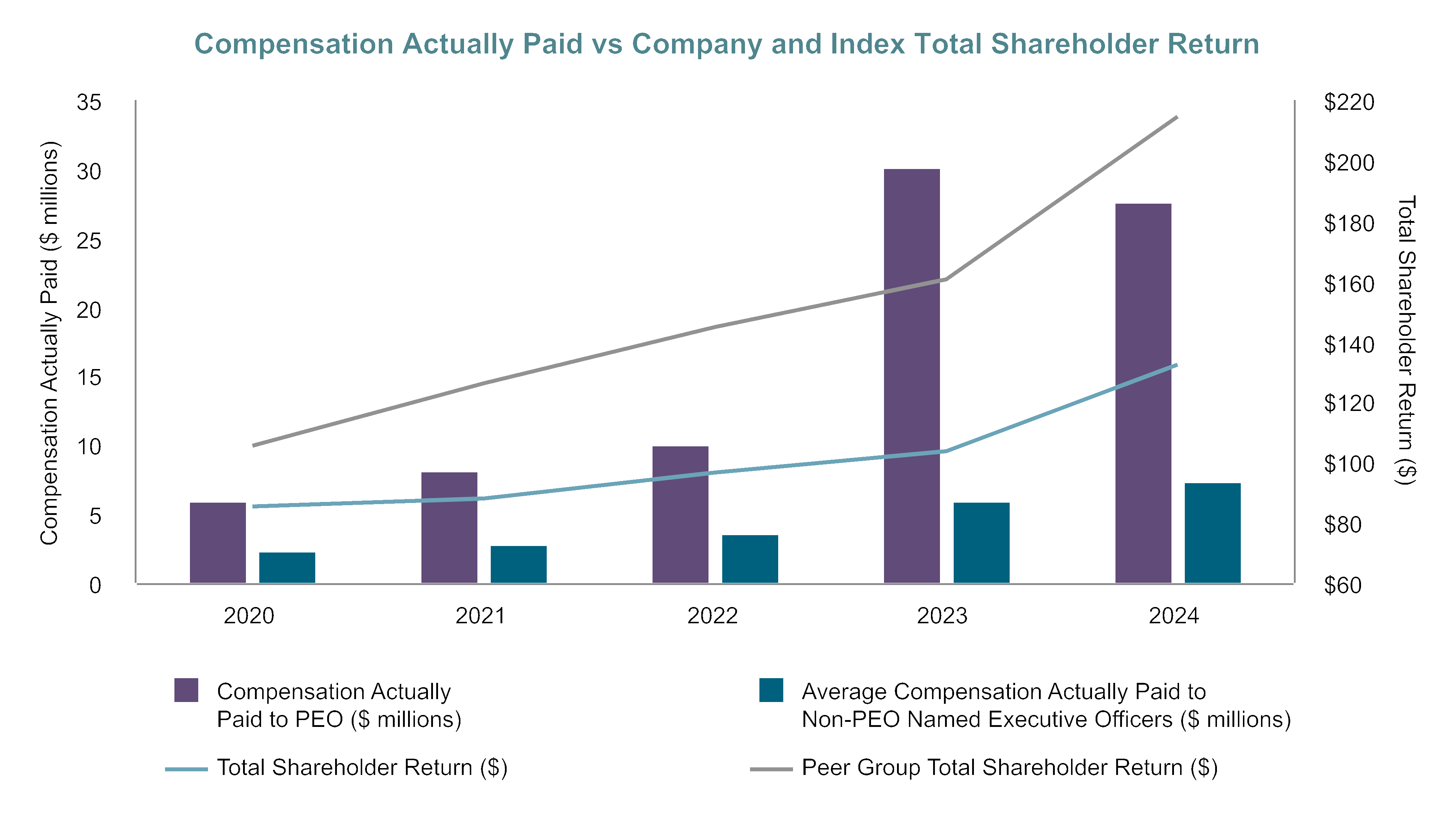
RenaissanceRe 2025 Proxy Statement | 77
|
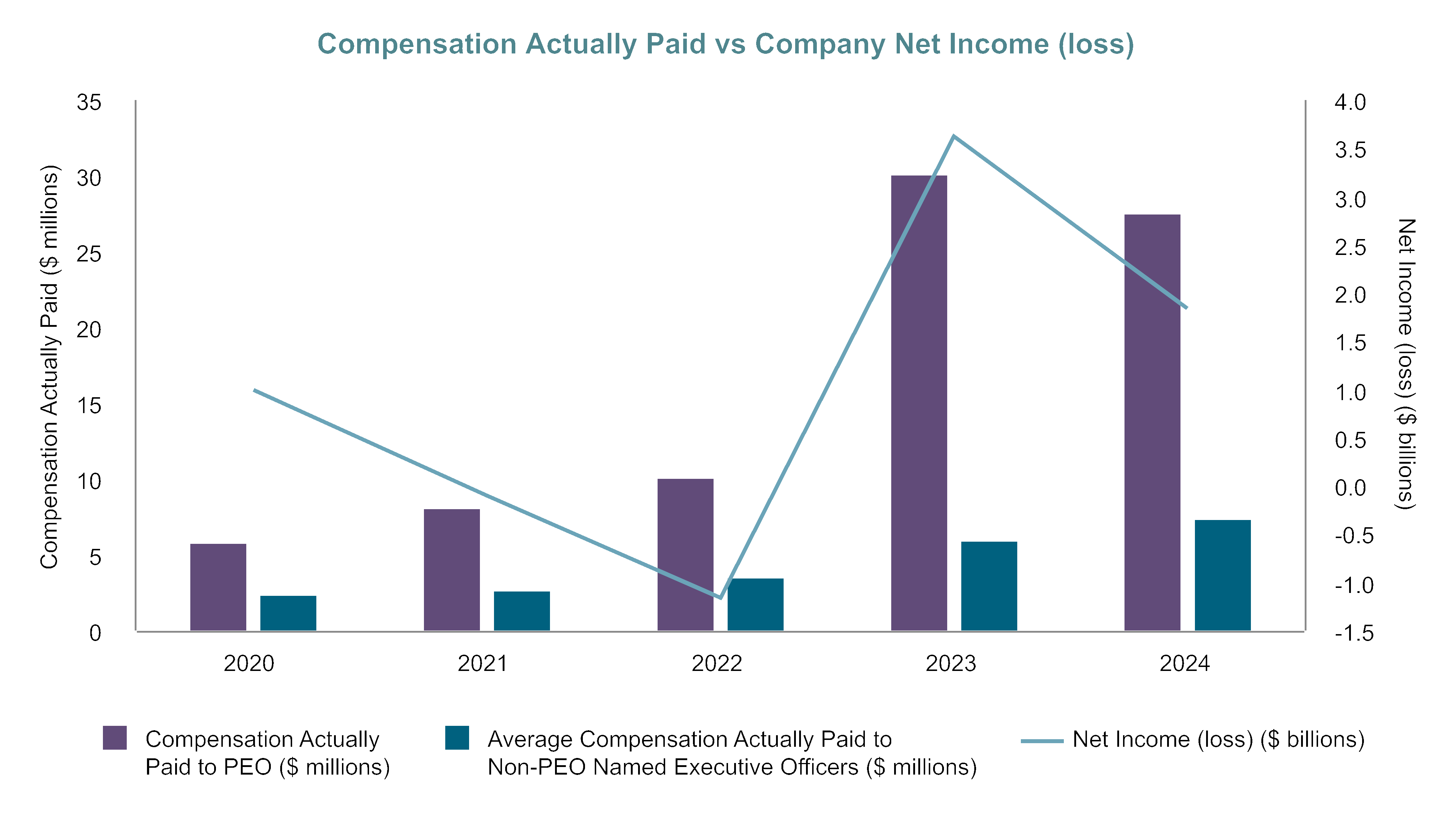
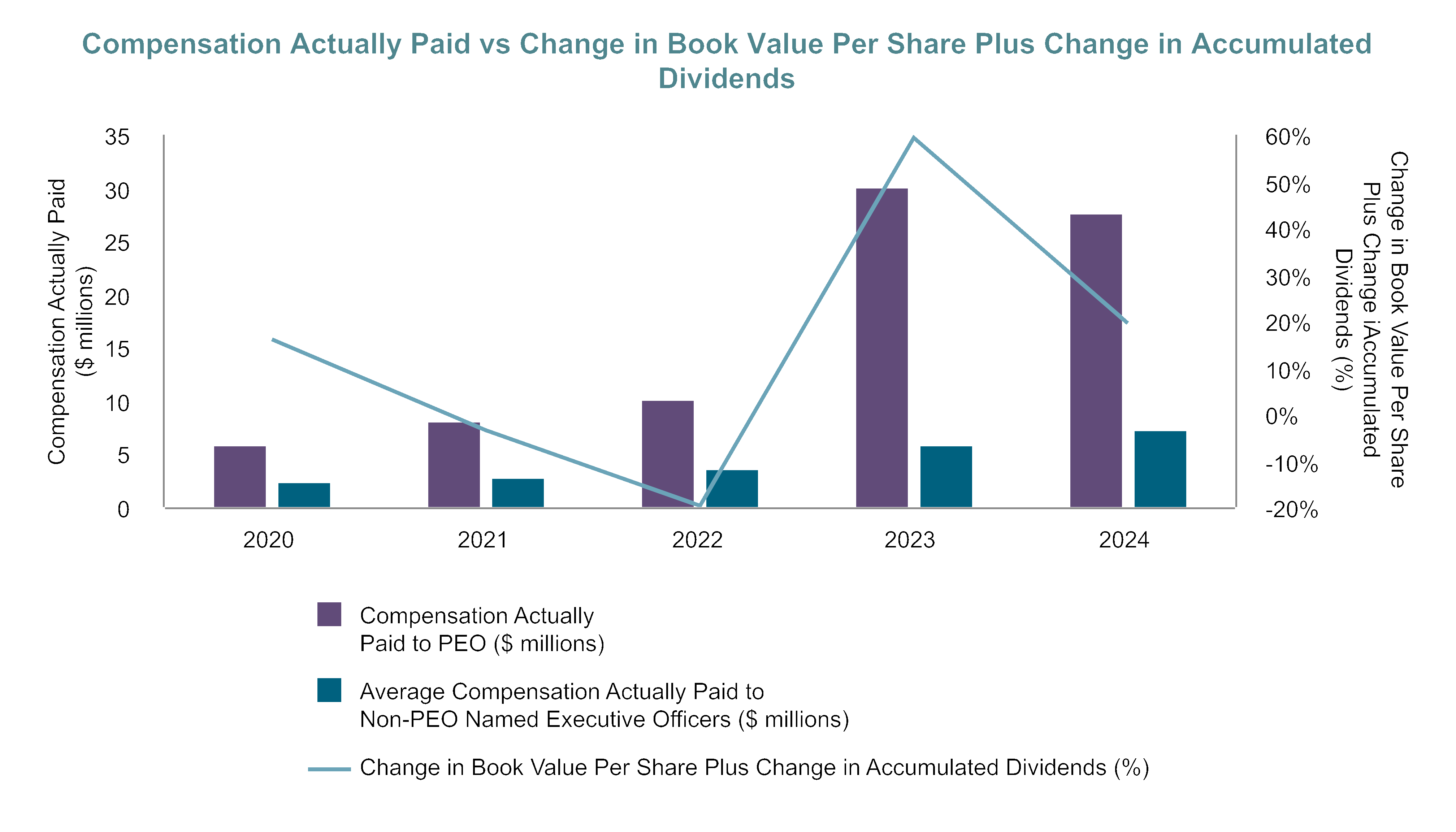
78 | RenaissanceRe 2025 Proxy Statement
|
Performance Measures Used to Link Company Performance and Compensation
Actually Paid to the Named Executive Officers
The following is a list of financial performance measures, which in our assessment represent the most important financial
performance measures used by us to link our performance to compensation actually paid to the named executive officers for
fiscal 2024. Please see “Compensation Discussion and Analysis” for a further description of these metrics and how they are
used in our executive compensation program.
•Change in book value per share plus change in accumulated dividends
•Adjusted Operating ROE
•Combined ratio
•Gross premiums written
•Underwriting expense ratio
Equity Compensation Plan Information
The information set forth in the table below is as of December 31, 2024:
Plan Category |
Number of securities to be
issued upon exercise of
outstanding options,
warrants, and rights(1)
(a)
|
Weighted-average
exercise price of
outstanding options,
warrants, and rights ($)
(b)
|
Number of securities
remaining available for
future issuance under
equity compensation plans
(excluding securities
reflected in column (a))
(c)
|
Equity compensation plans approved by
shareholders(2)
|
— |
— |
829,935 |
Equity compensation plans not approved by
shareholders
|
— |
— |
— |
Total |
— |
— |
829,935 |
(1)As of December 31, 2024, there were no outstanding options. A total of 1,043,601 unvested restricted shares (including both time-vested
restricted shares and performance shares) were excluded from column (a) as those shares are considered issued at the time of grant.
Unvested restricted shares were also excluded from column (c) as they are no longer available for future issuance.
(2)Plans previously approved by the shareholders include the 2016 LTI Plan.
RenaissanceRe 2025 Proxy Statement | 79
|
Audit Matters
PROPOSAL 3 |
|||
Approval of the Appointment of Independent Registered
Public Accounting Firm and Referral of the Determination
of the Auditor’s Remuneration to the Board
|
|||
 |
The Audit Committee and the Board of Directors unanimously recommend that shareholders vote FOR the
approval of the appointment of PricewaterhouseCoopers Ltd. as our independent registered public
accounting firm for the 2025 fiscal year and the referral of the determination of the auditor’s remuneration
to the Board.
|
||
Overview of Proposal
The Audit Committee evaluates the performance of our independent registered public accounting firm each year and
determines whether to reengage them or consider other firms. In doing so, the Audit Committee considers the auditor’s service
quality and efficiency, capability, technical expertise and knowledge of our operations and industry. In addition, the Audit
Committee is involved in the selection of our independent registered public accounting firm’s lead engagement partner and
ensures that the mandated rotation of the lead partner occurs routinely. Upon recommendation of the Audit Committee, the
Board has appointed PricewaterhouseCoopers Ltd. to serve as our independent registered public accounting firm for the 2025
fiscal year. We have engaged PricewaterhouseCoopers Ltd. in this capacity since 2022.
A representative of PricewaterhouseCoopers Ltd. is expected to attend the Annual Meeting. The representative will have an
opportunity to make a statement if the representative so desires and will be available to respond to appropriate questions from
shareholders.
Recommendation and Vote
In accordance with Bermuda law, our shareholders have the authority to approve the appointment of our independent
registered public accounting firm and a proposal will be submitted to the shareholders at the Annual Meeting for approval of
the appointment of PricewaterhouseCoopers Ltd. Shareholders at the Annual Meeting will also be asked to vote to refer the
determination of the auditor’s remuneration to the Board. Approval of this proposal requires the affirmative vote of a majority of
the votes cast at the Annual Meeting and entitled to vote thereon.
80 | RenaissanceRe 2025 Proxy Statement
|
Principal Accountant Fees and Services
The following table summarizes the aggregate fees billed by PricewaterhouseCoopers Ltd. during our 2024 and 2023 fiscal
years.
Type of Fees |
Fiscal 2024
($)
|
Fiscal 2023
($)
|
Audit Fees |
8,426,188 |
9,460,322 |
Audit-Related Fees |
74,675 |
74,675 |
Tax Fees |
271,548 |
368,473 |
All Other Fees |
9,950 |
11,830 |
Total |
8,782,361 |
9,915,300 |
Audit Fees. Audit fees for 2024 and 2023 consist of fees for (a) the audit of our annual financial statements, (b) review of our
quarterly financial statements, (c) statutory audits, and (d) assistance with and review of documents filed with the SEC
(including comfort letters and consents).
Audit-Related Fees. Audit-related fees for both 2024 and 2023 principally related to audits of our employee benefits plans.
Tax Fees. Tax fees for 2024 and 2023 consisted of fees related to (a) tax compliance services, (b) transfer pricing services,
and (c) other tax consulting services.
All Other Fees. All other fees for 2024 consisted of (a) the provision of certain software and (b) a compensation benchmarking
study. All other fees for 2023 consisted of fees related to (a) the provision of certain software and (b) a compensation
benchmarking study.
Pre-Approval Policies and Procedures
The Audit Committee is responsible for managing our relationship with our independent auditor. The Audit Committee has the
sole authority to appoint and engage our auditor, subject to approval and ratification by the shareholders. The Audit Committee
regularly reviews the auditor’s work plan, bills, and work product.
The Audit Committee must pre-approve all audit services and permitted non-audit services performed for us by our auditor,
subject to the de minimis exceptions for non-audit services described in Section 10A(i)(1)(B) of the Exchange Act that are
approved by the Audit Committee prior to the completion of the audit. The Audit Committee may delegate the authority to grant
pre-approvals of audit and permitted non-audit services to a subcommittee of its members, provided that decisions of such
subcommittee to grant pre-approvals shall be presented to the full Audit Committee at its next scheduled meeting. All
engagements of PricewaterhouseCoopers Ltd. to provide audit, audit-related services and permitted non-audit services to us
during 2024 and 2023, respectively, were pre-approved by the Audit Committee.
RenaissanceRe 2025 Proxy Statement | 81
|
Audit Committee Report
The information contained in this report shall not be deemed to be “soliciting material” or to be “filed” with the Commission, nor
shall such information or report be incorporated by reference into any future filing by us under the Securities Act, or the
Exchange Act, except to the extent that we specifically incorporate it by reference in such filing.
The Audit Committee oversees our financial reporting process on behalf of the Board. Management has the primary
responsibility for establishing and maintaining adequate internal financial controls, for preparing our financial statements, and
for the public reporting process. PricewaterhouseCoopers Ltd., our independent auditor for 2024, is responsible for expressing
opinions on the conformity of our audited financial statements with generally accepted accounting principles in the United
States and on the effectiveness of our internal control over financial reporting.
The Audit Committee is responsible for the appointment, compensation, retention and oversight of the work of our independent
auditor, for the purpose of preparing or issuing an audit report. In fulfilling its oversight responsibilities, the Audit Committee
reviewed (i) management’s assessment of the effectiveness of our internal control over financial reporting and
PricewaterhouseCoopers Ltd.’s evaluation of our internal control over financial reporting, and (ii) the audited financial
statements in our Annual Report on Form 10-K for the year ended December 31, 2024 with management, including a
discussion of the quality, not just the acceptability, of the accounting principles, the reasonableness of significant judgments,
and the clarity of disclosures in the financial statements.
The Audit Committee reviewed and discussed with PricewaterhouseCoopers Ltd. the matters that are required to be discussed
by the applicable requirements of the Public Company Accounting Oversight Board and the Commission, including its
judgments as to the quality, not just the acceptability, of our accounting principles, the reasonableness of significant judgments,
all critical accounting policies and practices to be used, material alternative accounting treatments within generally accepted
accounting principles discussed with management and other material written communications between
PricewaterhouseCoopers Ltd. and management. The Audit Committee has discussed with PricewaterhouseCoopers Ltd. its
independence from both management and the Company and has received the written disclosures and the letter from the
independent auditor required by the applicable requirements of the Public Company Accounting Oversight Board regarding the
independent auditor’s communications with the Audit Committee concerning independence. The Audit Committee has
reviewed and discussed the audited financial statements with management.
The Audit Committee discussed with PricewaterhouseCoopers Ltd. the overall scope and plans for its audit. The Audit
Committee met with the independent auditor, with and without management present, to discuss the results of their
examination, their evaluations of our internal controls and the overall quality of our financial reporting.
In reliance on the reviews and discussions referred to above, the Audit Committee recommended to the Board (and the Board
has approved) that the audited financial statements be included in the Annual Report on Form 10-K for the year ended
December 31, 2024, for filing with the Commission.
Carol P. Sanders, Chair
Shyam Gidumal
Valerie Rahmani
82 | RenaissanceRe 2025 Proxy Statement
|
Security Ownership
Security Ownership of Certain Beneficial Owners
The following table sets forth information with respect to the beneficial ownership of our common shares as of March 5, 2025
for each person known by us to own beneficially 5% or more of our outstanding common shares.
Name and Address of Beneficial Owner |
Number of
Common Shares
|
Percentage of
Class(1)
|
The Vanguard Group(2)
100 Vanguard Blvd.
Malvern, PA 19355
|
5,565,691 |
11.4% |
BlackRock, Inc.(3)
55 East 52nd Street
New York, NY 10055
|
4,775,532 |
9.7% |
Orbis Investment Management Ltd(4)
25 Front Street
Hamilton HM11, Bermuda
|
2,864,105 |
5.8% |
Capital World Investors(5)
33 South Hope Street, 55th Floor
Los Angeles, California 90071
|
2,649,127 |
5.4% |
(1)The percentage of class shown is based on the common shares reported as beneficially owned on Schedule 13G or Schedule 13G/A and
49,004,247 common shares outstanding as of March 5, 2025.
(2)According to a Statement on Schedule 13G/A filed on February 13, 2024 by The Vanguard Group (“Vanguard”), Vanguard was the
beneficial owner of 5,565,691 common shares as of December 29, 2023 and had the shared power to vote or direct the vote of 27,825
common shares, sole power to dispose of or to direct the disposition of 5,446,022 common shares and shared power to dispose or direct
the disposition of 119,669 common shares. On May 11, 2018, we granted Vanguard a limited waiver from the restrictions on the
acquisition of share ownership set forth in our Bye-laws, up to a maximum amount of shares representing 15% of our shares outstanding.
Vanguard has agreed that, in accordance with our Bye-laws, the voting rights attributable to shares owned or controlled by Vanguard will
not exceed 9.9% of the voting rights attached to all of our issued and outstanding capital shares.
(3)According to a Statement on Schedule 13G/A filed on February 9, 2024 by BlackRock, BlackRock was the beneficial owner of 4,775,532
common shares as of December 31, 2023 and had the sole power to vote or to direct the voting of 4,597,476 common shares and sole
power to dispose of or to direct the disposition of 4,775,532 common shares. On November 15, 2016, we granted BlackRock a limited
waiver from the restrictions on the acquisition of share ownership set forth in our Bye-laws, up to a maximum amount of shares
representing 15% of our shares outstanding. BlackRock has agreed that, in accordance with our Bye-laws, the voting rights attributable to
shares owned or controlled by BlackRock will not exceed 9.9% of the voting rights attached to all of our issued and outstanding capital
shares.
(4)According to a Statement on Schedule 13G filed on February 14, 2025 by Orbis Investment Management Ltd (“Orbis”), Orbis was the
beneficial owner of 2,864,105 common shares as of December 31, 2024 and had the sole power to vote or to direct the voting of
2,864,105 common shares and sole power to dispose of or to direct the disposition of 2,864,105 common shares.
(5)According to a Statement on Schedule 13G filed on November 13, 2024 by Capital World Investors (“CWI”), CWI was the beneficial
owner of 2,649,127 common shares as of September 30, 2024 and had the sole power to vote or to direct the voting of 2,649,127
common shares and sole power to dispose of or to direct the disposition of 2,649,127 common shares.
RenaissanceRe 2025 Proxy Statement | 83
|
Security Ownership of Management
The following table sets forth information with respect to the beneficial ownership of our common shares as of March 5, 2025
for each of our named executive officers, directors and all of our executive officers and directors as a group. Unless otherwise
noted below, each of these individuals had sole voting and dispositive power with respect to the common shares beneficially
owned by him or her.
Name of Beneficial Owner |
Number of
Common Shares
|
Percentage of
Class(1)
|
Kevin J. O’Donnell(2)
|
433,193 |
* |
Robert Qutub(3)
|
82,859 |
* |
Ross A. Curtis(4)
|
188,059 |
* |
David Marra(5)
|
90,723 |
* |
Shannon L. Bender(6)
|
31,887 |
* |
David C. Bushnell(7)
|
18,705 |
* |
James L. Gibbons(7)
|
31,388 |
* |
Shyam Gidumal(7)
|
3,231 |
* |
Duncan P. Hennes(7)
|
8,118 |
* |
Torsten Jeworrek(7)
|
2,215 |
* |
Henry Klehm III(7)
|
19,740 |
* |
Loretta J. Mester(7)
|
1,287 |
* |
Valerie Rahmani(7)
|
8,118 |
* |
Carol P. Sanders(7)
|
6,663 |
* |
Cynthia Trudell(7)
|
5,956 |
* |
All of our executive officers and directors (17 persons)(8)
|
993,850 |
2.0% |
*Less than 1%
(1)The percentage of class shown is based on 49,004,247 common shares outstanding as of March 5, 2025.
(2)Includes (i) 52,202 time-vested restricted shares that have not yet vested and (ii) 170,558 performance shares, for which the performance
period has not yet been completed, that are eligible to be earned if maximum performance is attained. Also includes 1,079 shares held by
a limited partnership for the benefit of Mr. O’Donnell’s family.
(3)Includes (i) 10,110 time-vested restricted shares that have not yet vested and (ii) 42,377 performance shares, for which the performance
period has not yet been completed, that are eligible to be earned if maximum performance is attained.
(4)Includes (i) 10,960 time-vested restricted shares that have not yet vested and (ii) 45,615 performance shares, for which the performance
period has not yet been completed, that are eligible to be earned if maximum performance is attained.
(5)Includes (i) 14,647 time-vested restricted shares that have not yet vested and (ii) 30,749 performance shares, for which the performance
period has not yet been completed, that are eligible to be earned if maximum performance is attained.
(6)Includes (i) 6,304 time-vested restricted shares that have not yet vested and (ii) 22,217 performance shares, for which the performance
period has not yet been completed, that are eligible to be earned if maximum performance is attained.
(7)Includes the following number of restricted shares granted in payment of directors’ fees that have not yet vested: 1,090 restricted shares
for Dr. Mester, 1,447 restricted shares for Dr. Jeworrek; 1,439 restricted shares for Messrs. Bushnell, Gidumal, Hennes and Klehm and
Mses. Sanders and Trudell and Dr. Rahmani; and 2,749 restricted shares for Mr. Gibbons.
(8)Includes 128,334 time-vested restricted shares that have not yet vested.
84 | RenaissanceRe 2025 Proxy Statement
|
General Information
About the Proxy Materials and the Annual Meeting
This proxy statement summarizes the information you need to know to vote at the Annual Meeting. The notice regarding the
availability of proxy materials, this proxy statement, the Notice of Annual General Meeting of Shareholders and the proxy card
are first being made available to shareholders on or about March 20, 2025, concurrently with the distribution of our 2024
Annual Report to Shareholders. Our Annual Report shall not be deemed to be part of this proxy statement.
Record Date
The Board has set March 5, 2025 as the record date for the Annual Meeting. On the record date, there were 49,004,247
shares of our common stock outstanding and entitled to vote.
Shareholders Entitled to Vote
If you were the beneficial owner of common shares held in street name, or a shareholder of record with respect to our common
shares at the close of business on the record date, you are entitled to notice of, and may vote at, the Annual Meeting. The
common shares are our only class of equity securities outstanding and entitled to vote at the Annual Meeting.
Each of our common shares entitles its holder to one vote on each matter that is voted upon at the Annual Meeting or any
postponements or adjournments thereof, subject to certain provisions of our Bye-laws that reduce the total voting power of any
shareholder owning, directly or indirectly, beneficially or otherwise, as described in our Bye-laws, more than 9.9% of the
common shares to not more than 9.9% of the total voting power of our capital stock unless otherwise waived at the discretion
of the Board. In addition, the Board may limit a shareholder’s voting rights where the Board deems it necessary to do so to
avoid adverse tax, legal or regulatory consequences. The reduction of such voting power may have the effect of increasing
another shareholder’s voting power to more than 9.9%, thereby requiring a corresponding reduction in such other
shareholder’s voting power.
Because the applicability of the voting power reduction provisions to any particular shareholder depends on facts and
circumstances that may be known only to the shareholder or related persons, we request that any holder of common shares
with reason to believe that it is a shareholder whose common shares carry more than 9.9% of the voting power of
RenaissanceRe contact us promptly so that we may determine whether the voting power of such holder’s common shares
should be reduced. The Board is empowered to require any shareholder to provide information as to that shareholder’s
beneficial ownership of common shares, the names of persons having beneficial ownership of the shareholder’s common
shares, relationships with other shareholders or any other facts the directors may consider relevant to the determination of the
number of common shares attributable to any person. The Board may disregard the votes attached to common shares of any
holder who fails to respond to such a request or who, in the Board’s judgment, submits incomplete or inaccurate information.
The Board retains the discretion to make such final adjustments that it considers fair and reasonable in all circumstances as to
the aggregate number of votes attaching to the common shares of any shareholder to ensure that no shareholder’s voting
power is more than 9.9% of the total voting power of our capital stock at any time.
These voting power restrictions may be waived by the Board in its sole discretion. To date, the Board has consistently enforced
these voting power restrictions.
Quorum
Two persons present in person and throughout the Annual Meeting representing in person or by proxy more than 50% of the
issued common shares entitled to vote on the matters to be considered at the Annual Meeting form a quorum for the
transaction of business at the Annual Meeting. Withheld votes for the election of directors, abstentions and “broker non-
votes” (shares held by a broker or nominee that does not have discretionary authority to vote on a particular matter and has
not received voting instructions from its client) will be counted for purposes of determining whether a quorum is present.
RenaissanceRe 2025 Proxy Statement | 85
|
Vote Required
The Board has adopted a majority vote standard in uncontested director elections, which means that director nominees for
whom the number of votes cast FOR that director’s election exceeds the number of votes cast AGAINST that director’s
election (with abstentions and broker non-votes not counted as a vote cast either FOR or AGAINST a director’s election) will
be elected as a director at the Annual Meeting. In the event that a nominee for election fails to receive a majority of the votes
cast at an election which is uncontested, such nominee will tender an irrevocable resignation, and the Board will decide
whether to accept or reject the resignation no later than ninety (90) days following certification of the election results. Because
we did not receive proper advance notice in accordance with our Bye-laws of any shareholder nominees for director, the
election of directors solicited hereby is an uncontested election.
Your bank, broker or other nominee is not permitted to vote your shares on any proposal that is considered to be non-routine
under the rules of the NYSE unless it has received your specific voting instructions with respect to that proposal. For routine
matters, unless your proxy indicates otherwise, the persons named as your proxies will vote your shares according to the
recommendation of the Board.
A hand vote will be taken unless a poll is requested pursuant to our Bye-laws.
The following table summarizes the voting options, vote required for approval and effect of abstentions and broker non-votes
for each proposal to be considered at the Annual Meeting:
Proposal |
Board
Recommendation
|
Voting
Options
|
Voting Approval
Standard
|
Effect of
Abstentions
|
Broker
Discretionary
Voting Allowed?
|
Effect of Broker
Non-Votes
|
||
Election of one Class II and
four Class III director
nominees named in this
proxy statement
|
 |
FOR each
director
nominee
|
FOR,
AGAINST or
ABSTAIN for
each director
nominee
|
The number of
votes cast FOR
that director’s
election exceeds
the number of
votes cast
AGAINST that
director’s election
as a director at the
Annual Meeting
|
No effect |
No |
No effect |
|
Advisory vote on the
compensation of our
named executive officers
|
 |
FOR |
FOR,
AGAINST or
ABSTAIN
|
Majority of the
votes cast at the
Annual Meeting
|
No effect |
No |
No effect |
|
Approval of the
appointment of
PricewaterhouseCoopers
Ltd. as our independent
registered public
accounting firm for the
2025 fiscal year and the
referral of the auditor’s
remuneration to the Board
|
 |
FOR |
FOR,
AGAINST or
ABSTAIN
|
Majority of the
votes cast at the
Annual Meeting
|
No effect |
Yes |
Not applicable |
|
86 | RenaissanceRe 2025 Proxy Statement
|
How to Vote
Shareholder of Record
If your common shares are registered directly in your name with our transfer agent, Computershare Trust Company, N.A., you
are considered the shareholder of record with respect to those shares, and the notice regarding the availability of proxy
materials was sent directly to you by Broadridge Financial Solutions, Inc. (“Broadridge”), our tabulation agent.
If you are a shareholder of record, you may vote in person at the Annual Meeting, in which case we will give you a ballot when
you arrive. If you do not wish to vote in person or if you will not be attending the Annual Meeting, you may vote (1) by proxy
over the Internet by following the instructions provided in the notice; or (2) if you requested printed copies of the proxy
materials by mail, you must either (a) fill out the enclosed proxy card, date and sign it and return it in the enclosed postage
paid envelope; or (b) vote using the Internet (instructions are on the proxy card).
Beneficial Owner of Common Shares Held in Street Name
If your common shares are held in an account at a brokerage firm, bank, broker-dealer or similar organization, then you are the
beneficial owner of common shares held in street name, and the notice regarding the availability of proxy materials should
have been forwarded to you by that organization. The organization holding your account is considered the shareholder of
record for purposes of voting at the Annual Meeting. As a beneficial owner of common shares held in street name, you have
the right to direct that organization on how to vote the common shares held in your account.
If you are a beneficial owner of common shares held in street name and you wish to vote in person at the Annual Meeting, you
must obtain and produce at the Annual Meeting a valid proxy from the organization that holds your common shares along with
valid identification. We will give you a ballot when you arrive.
If you do not wish to vote in person or you will not be attending the Annual Meeting, you have the right to direct your brokerage
firm, bank, broker-dealer or similar organization on how to vote the common shares held in your account. Please refer to the
voting instructions provided by such organization for directions as to how to vote the common shares that you beneficially own.
Revoking Your Proxy
You may change your vote or revoke your proxy at any time before your proxy is voted at the Annual Meeting. You may vote
again on a later date by following the same procedures by which you submitted your original vote, or by attending the Annual
Meeting and voting in person. However, your attendance at the Annual Meeting will not automatically revoke your proxy unless
you vote again at the Annual Meeting or specifically request in writing that your prior proxy be revoked. Your latest vote or
proxy, however submitted, will be counted. If you wish to change your vote or revoke your proxy, you must do so in sufficient
time to permit the necessary examination and tabulation of the subsequent proxy or revocation before the vote is taken.
Effect of Not Voting
Shareholder of Record
If you are a shareholder of record and you indicate when voting on the Internet that you wish to vote as recommended by our
Board or sign and return a proxy card without giving specific voting instructions, then the proxies will vote your shares in the
manner recommended by our Board on all matters presented in this proxy statement and as the proxies may determine in their
discretion with respect to any other matters properly presented for a vote at the Annual Meeting. Withheld votes for election of
directors and proxies marked as abstentions to a proposal will not be counted except for purposes of determining whether a
quorum is present.
RenaissanceRe 2025 Proxy Statement | 87
|
Beneficial Owner of Common Shares Held in Street Name
If you are a beneficial owner of common shares held in street name and the organization that holds your shares does not
receive instructions from you on how to vote your shares on a non-routine matter at least 10 days before the Annual Meeting,
the organization that holds your shares will inform our inspector of election that it does not have the authority to vote on this
matter with respect to your shares. When our inspector of election tabulates the votes for any particular non-routine matter,
broker non-votes (like abstentions) will be counted for purposes of determining whether a quorum is present, but will not
otherwise be counted. We encourage you to provide voting instructions to the organization that holds your shares by carefully
following the instructions provided by that organization.
Proxy Solicitation
Your proxy is being solicited by the Board. We have engaged the firm of MacKenzie Partners to act as the solicitation agent on
behalf of the Board to assist in the solicitation of proxies for a fee of $17,500, plus the reimbursement of certain expenses, paid
by us. The persons named in the proxy card have been designated as proxies by the Board and are officers of
RenaissanceRe.
Further solicitation may be made by our directors, officers and employees personally, by telephone, Internet or otherwise, but
such persons will not be specifically compensated for such services. We may also solicit, through bankers, brokers, or other
persons, proxies from beneficial holders of the common shares. Upon request, we will reimburse brokers, dealers, banks, or
similar entities for reasonable expenses incurred in forwarding copies of the proxy materials relating to the Annual Meeting to
the beneficial owners of common shares that such persons hold of record.
Notice and Access
Pursuant to rules adopted by the Commission and applicable Bermuda law, we are providing access to our proxy materials
over the Internet, which will save costs and paper. On or about March 20, 2025, we mailed a notice regarding the availability of
proxy materials, which contains basic information about the Annual Meeting and instructions on how to view all proxy materials
on a website referred to in the notice or to request to receive a printed set of the proxy materials.
The notice regarding availability of proxy materials will also provide you with instructions on how to request that we send our
future proxy materials to you electronically by e-mail or to request to receive printed copies of future proxy materials by mail.
Multiple Notices or Sets of Printed Proxy Materials
If you receive multiple notices or sets of printed proxy materials, it generally means that you hold common shares registered in
more than one account. To ensure that all of your shares are voted, please vote in the manner described above with respect to
each notice or in the proxy card accompanying the proxy materials.
Appraisal Rights
The Board has not proposed for consideration at the Annual Meeting any transaction for which the laws of Bermuda grant
appraisal rights to shareholders.
Voting Results
Preliminary voting results will be announced at the Annual Meeting. Final voting results will be tallied by our inspector of
election and filed with the SEC on a Current Report on Form 8-K within four business days following the Annual Meeting.
88 | RenaissanceRe 2025 Proxy Statement
|
Additional Information
Other Action at the Annual Meeting
Our Annual Report to Shareholders for the year ended December 31, 2024, including financial statements for the year ended
December 31, 2024, and the auditor’s report thereon, has been made available to all shareholders. The financial statements
and auditor’s report will be formally presented at the Annual Meeting, but no shareholder action is required thereon.
As of the date of this proxy statement, we have no knowledge of any business, other than that which we have described
herein, that will be presented for consideration at the Annual Meeting. In the event any other business is properly presented at
the Annual Meeting, it is intended that the persons named in the accompanying proxy will have authority to vote such proxy in
accordance with their judgment on such business. In addition, such persons may vote such proxy to adjourn the Annual
Meeting if necessary. Our Board also has the authority to postpone the Annual Meeting in such circumstances. In the event it
is advisable to adjourn, postpone or change location of the Annual Meeting, we will announce our decision as promptly as
practicable.
Shareholder Proposals for 2026 Annual General
Meeting of Shareholders
In accordance with SEC Rule 14a-8, shareholder proposals intended for inclusion in our 2026 proxy statement and to be
presented at the 2026 Annual General Meeting of Shareholders must be received in writing by us no later than November 20,
2025 and must comply with the requirements of the Commission and our Bye-laws. Such proposals should be directed to the
attention of the Corporate Secretary, RenaissanceRe Holdings Ltd., P.O. Box HM 2527, Hamilton, HM GX, Bermuda.
Shareholders who intend to nominate persons for election as directors at our annual general meetings of shareholders must
comply with the advance notice procedures and other provisions set forth in our Bye-laws in order for such nominations to be
properly brought before that annual general meeting of shareholders. These provisions require, among other things, that
written notice from no fewer than 20 shareholders holding in the aggregate not less than 10% of the outstanding paid-up share
capital of RenaissanceRe be received by the Corporate Secretary of RenaissanceRe not less than 60 days prior to the annual
general meeting of shareholders.
If a shareholder intends to present a proposal at the 2026 Annual General Meeting of Shareholders without any discussion of
the proposal in our proxy statement, and the shareholder does not notify us of such proposal on or before February 3, 2026 as
required by SEC Rule 14a-4(c)(1), then proxies received by us for the 2026 Annual General Meeting of Shareholders will be
voted by the persons named as such proxies in their discretion with respect to such proposal. Notice of any such proposal is to
be sent to the above address. In addition, to comply with the universal proxy rules, shareholders who intend to solicit proxies in
support of director nominees other than RenaissanceRe nominees must provide notice that sets forth the information required
by Rule 14a-19 under the Exchange Act no later than March 7, 2026.
Householding of Annual Meeting Materials
The SEC has enacted a rule that allows multiple investors residing at the same address the convenience of receiving a single
copy of annual reports, proxy statements, prospectuses and other disclosure documents if they consent to do so. This is
known as “householding.” We will allow householding only upon certain conditions. Some of those conditions are:
•You agree to, or do not object to, the householding of your materials; and
•You have the same last name and exact address as another investor(s).
If these conditions are met, and SEC regulations allow, your household will receive a single copy of annual reports, proxy
statements, prospectuses and other disclosure documents.
RenaissanceRe 2025 Proxy Statement | 89
|
You may revoke a prior householding consent at any time by contacting Broadridge, either by calling toll-free at
1-866-540-7095, or by writing to Broadridge, Householding Department, 51 Mercedes Way, Edgewood, New York 11717. We
will remove you from the householding program within 30 days of receipt of your response, following which you will receive an
individual copy of our disclosure document. Shareholders sharing an address and wishing to receive a single set of reports
may do so by contacting their banks or brokers, if they are beneficial holders, or by contacting Broadridge at the address set
forth above if they are record holders.
Website
We maintain a website at www.renre.com. The information on this website, including but not limited to the information on the
webpage titled “Sustainability,” is not incorporated by reference in this proxy statement.
Cautionary Statement Regarding
Forward-Looking Statements
Any forward-looking statements made in this Proxy Statement reflect RenaissanceRe’s current views with respect to future
events and financial performance and are made pursuant to the safe harbor provisions of the Private Securities Litigation
Reform Act of 1995. These statements are subject to numerous factors that could cause actual results to differ materially from
those set forth in or implied by such forward-looking statements, including the following: our exposure to natural and non-
natural catastrophic events and circumstances and the variance they may cause in our financial results; the effect of climate
change on our business, including the trend towards increasingly frequent and severe climate events; the effectiveness of our
claims and claim expense reserving process; the effect of emerging claims and coverage issues; the performance of our
investment portfolio and financial market volatility; the effects of inflation; our exposure to ceding companies and delegated
authority counterparties and the risks they underwrite; our ability to maintain our financial strength ratings; our reliance on a
small number of brokers; the highly competitive nature of our industry; the historically cyclical nature of the (re)insurance
industries; collection on claimed retrocessional coverage and new retrocessional reinsurance being available; our ability to
attract and retain key executives and employees; our ability to successfully implement our business, strategies and initiatives;
our exposure to credit loss from counterparties; our need to make many estimates and judgments in the preparation of our
financial statements; our exposure to risks associated with our management of capital on behalf of investors; changes to the
accounting rules and regulatory systems applicable to our business, including changes in Bermuda and U.S. laws or
regulations; the effect of current or future macroeconomic or geopolitical events or trends, including the ongoing conflicts
between Russia and Ukraine, and in the Middle East; other political, regulatory or industry initiatives adversely impacting us;
the impact of cybersecurity risks, including technology breaches or failure; our ability to comply with covenants in our debt
agreements; the effect of adverse economic factors, including changes in the prevailing interest rates; the effects of new or
possible future tax actions or reform legislation and regulations in the jurisdictions in which we operate; our ability to determine
any impairments taken on our investments; our ability to raise capital on acceptable terms; our ability to comply with applicable
sanctions and foreign corrupt practices laws; our dependence on capital distributions from our operating subsidiaries; and
other factors affecting future results disclosed in RenaissanceRe’s filings with the SEC, including its Annual Reports on Form
10-K and Quarterly Reports on Form 10-Q.
A-1 | RenaissanceRe 2025 Proxy Statement
|
Appendix A: Reconciliation of
Non-GAAP Financial Measures
We have included certain non-GAAP financial measures within the meaning of Regulation G in this proxy statement. We have
provided certain of these financial measures in previous investor communications and our management believes that such
measures are important to investors and other interested persons, and that investors and such other persons benefit from
having a consistent basis for comparison between periods and for comparison with other companies within or outside the
industry. These measures may not, however, be comparable to similarly titled measures used by companies within or outside
of the insurance industry. Investors are cautioned not to place undue reliance on these non-GAAP measures in assessing our
overall financial performance.
Operating Income (Loss) Available (Attributable) to RenaissanceRe Common
Shareholders and Operating Return on Average Common Equity
We use “operating income (loss) available (attributable) to RenaissanceRe common shareholders” as a measure to evaluate
the underlying fundamentals of its operations and believe it to be a useful measure of our corporate performance. “Operating
income (loss) available (attributable) to RenaissanceRe common shareholders” as used herein differs from “net income (loss)
available (attributable) to RenaissanceRe common shareholders,” which we believe is the most directly comparable GAAP
measure, by the exclusion of (1) net realized and unrealized gains and losses on investments, excluding other investments -
catastrophe bonds, (2) net foreign exchange gains and losses, (3) expenses and revenues associated with acquisitions,
dispositions and impairments, (4) acquisition related purchase accounting adjustments, (5) the Bermuda net deferred tax
asset, (6) the income tax expense or benefit associated with these adjustments, and (7) the portion of these adjustments
attributable to the Company’s redeemable noncontrolling interests. We also use “operating income (loss) available
(attributable) to RenaissanceRe common shareholders” to calculate “operating income (loss) available (attributable) to
RenaissanceRe common shareholders per common share - diluted” and “operating return on average common equity.”
Our management believes that “operating income (loss) available (attributable) to RenaissanceRe common shareholders,”
“operating income (loss) available (attributable) to RenaissanceRe common shareholders per common share - diluted” and
“operating return on average common equity” are useful to management and investors because they provide for better
comparability and more accurately measure our results of operations and remove variability.
The following table is a reconciliation of: (1) net income (loss) available (attributable) to RenaissanceRe common shareholders
to “operating income (loss) available (attributable) to RenaissanceRe common shareholders”; (2) net income (loss) available
(attributable) to RenaissanceRe common shareholders per common share - diluted to “operating income (loss) available
(attributable) to RenaissanceRe common shareholders per common share - diluted”; and (3) return on average common equity
to “operating return on average common equity.” Comparative information for the prior periods presented have been updated
to conform to the current methodology and presentation.
RenaissanceRe 2025 Proxy Statement | A-2
|
Year Ended December 31, |
|||
(in thousands of U.S. dollars, except per share amounts and percentages) |
2024 |
2023 |
|
Net income (loss) available (attributable) to RenaissanceRe common shareholders |
$1,834,985 |
$2,525,757 |
|
Adjustment for: |
|||
Net realized and unrealized losses (gains) on investments, excluding other investments - catastrophe
bonds
|
90,193 |
(312,625) |
|
Net foreign exchange losses (gains) |
76,076 |
41,479 |
|
Expenses (revenues) associated with acquisitions, dispositions and impairments(1)
|
70,943 |
76,380 |
|
Acquisition related purchase accounting adjustments(2)
|
242,938 |
64,866 |
|
Bermuda net deferred tax asset(3)
|
(8,339) |
(593,765) |
|
Income tax expense (benefit)(4)
|
13,290 |
3,289 |
|
Net income (loss) attributable to redeemable noncontrolling interests(5)
|
(85,660) |
19,529 |
|
Operating income (loss) available (attributable) to RenaissanceRe common shareholders |
$2,234,426 |
$1,824,910 |
|
Net income (loss) available (attributable) to RenaissanceRe common shareholders per common
share - diluted
|
$35.21 |
$52.27 |
|
Adjustment for: |
|||
Net realized and unrealized losses (gains) on investments, excluding other investments - catastrophe
bonds
|
1.76 |
(6.57) |
|
Net foreign exchange losses (gains) |
1.48 |
0.87 |
|
Expenses (revenues) associated with acquisitions, dispositions and impairments(1)
|
1.38 |
1.60 |
|
Acquisition related purchase accounting adjustments(2)
|
4.73 |
1.36 |
|
Bermuda net deferred tax asset(3)
|
(0.16) |
(12.47) |
|
Income tax expense (benefit)(4)
|
0.26 |
0.07 |
|
Net income (loss) attributable to redeemable noncontrolling interests(5)
|
(1.67) |
0.41 |
|
Operating income (loss) available (attributable) to RenaissanceRe common shareholders per
common share - diluted
|
$42.99 |
$37.54 |
|
Return on average common equity |
19.3% |
40.5% |
|
Adjustment for: |
|||
Net realized and unrealized losses (gains) on investments, excluding other investments - catastrophe
bonds
|
0.9% |
(5.0)% |
|
Net foreign exchange losses (gains) |
0.8% |
0.7% |
|
Expenses (revenues) associated with acquisitions, dispositions and impairments(1)
|
0.8% |
1.2% |
|
Acquisition related purchase accounting adjustments(2)
|
2.6% |
1.0% |
|
Bermuda net deferred tax asset(3)
|
(0.1)% |
(9.5)% |
|
Income tax expense (benefit)(4)
|
0.1% |
0.1% |
|
Net income (loss) attributable to redeemable noncontrolling interests(5)
|
(0.9)% |
0.3% |
|
Operating return on average common equity |
23.5% |
29.3% |
|
(1)Revised from previously reported “corporate expenses associated with acquisitions and dispositions” to “expenses (revenues) associated
with acquisitions, dispositions and impairments” to clarify inclusion of impairments on strategic investments related to acquisitions and
dispositions.
(2)Represents the purchase accounting adjustments related to the amortization of acquisition related intangible assets, amortization
(accretion) of value of business acquired ("VOBA") and acquisition costs, and the fair value adjustments to the net reserves for claims
and claim expenses for the years ended December 31, 2024 and 2023, for the acquisitions of Validus $227.9 million (2023 - $48.8
million); and TMR and Platinum $15.0 million (2023 - $16.1 million).
A-3 | RenaissanceRe 2025 Proxy Statement
|
(3)Represents a net deferred tax benefit recorded during the period in connection with the enactment of the 15% Bermuda corporate income
tax on December 27, 2023.
(4)Represents the income tax (expense) benefit associated with the adjustments to net income (loss) available (attributable) to
RenaissanceRe common shareholders. The income tax impact is estimated by applying the statutory rates of applicable jurisdictions,
after consideration of other relevant factors.
(5)Represents the portion of the adjustments above that are attributable to the Company’s redeemable noncontrolling interests, including the
income tax impact of those adjustments.
Tangible Book Value Per Common Share and Tangible Book Value Per Common
Share Plus Accumulated Dividends
We have included in this Proxy Statement “tangible book value per common share” and “tangible book value per common
share plus accumulated dividends.” “Tangible book value per common share” is defined as book value per common share
excluding per share amounts for (1) acquisition related goodwill and other intangible assets, (2) acquisition related purchase
accounting adjustments, and (3) other goodwill and intangible assets. “Tangible book value per common share plus
accumulated dividends” is defined as book value per common share excluding per share amounts for (1) acquisition related
goodwill and other intangible assets, (2) acquisition related purchase accounting adjustments, and (3) other goodwill and
intangible assets, plus accumulated dividends. We updated our calculation of “tangible book value per common share” to
exclude “acquisition related purchase accounting adjustments” because we believe that excluding the impact of acquisition
related purchase accounting adjustments provides more comparability and a more accurate measure of our realizable returns.
Our management believes “tangible book value per common share” and “tangible book value per common share plus
accumulated dividends” are useful to investors because they provide a more accurate measure of the realizable value of
shareholder returns, excluding the impact of goodwill and intangible assets and acquisition related purchase accounting
adjustments. The following table is a reconciliation of book value per common share to “tangible book value per common
share” and “tangible book value per common share plus accumulated dividends.” Comparative information for the prior periods
presented have been updated to conform to the current methodology and presentation.
December 31,
2024
|
December 31,
2023
|
||
Book value per common share |
$195.77 |
$165.20 |
|
Adjustment for: |
|||
Acquisition related goodwill and other intangible assets(1)
|
(14.03) |
(14.71) |
|
Other goodwill and intangible assets(2)
|
(0.18) |
(0.35) |
|
Acquisition related purchase accounting adjustments(3)
|
(4.38) |
(8.27) |
|
Tangible book value per common share |
177.18 |
141.87 |
|
Adjustment for accumulated dividends |
28.08 |
26.52 |
|
Tangible book value per common share plus accumulated dividends |
$205.26 |
$168.39 |
|
Change in book value per common share |
18.5% |
57.9% |
|
Change in book value per common share plus change in accumulated dividends |
19.4% |
59.3% |
|
Change in tangible book value per common share plus change in accumulated dividends |
26.0% |
47.6% |
(1)Represents the acquired goodwill and other intangible assets at December 31, 2024 for the acquisitions of Validus $476.3 million (2023 -
$542.7 million), TMR $26.0 million (2023 - $27.2 million) and Platinum $201.8 million (2023 - $205.5 million).
(2)At December 31, 2024, the adjustment for other goodwill and intangible assets included $8.9 million (2023 - $18.1 million) of goodwill and
other intangibles included in investments in other ventures, under equity method. Previously reported “adjustment for goodwill and other
intangibles” has been bifurcated into “acquisition related goodwill and other intangible assets” and “other goodwill and intangible assets.”
(3)Represents the purchase accounting adjustments related to the unamortized VOBA and acquisition costs, and the fair value adjustments
to reserves at December 31, 2024 for the acquisitions of Validus $168.6 million (2023 - $374.4 million), TMR $51.6 million (2023 - $62.2
million) and Platinum $(0.6) million (2023 - $(0.8) million).


